Francesca and Henk-Jan's Backpacking Trip!
Sunday, July 18, 2010
Nanjing Massacre
The morning of the 15th we left Shawn behind us and headed for Shanghai Train Station, in the hope of finding tickets to Suzhou and Nanjing. We’d read online that we could get trains from this station easily. When we arrived there a seething mass of people awaited us. Finding the ticket office wasn’t easy, and the queue was not short. I stood in line whilst Francesca waited with the bags. After 15 minutes of queuing I finally reached the lady behind the counter, and asked for the 2 sets of tickets. I got told the trains to Suzhou wouldn’t leave from this station and that we’d have to go to Hongqiao instead. Great, because this station was almost on the other side of the city… But, we had no choice and bought them anyway. Too stressed out and worried to take public transport we opted to get a taxi to Hongqiao instead.
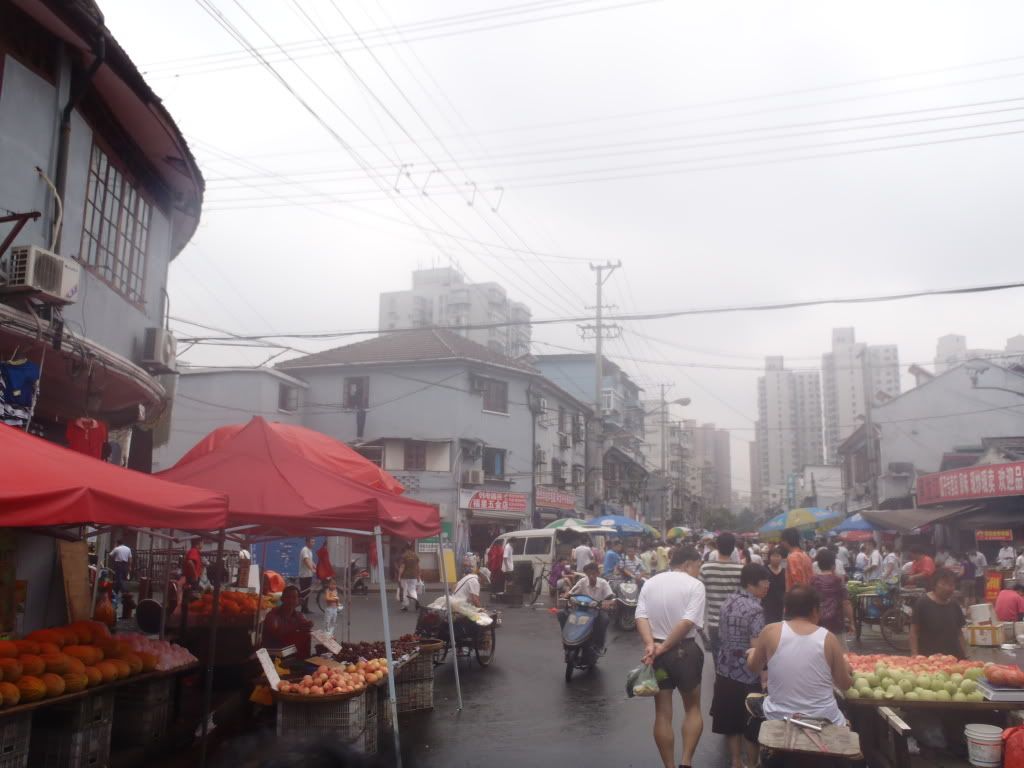
Luckily, everything worked out and we soon found ourselves comfortably sitting in the bullet train to Suzhou. It’s nice to know trains can safely reach speeds of up to 320 km/h. We arrived in Suzhou around 12:30 PM and looked for the ‘Left Luggage’ sign. It was a little difficult to find, as they’d hidden it just outside the station, but in the end we dropped our bags off and had our hands free to figure out just how to get to Tongli, our aim for that afternoon. We tried asking several people, but the information was limited and confusing. We decided not to risk it, and took a taxi to Tongli instead.
This turned out to be the right choice as the kind lady dropped us off right in front of the entrance to Tongli. Tongli, as we’d read, carried the nickname ‘The Venice of the East.’ It was described as a 1000-year-old, but well preserved water township. We had also read there were more Venices of the East in China, but a little research satisfied our curiosity and we’d ended up picking Tongli as ‘our’ Venice. We walked through the gate towards the town, where we had to buy entrance tickets (a through ticket for roughly 10 sites all around town) and chose to hire a pedi-cab, because we feared we might run out of time.
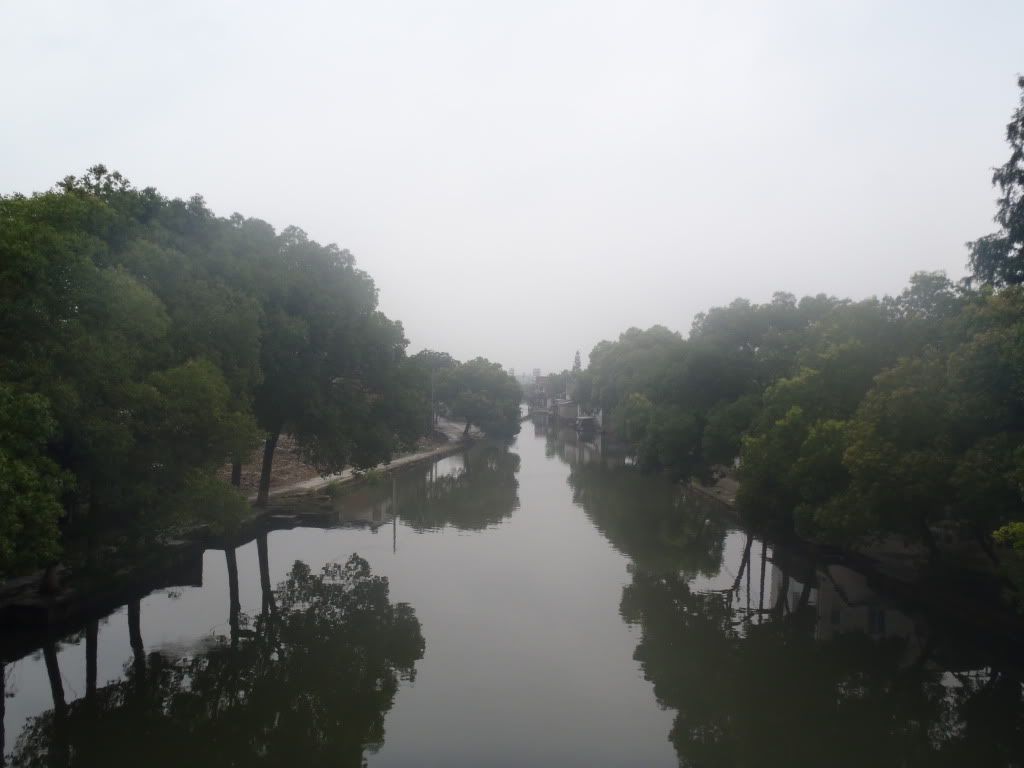
Our kind driver peddled away and soon arrived at the first sight: Gufeng Garden. The ticket allowed us to enter both the Garden and the Museum in the surrounding building. The Museum was mildly interesting, showcasing many different types of wooden and ornate beds and some carved wooden architectural features. The Garden proper was a nice sight to behold, with little pools of water and rock formations combined with lush greenery. We spent a while walking around, before returning to pedi-man who biked off with us to the next destination.
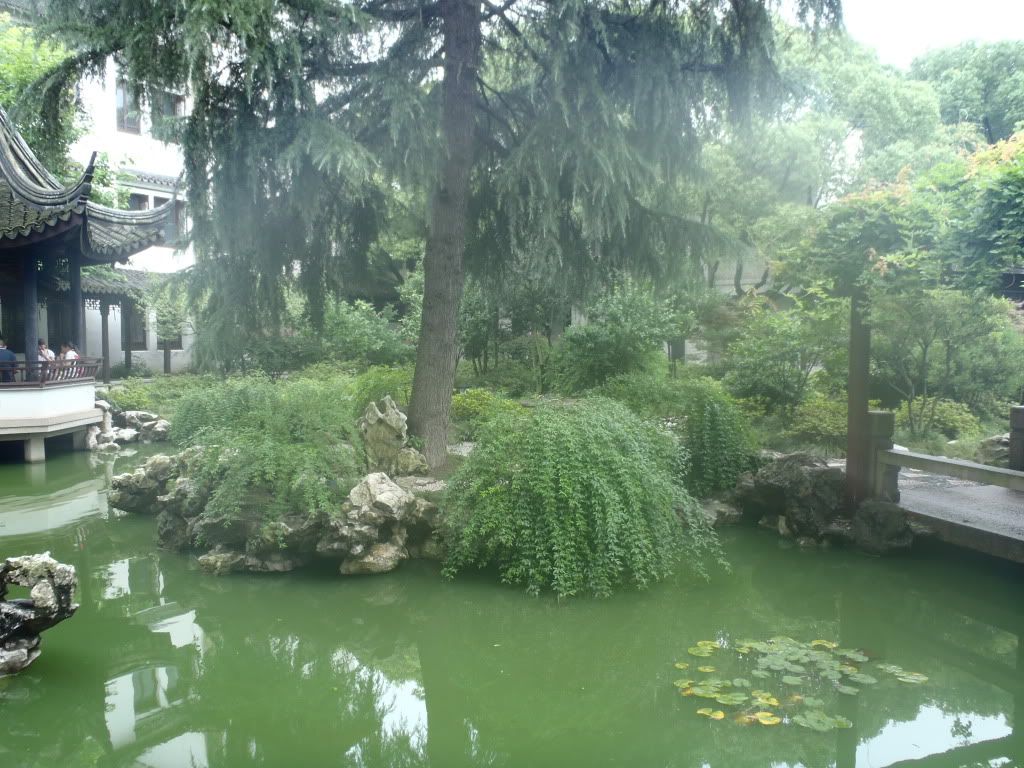
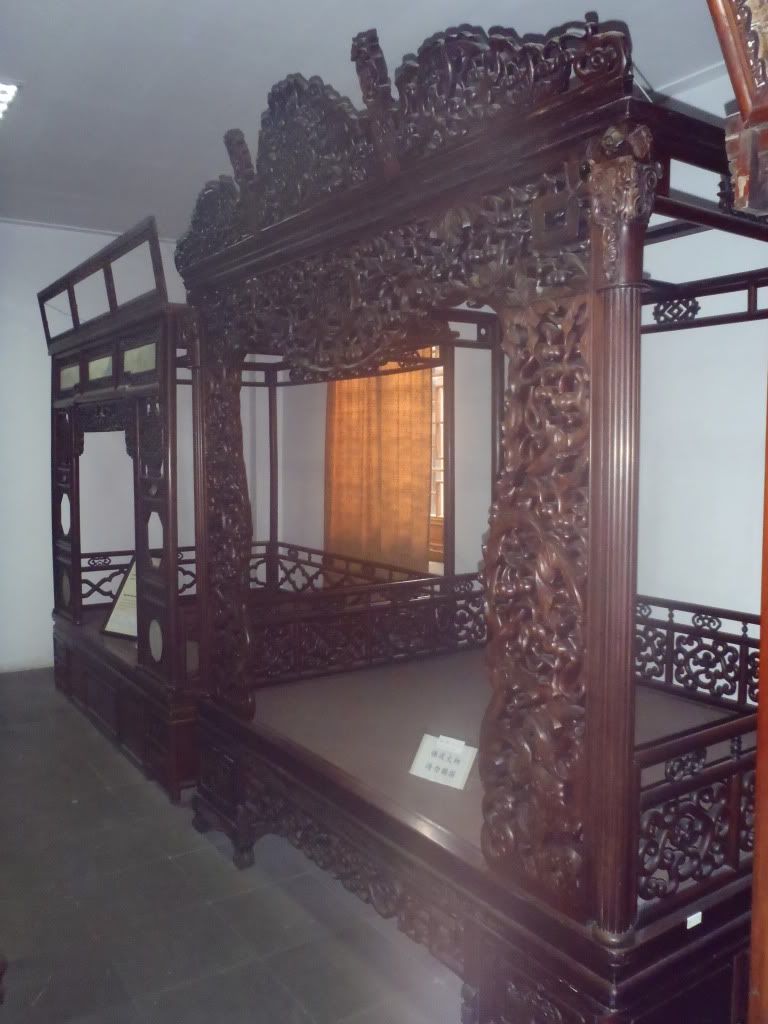

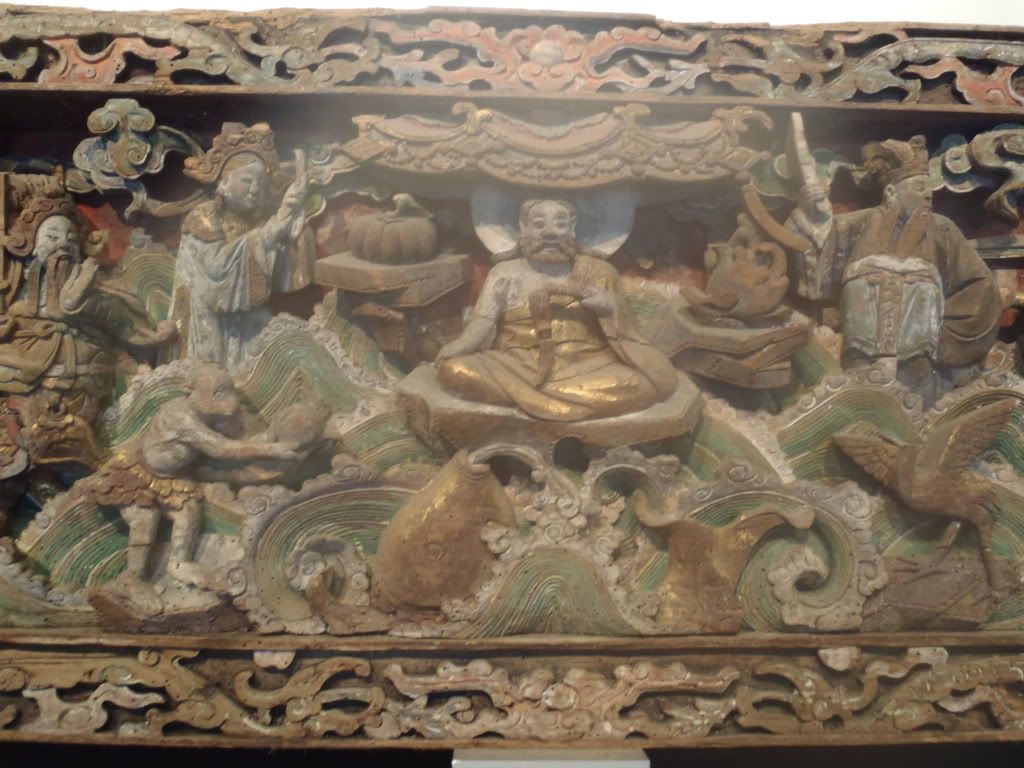
The Wang Shaoao Memorial Hall was a blatant example of propaganda for the Communist Party. Texts on the walls claimed the China Association for Promoting Democracy and the Party had always been able to work hand in hand, without any issues. Obviously, a little white lie… Other than a few texts combined with the busts of a handful of Chinese democrats, there was very little to see here.
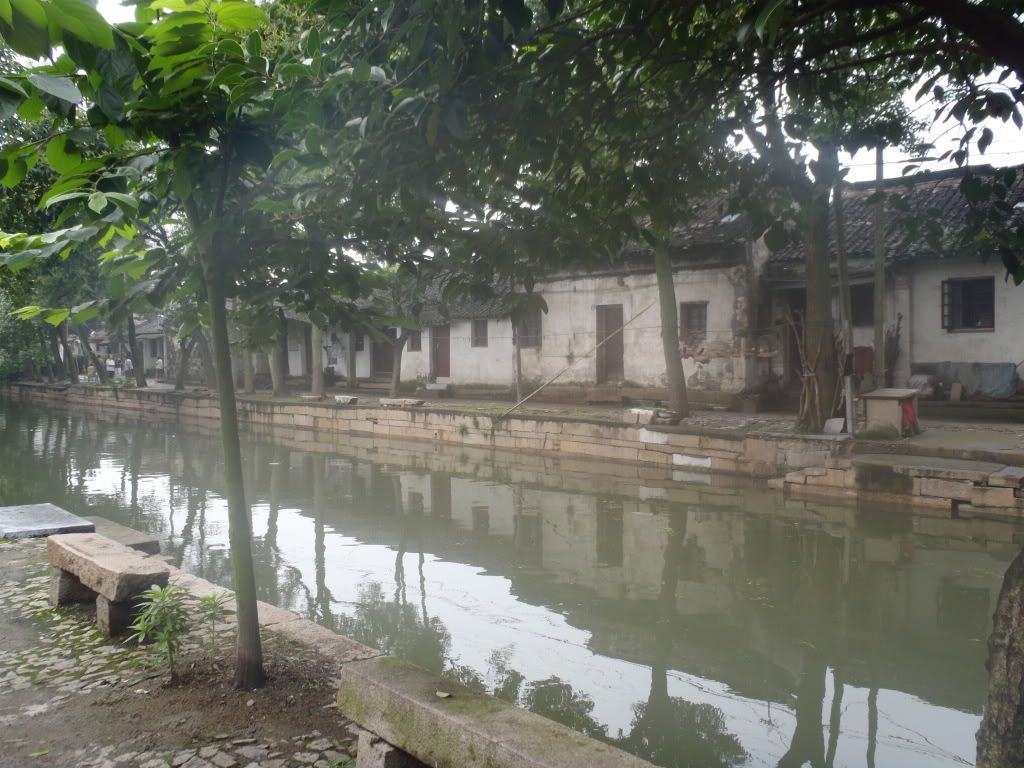
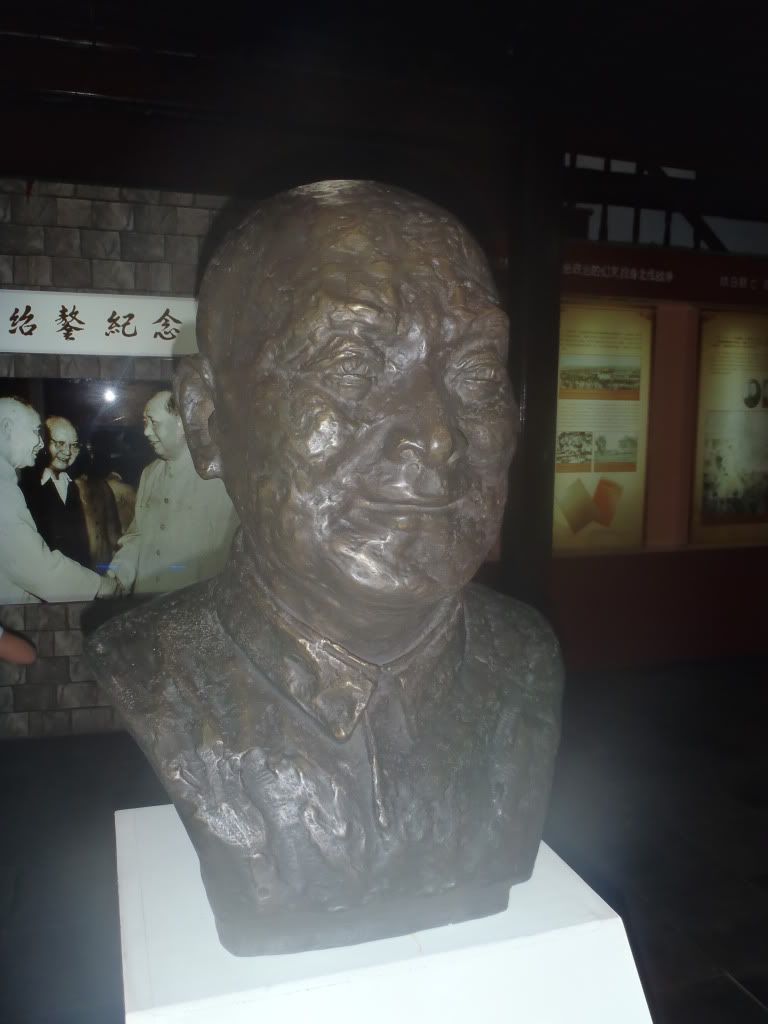
We moved on to the Pearl Pagoda and its garden, the largest of Tongli. We learnt of the myth of Fang and Chen. Here’s a summary of a little story I found online: Fang, a young man from a rich and powerful family became poor after falling out of favor with the royal court. He had to borrow money from his aunt in Henan Province, central China, but she scornfully taunted him. Fang's elder female cousin, Chen, had a kind heart and gave him the Pearl Pagoda, which had been the family treasure for many generations, to help him to go continue his studies. Three years later, Fang attained the top grade in the imperial examination and returned home. He disguised himself as a Taoist monk and sang a satire song to mock his unkind aunt. He eventually married Chen. Now the Pearl Pagoda is the reproduction of the pagoda from the story.
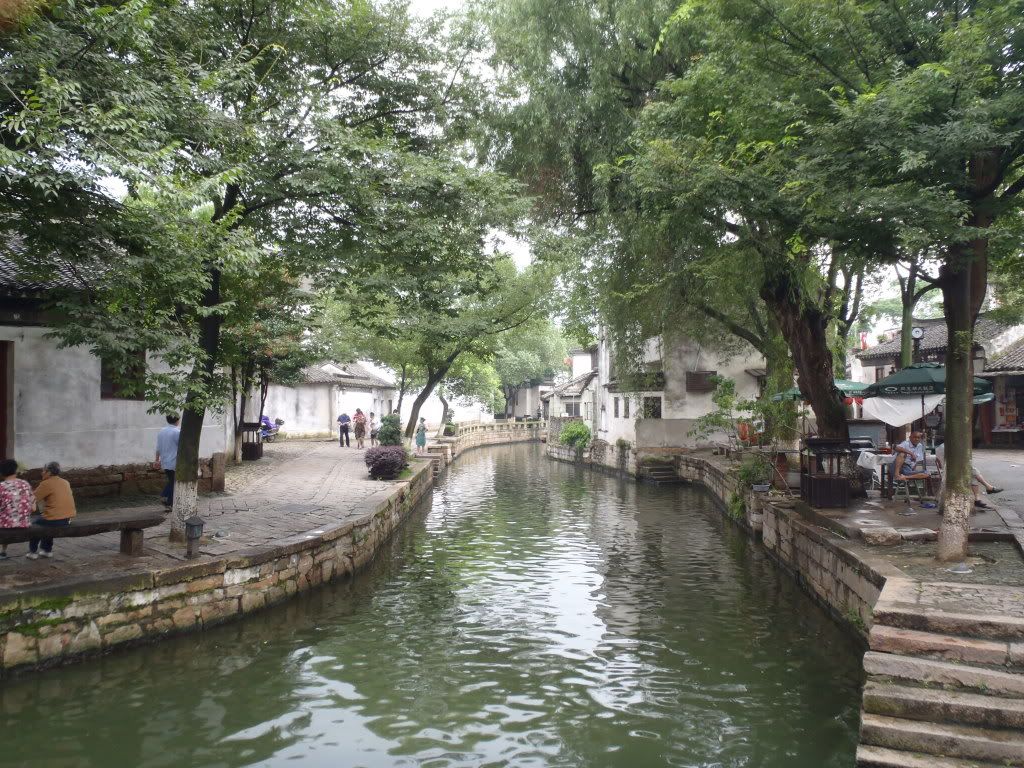
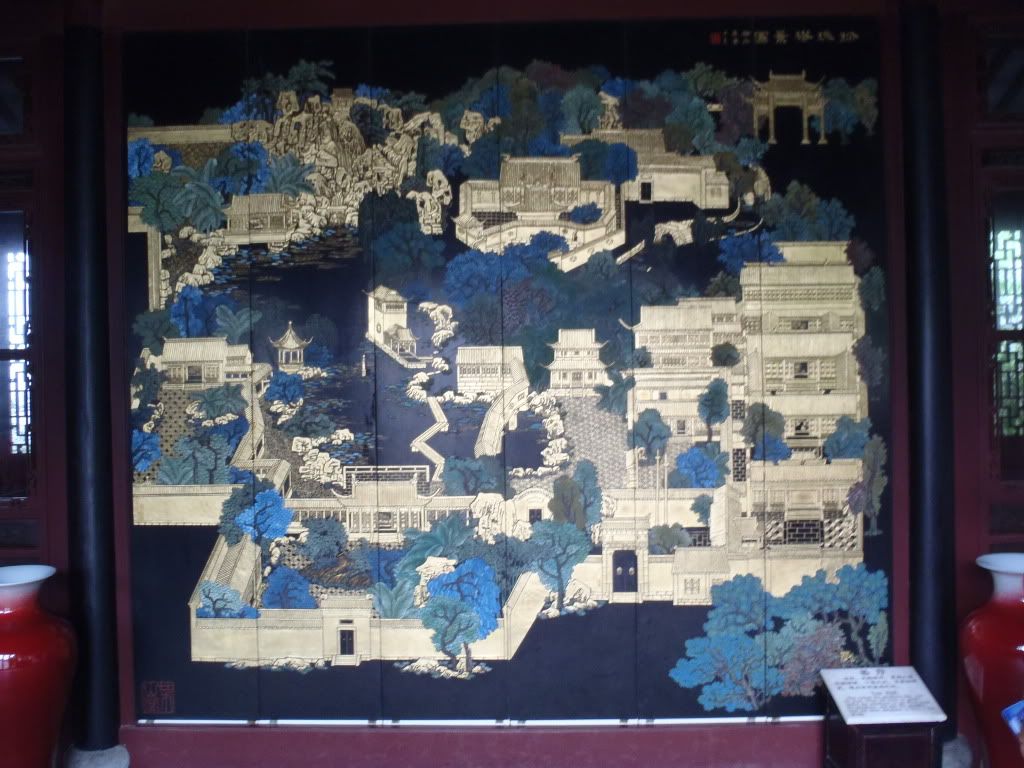
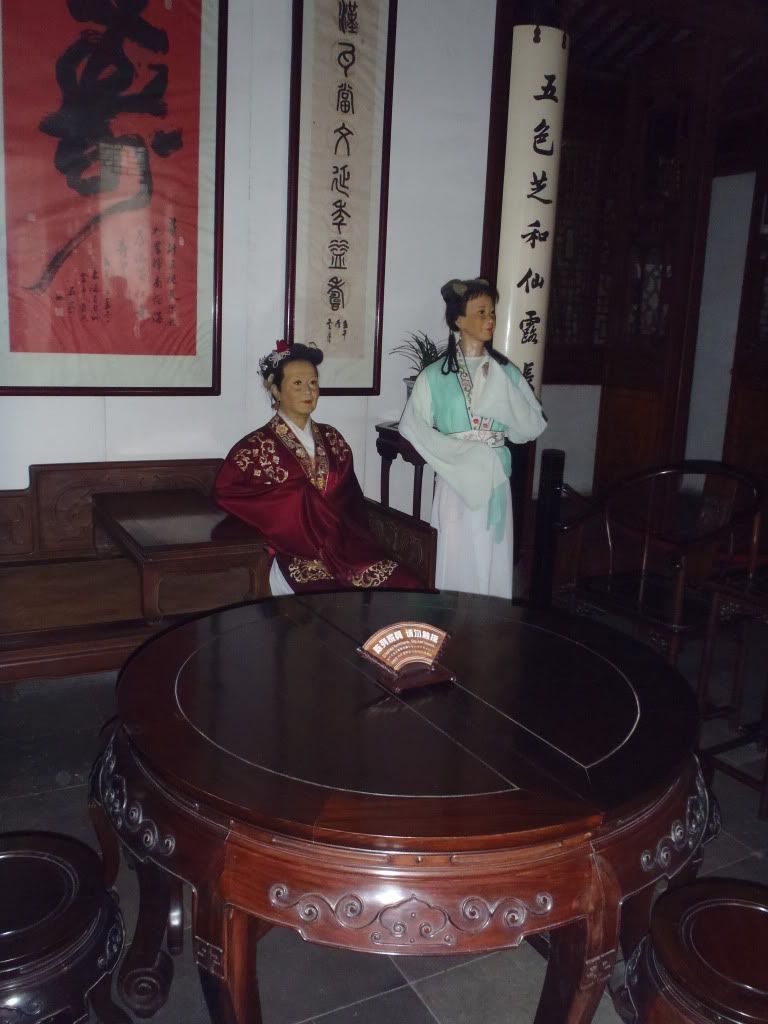
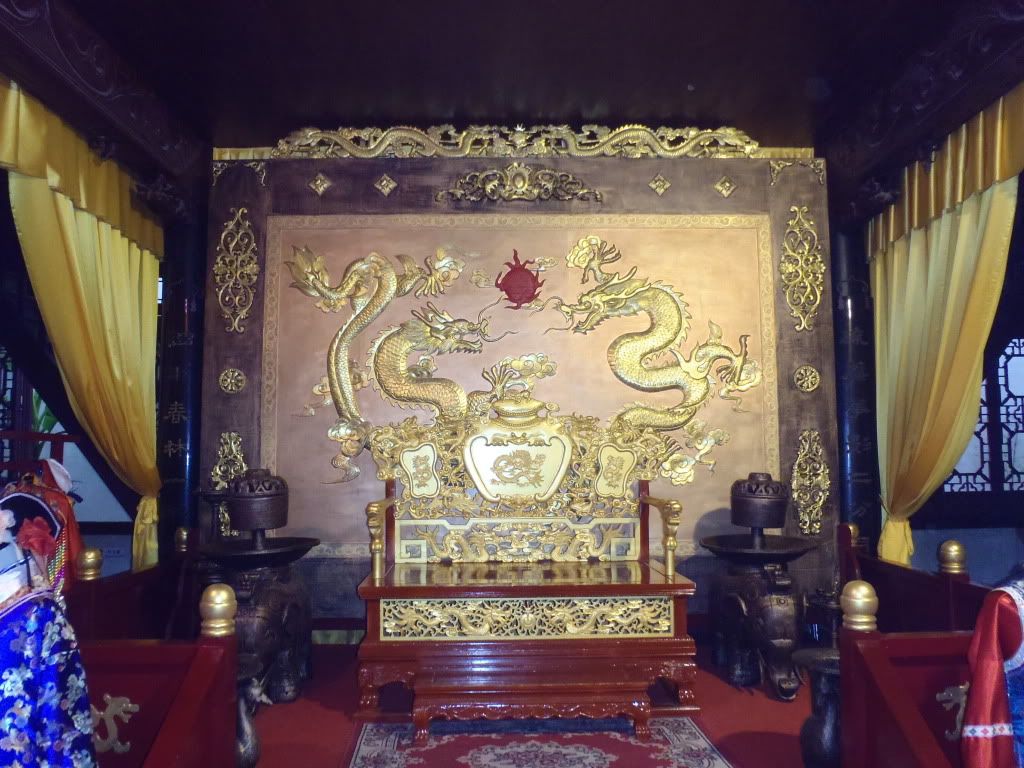
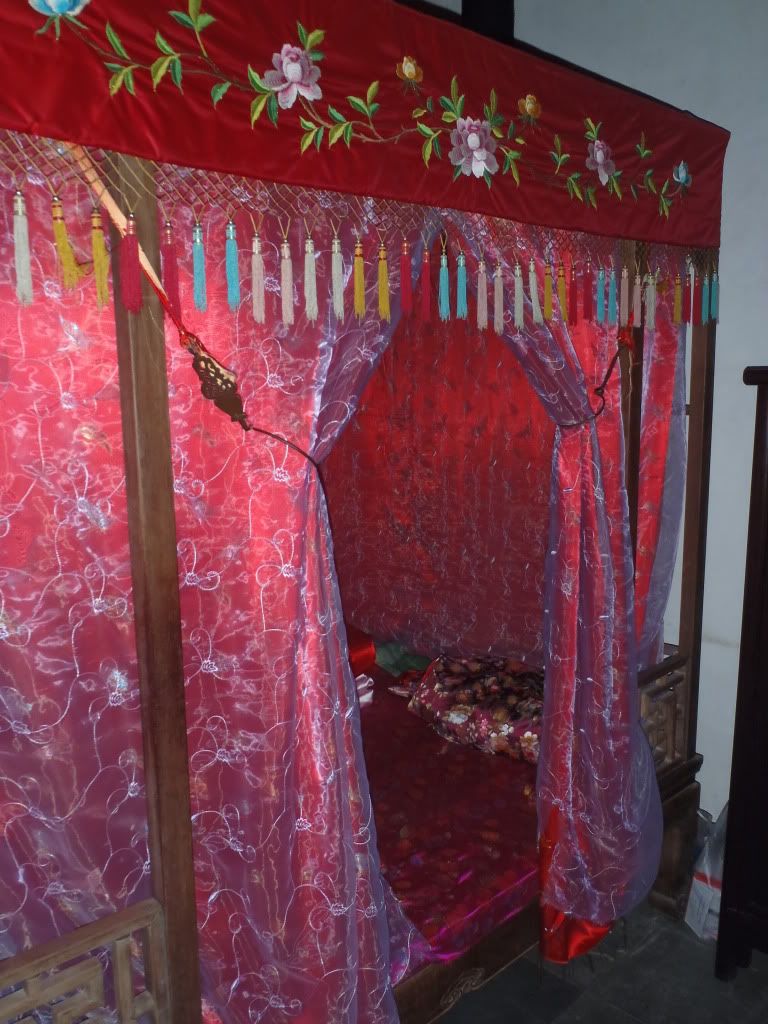
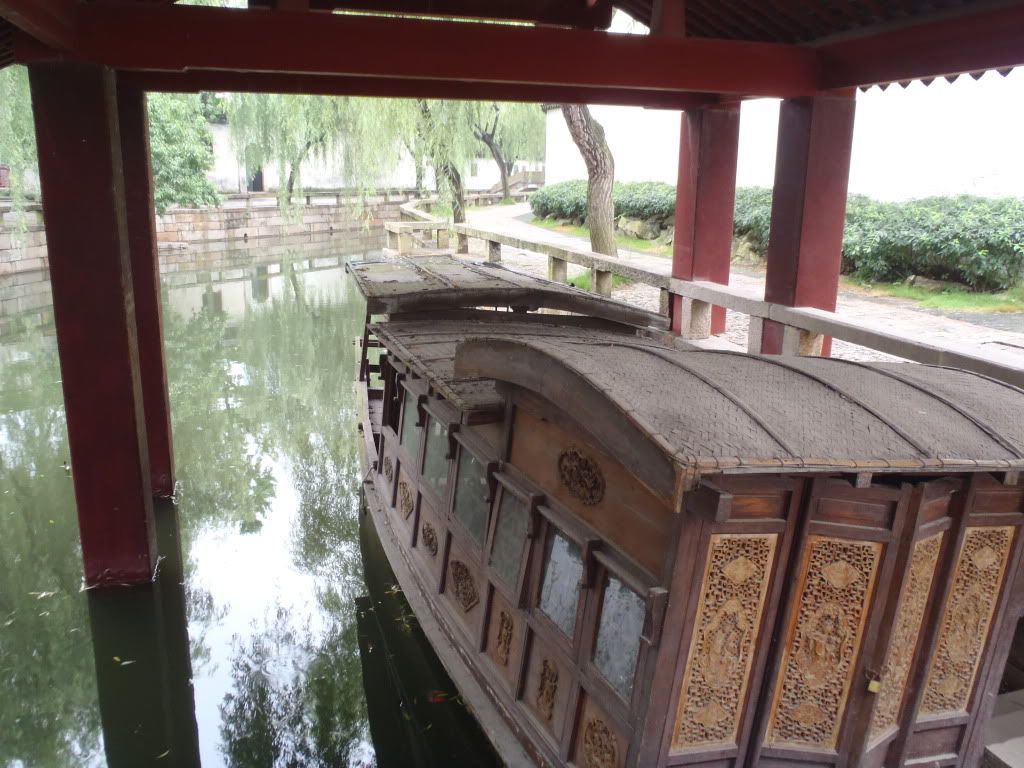
Other than the pagoda, the garden had an impressively large house. The house consists of many different rooms, all connected with little open spaces. Every room has a different function, which we guessed would mean some of the inhabitants had to spend quite a while getting from the living rooms to the kitchen. We walked around and checked out most of the rooms. We ended up near a large pond, where some kids were feeding the fish in the water. The frenzy was quite spectacular.
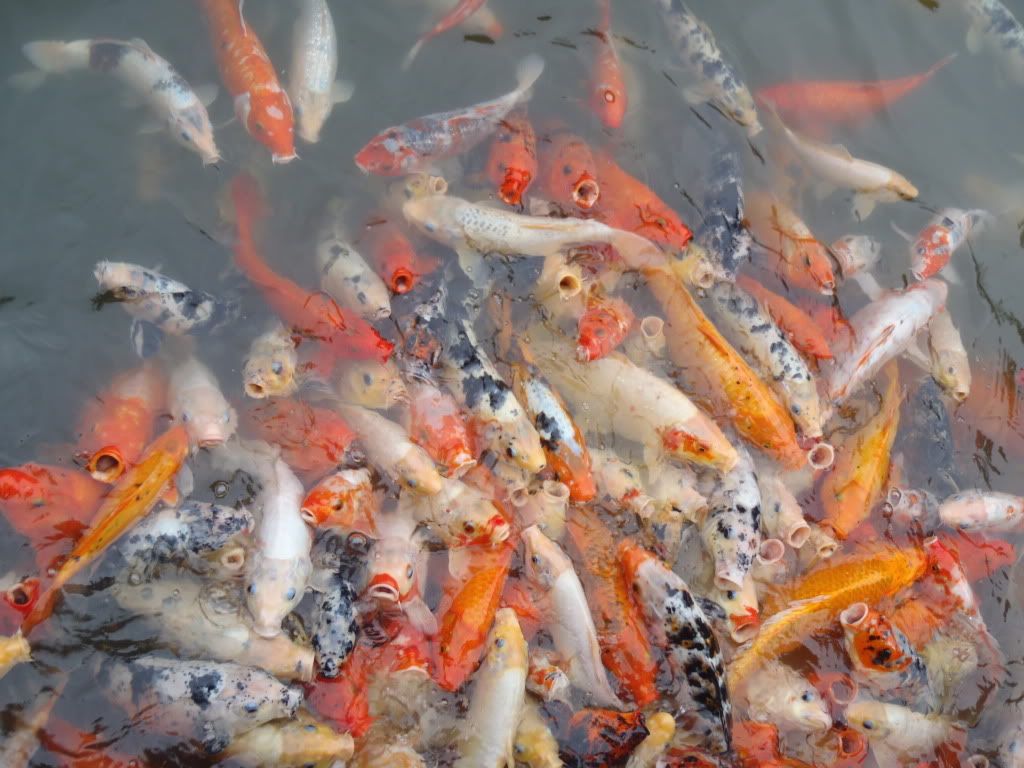
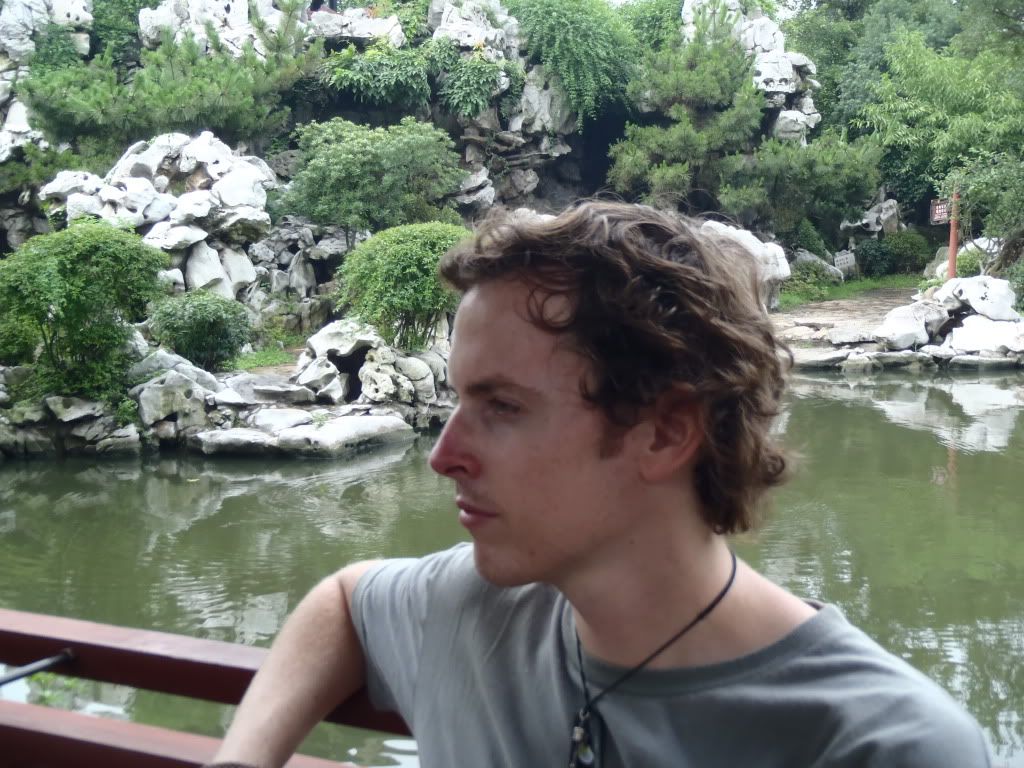
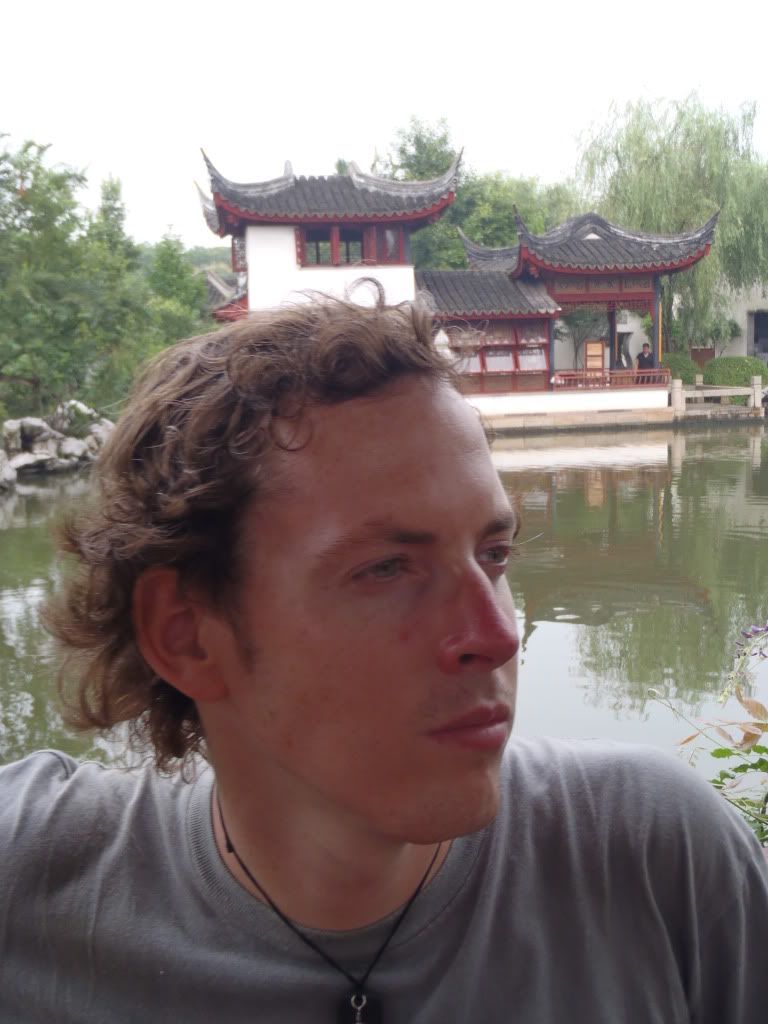
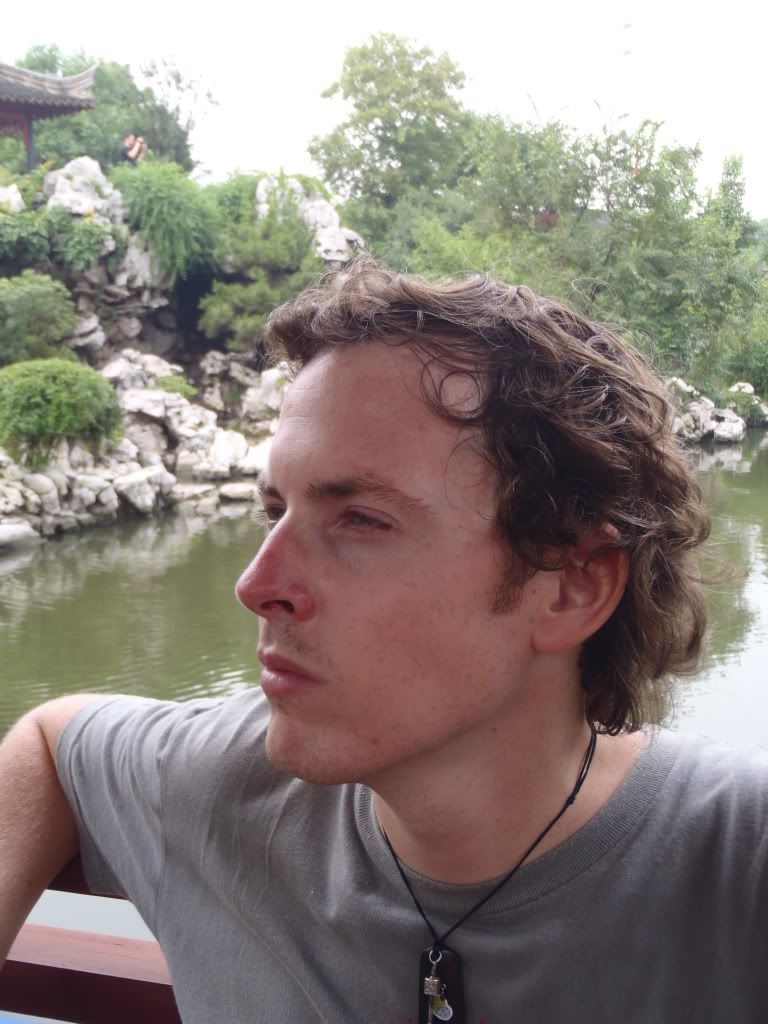
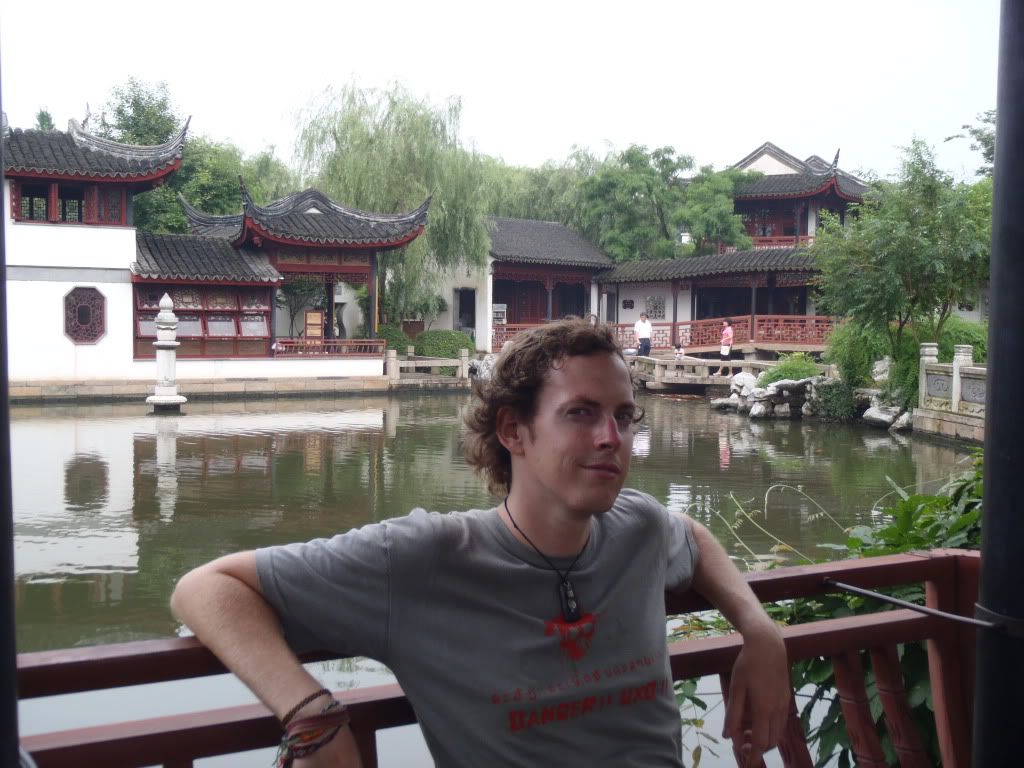
Next up: the unimpressive Wu Garden, with a bunch of halls filled with strange art. We managed to get through the rooms, but we didn’t stay long at all. Happy Farming Hall was “… built by Ming Dynasty official Zhuxiang, also called Gengle, as a quiet retreat after a successful career in government. So pleasant was his home that he seldom left it, earning him a reputation as a hermit, albeit a hermit with a 54-room mansion to hole up in. Today, the house retains three courtyards and 41 rooms out of the original layout. The front living quarters lead to a small garden area with a lotus pool. An adjacent zigzag bridge connects to a pavilion.”
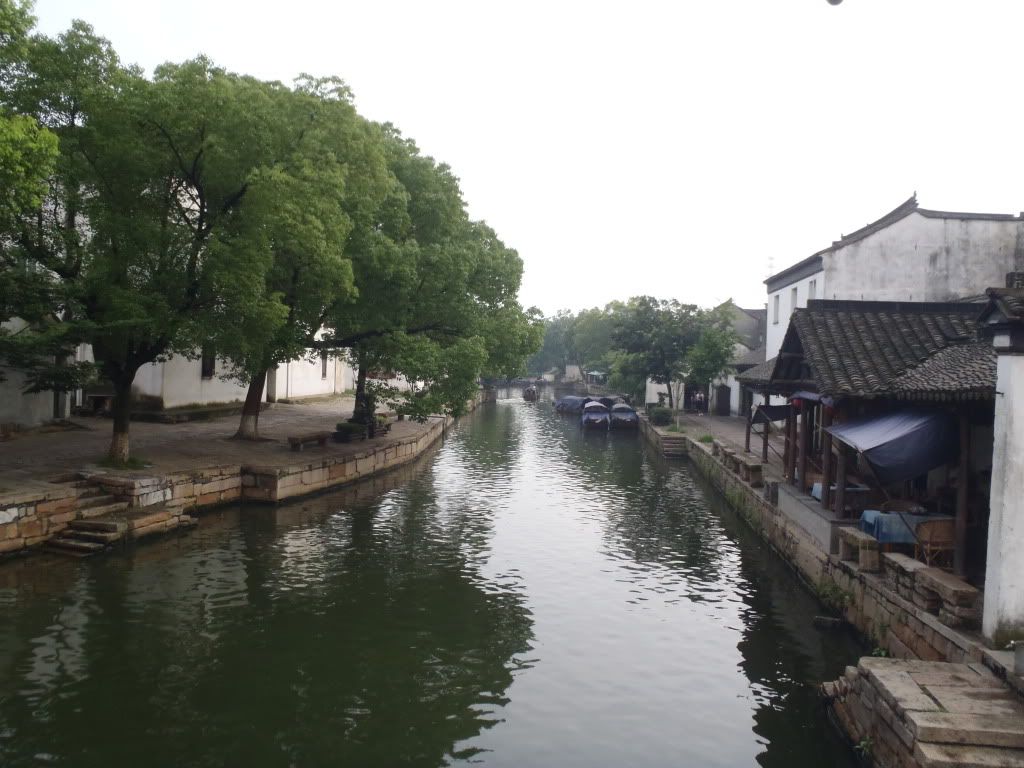
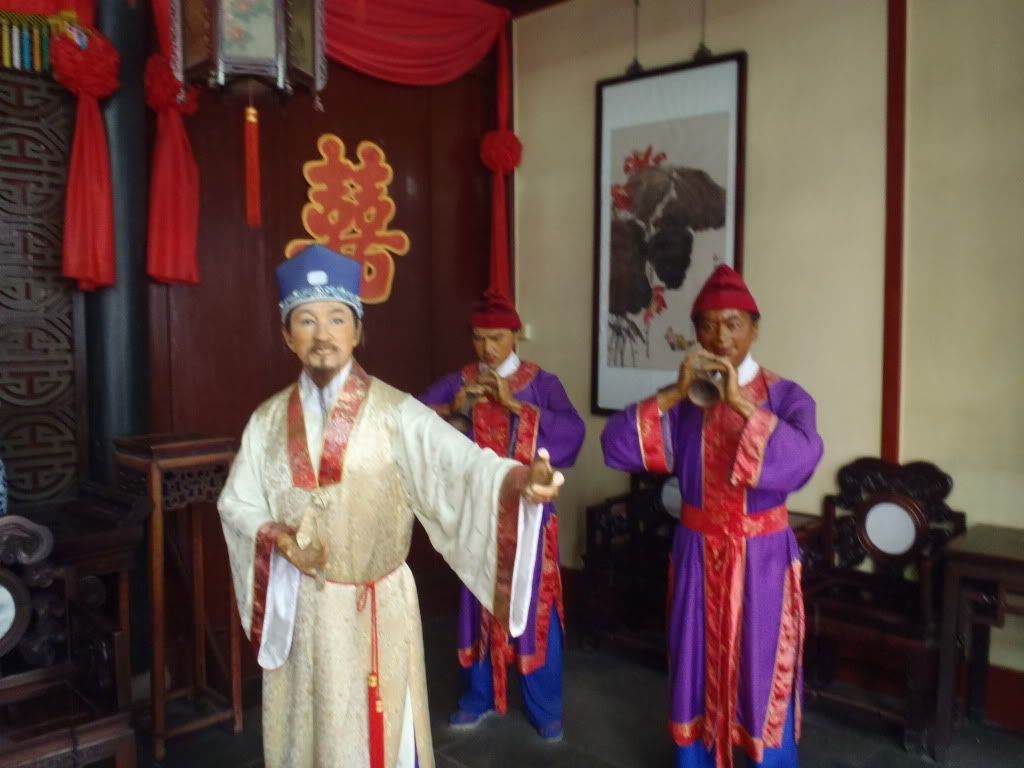
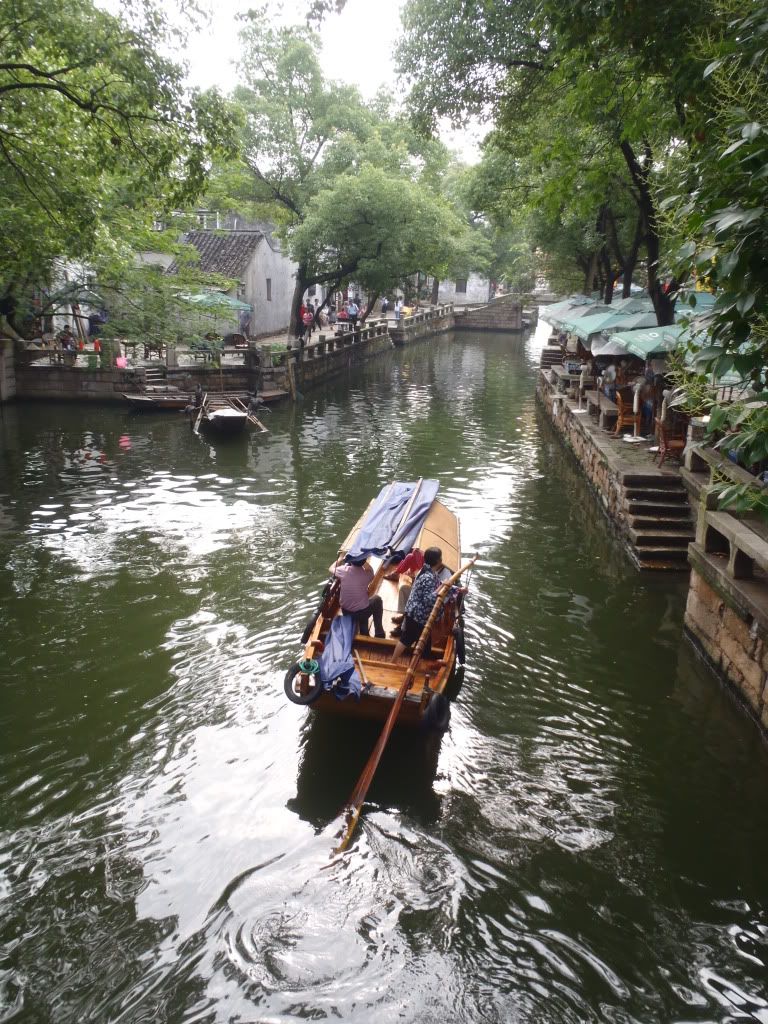
Once outside pedi-cab-man took us to Three Bridges Viewpoint. The Bridges represent good fortune and happiness and are an important part of the Tongli people’s daily lives. They’re still incorporated into daily affairs as well as special occasions, such as weddings. After that we were dropped off at The Retreat and Reflection Garden. Here’s a little more information from virtualtourist.com: “The Retreat and Reflection (Tuisi) Garden, was designed by a famous painter, Yuan Long, during 1885 and 1887 and is the most spectacular in Tongli. Its name is derived from an aphorism expressed in a very famous biography called Zuo Zhuan written by Zuo Qiuming in the Eastern Zhou period (770-221 BC): 'Forward to be fully loyal, and retreat to reflect fault'. The ingenious design for the garden conforms to the local landforms and conditions and covers about 700 square meters. Compact and harmonious, the garden is in two parts. The residential area to the west consists of an outer house and inner house including the sedan hall, the tea hall, a main reception hall and two buildings forming the actual dwelling. The garden in the east has ponds, marble boats, waterside pavilions, halls, kiosks, verandas, rockeries and bridges.”
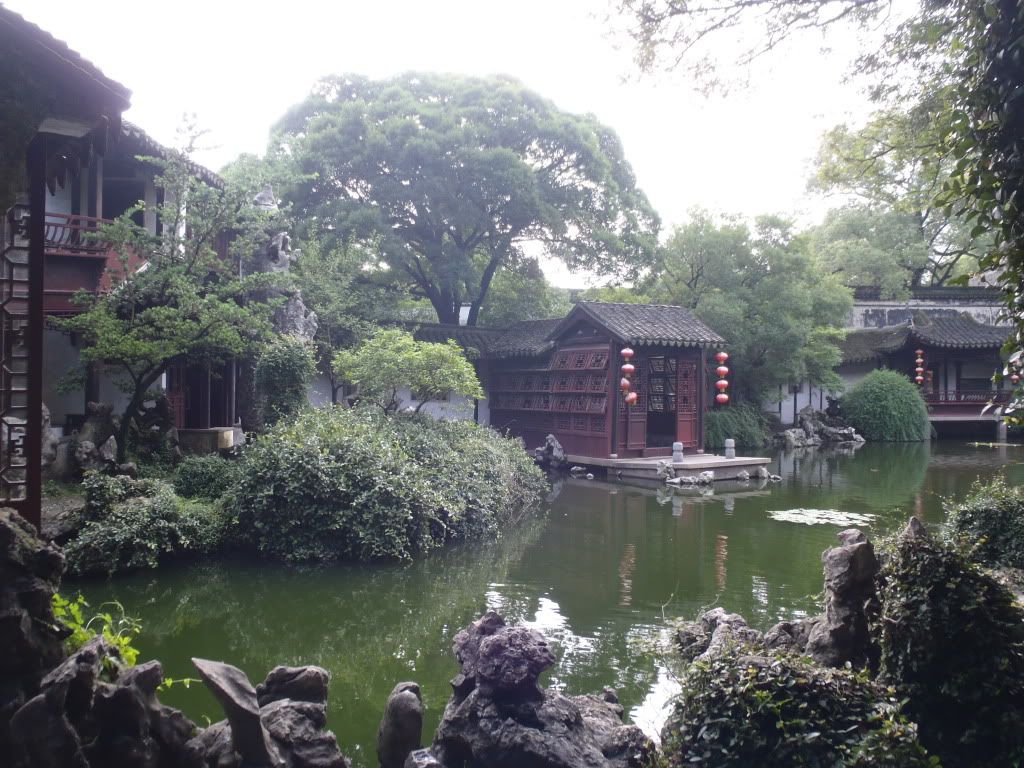
The Garden was the nicest garden that we visited that day for sure. Unfortunately, we didn’t have much more time left since closing time was approaching and we had one more important stop we really didn’t want to miss: the Sex Culture Museum. The museum had moved from Shanghai to Tongli (for reasons unknown) in 2004. It is the first and only museum of its type in China and exhibits over 1,600 items of sex culture from as long ago as 9,000 years to the early 20th century in four parts: ‘Sex in Primitive Society,’ ‘Marriage and Women,’ ‘Sex in Daily Life,’ and ‘Unusual Sexual Behavior.’ We had a look at the rather graphic and sometimes downright bizarre statues in the little garden, before entering the first hall.
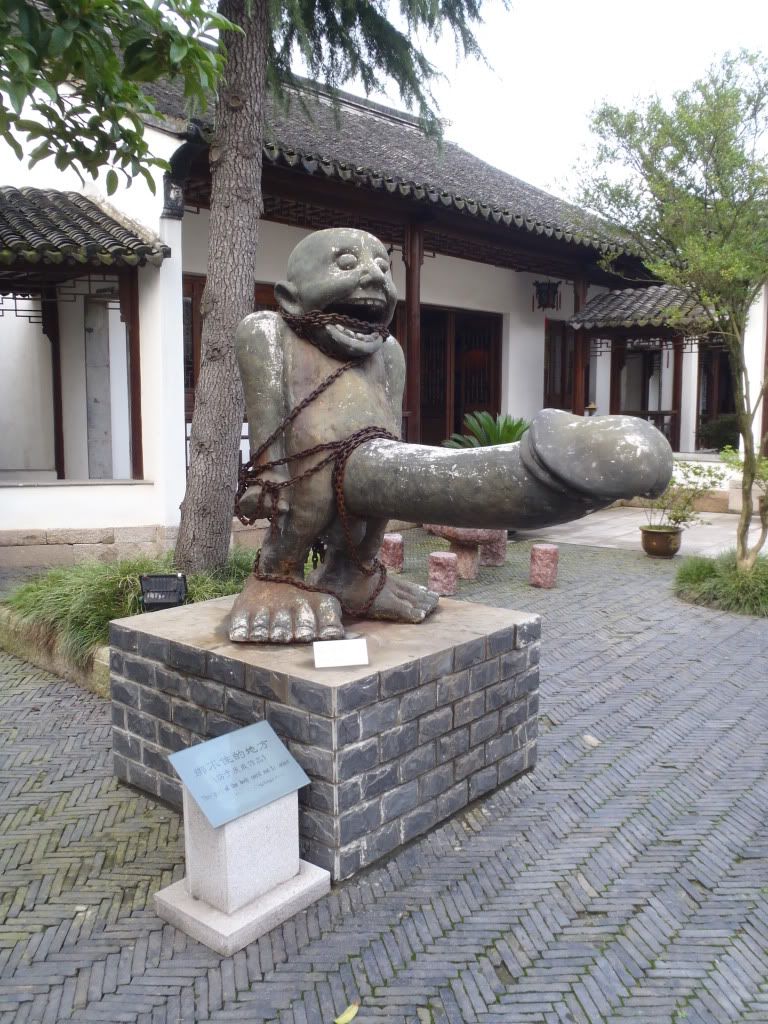
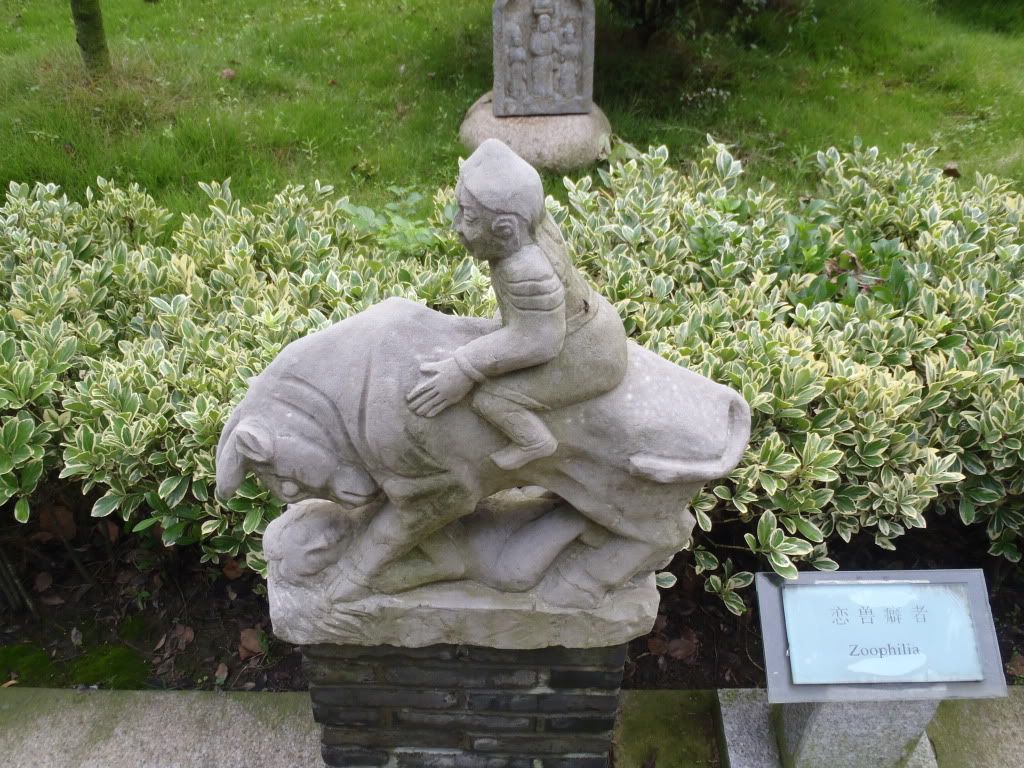
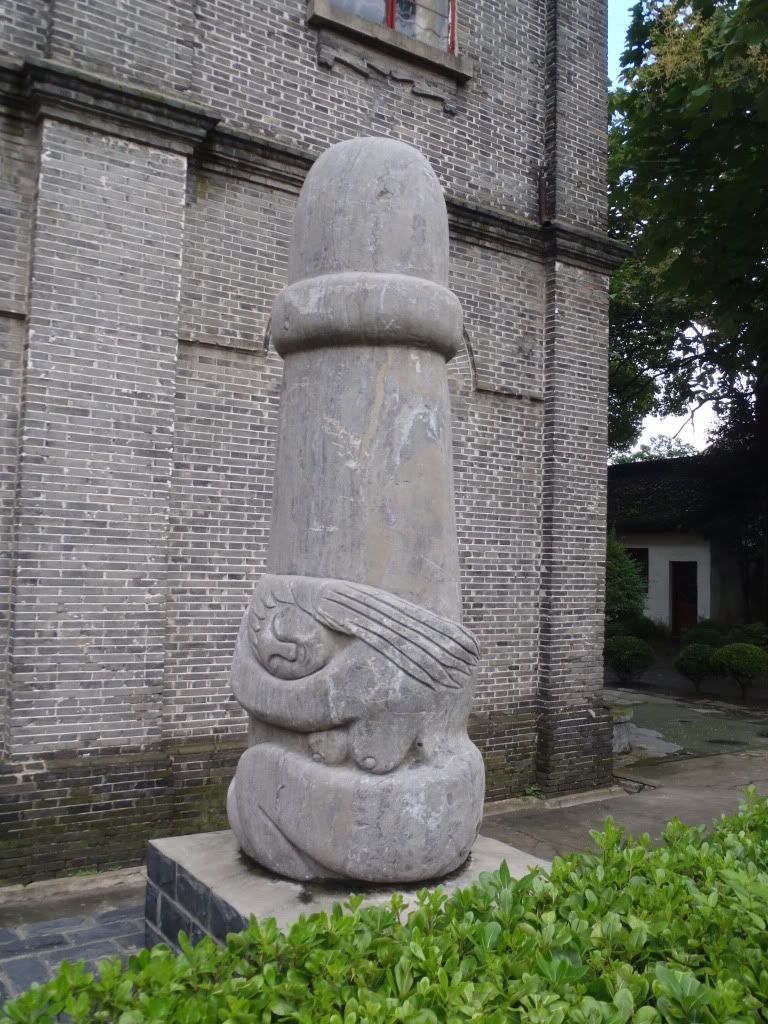
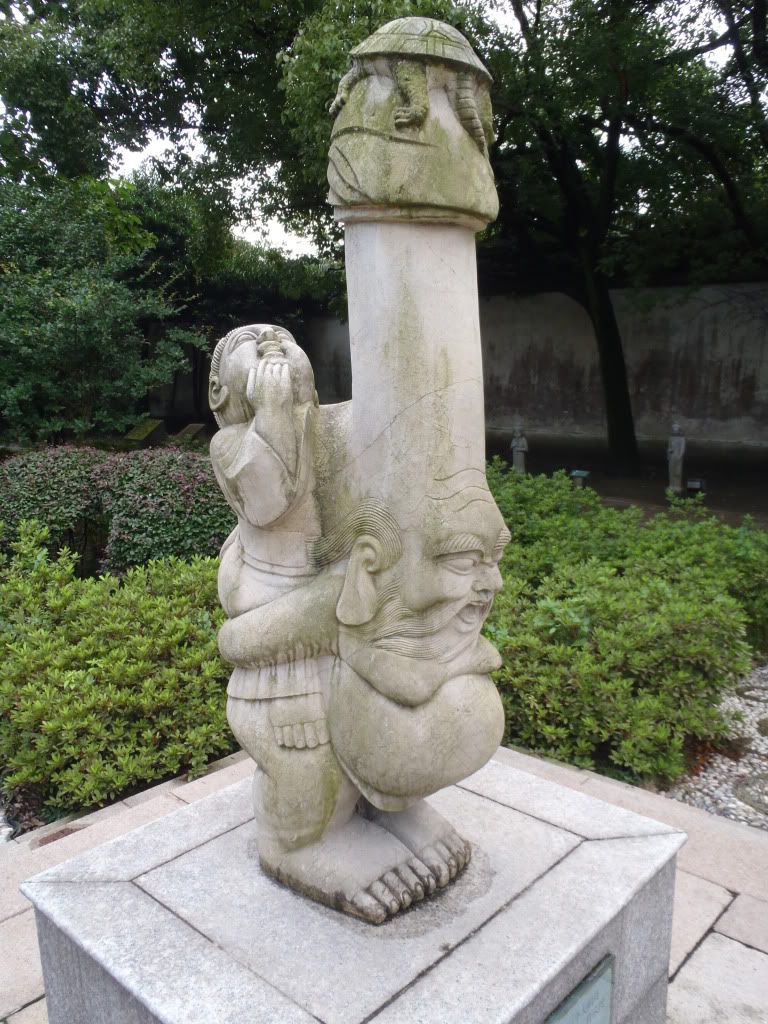
We were surprised to find a small piece of pottery dating back to roughly the 2nd century B.C. that showed people back then were just as preoccupied with sex as people today. We also learnt about Fuxi and Nuwa, the legendary ancestors of the Chinese people. Apparently, this brother and sister were also a couple, which indicates incest was considered okay around the time the statue was made (1st/2nd century B.C.).
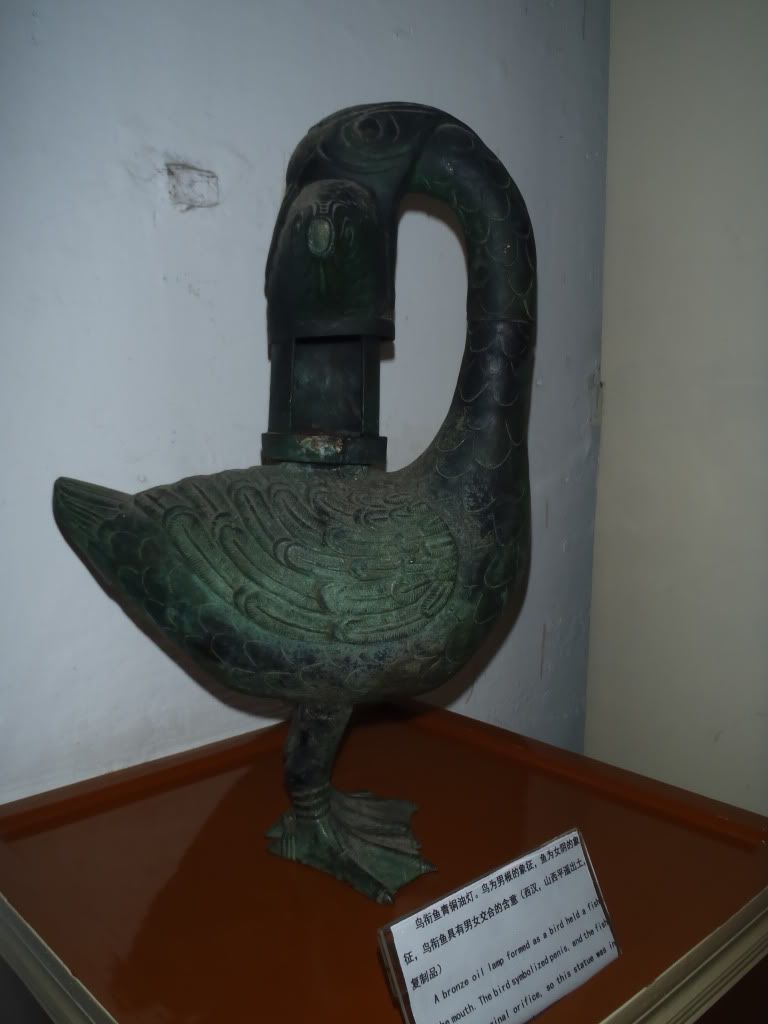
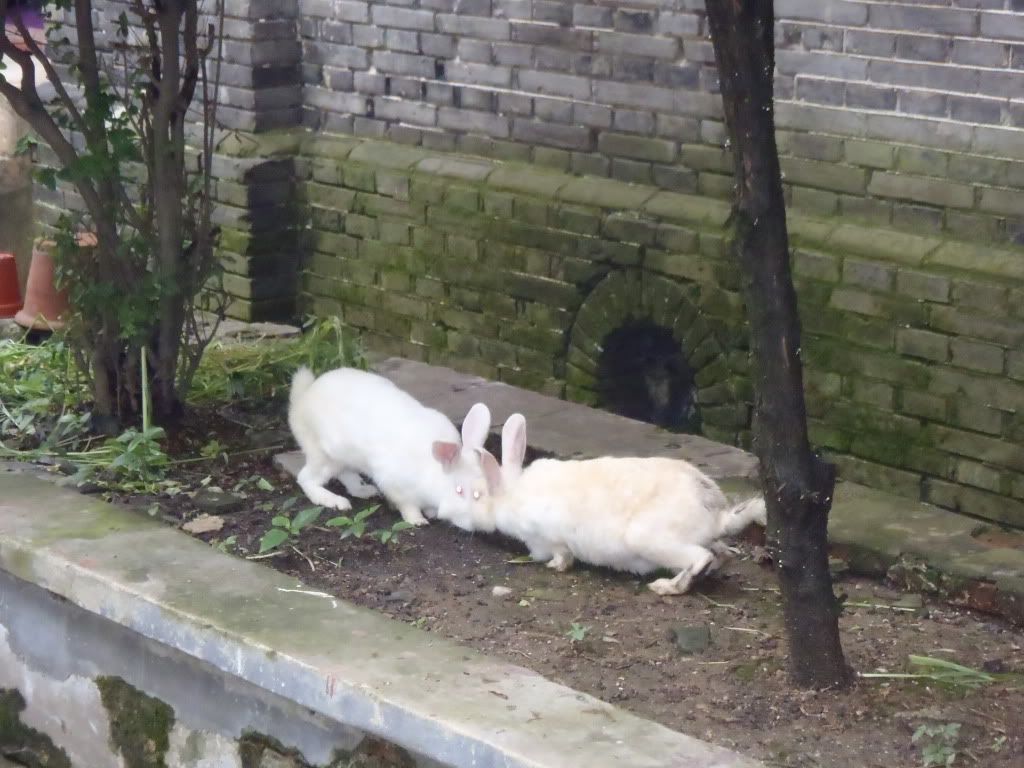
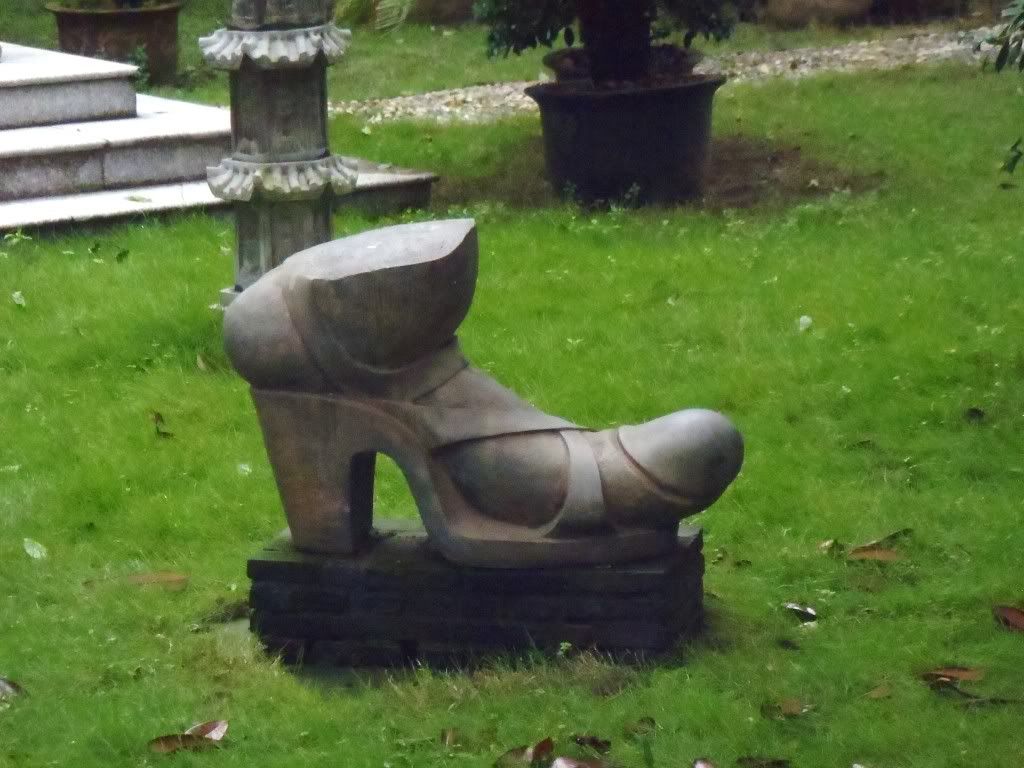
In the following hall we read about General Wu Sangui, from Yunnan province. His army successfully defeated the Ming, but after the war ended his men had a hard time finding Han wives. To encourage the Han soldiers to marry women from minorities (which had been a social no-no up until then) he had vases made with copulating fish of different species on them. We also read about prostitution in the 17th century, when pictures were not yet available. Instead, hungry customers could pick their favorite from a set of drawings.
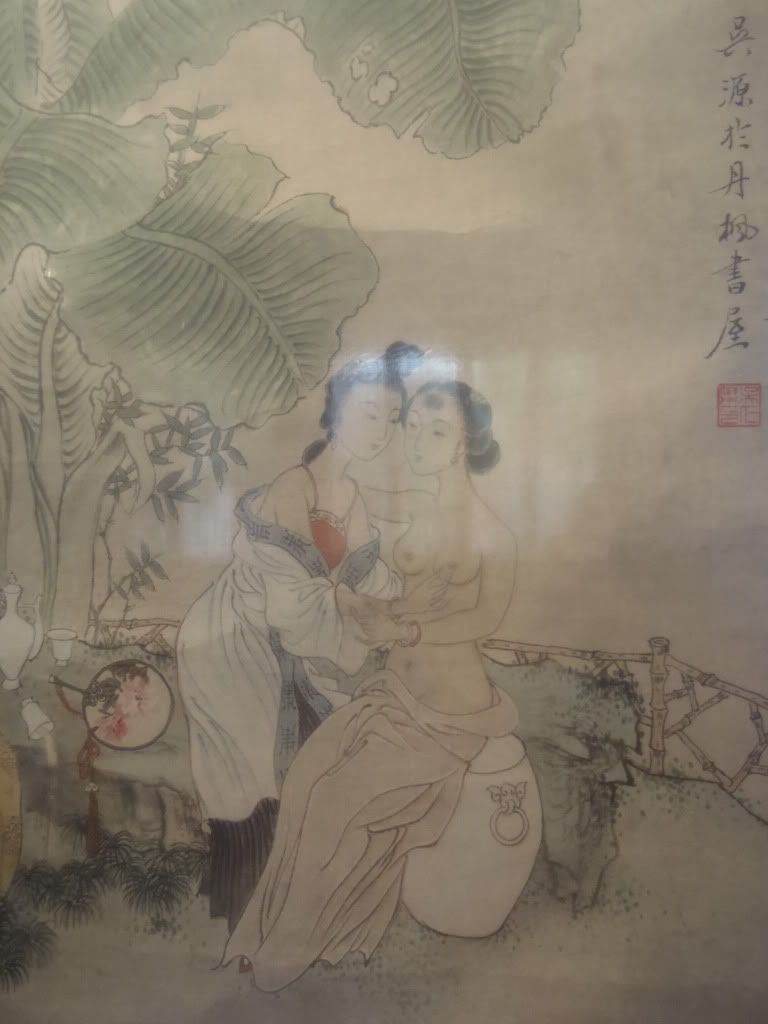
Sex tools were also widely present in the museum. We saw a whole variety of dildos and other items used for insertion. We learnt that many women had them, as many of them were concubines of men with harems. They wouldn’t get a lot of attention, so they had to take care of themselves. We had to hurry a little through the remainder of the museum, but we were left with a memorable quote: “Any sexual phenomenon, as long as it is ‘voluntary’ and ‘non-damaging’ (causing no damage to others and society), should be allowed to exist.” That was a refreshing statement, especially in an otherwise narrow-minded China.
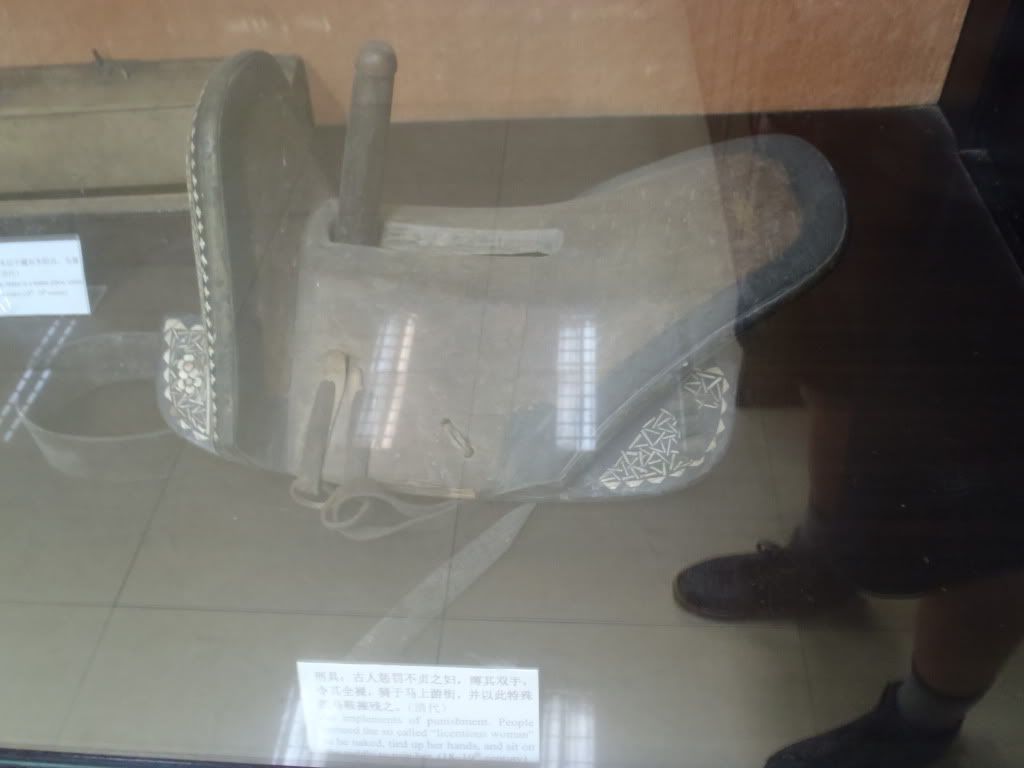
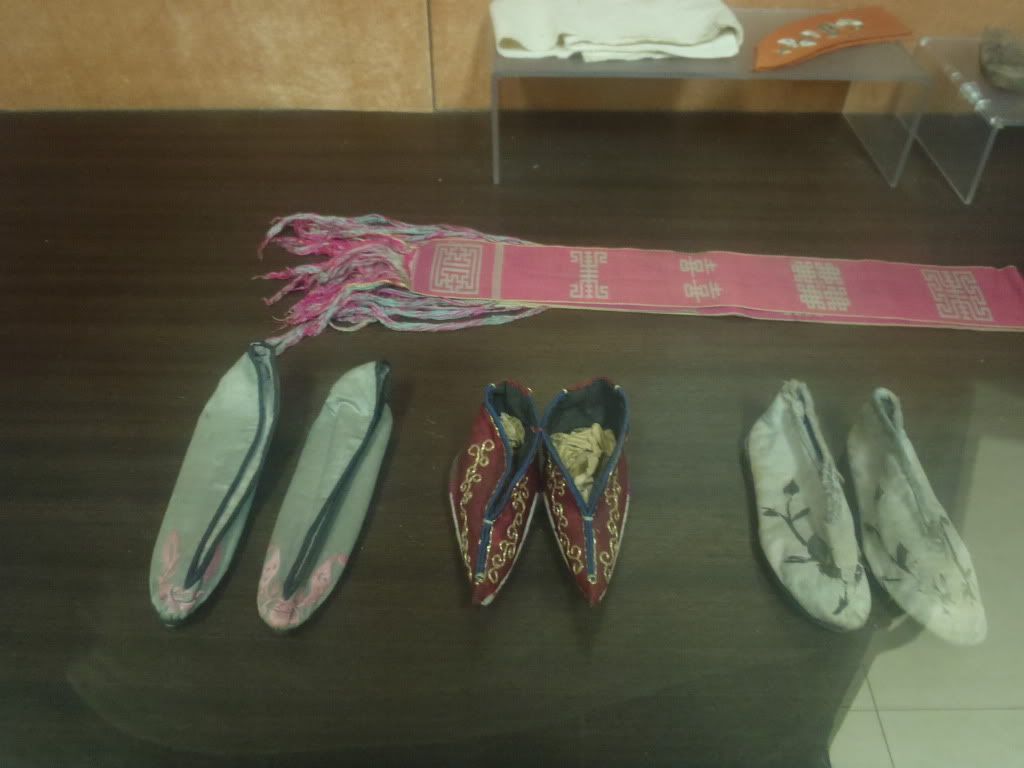
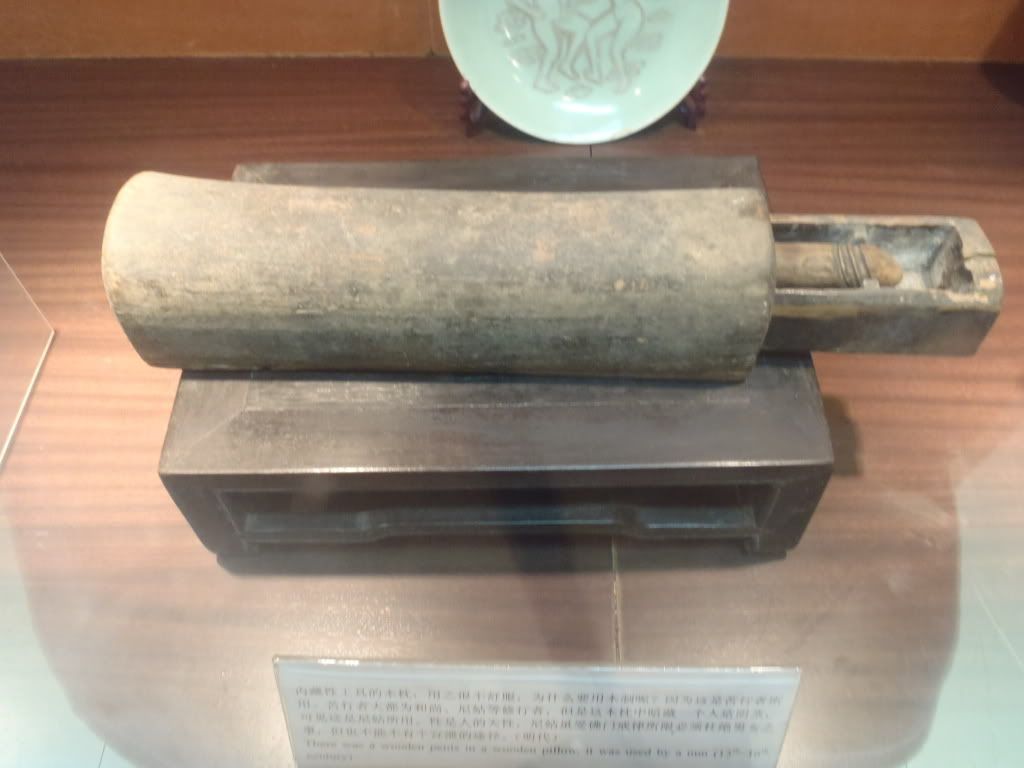
Around 5:00 PM we headed back towards the entrance gate, quickly having a look at Chen Qubing’s House. The old house itself was only a little more interesting than the man’s life (he was a poet during revolutionary times) and Francesca walked around for a while to check the house out, after which we made our way to a taxi, which took us back to Suzhou’s station. We had to sit around for a while to wait for our train and took the opportunity to scrape a meal together. We bought some bread, meat-sticks, chips and drinks, as well as some insta-noodles for me, which we ate before the train arrived. Luckily the train only took one hour (bullet train!) and we arrived in Nanjing around 9:30 PM. We still had to make it to our hosts’ place, which we had written down in Pinyin. We tried in vain to get someone to write it down in Chinese, and ended up just taking a taxi, hoping they’d get it right.
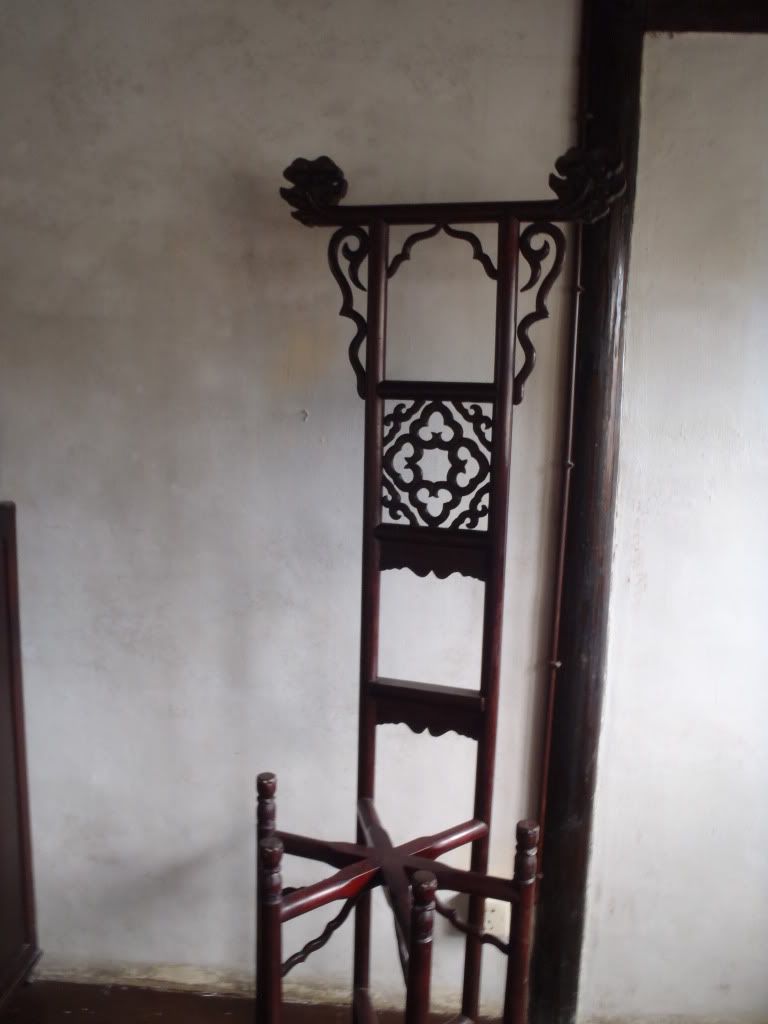
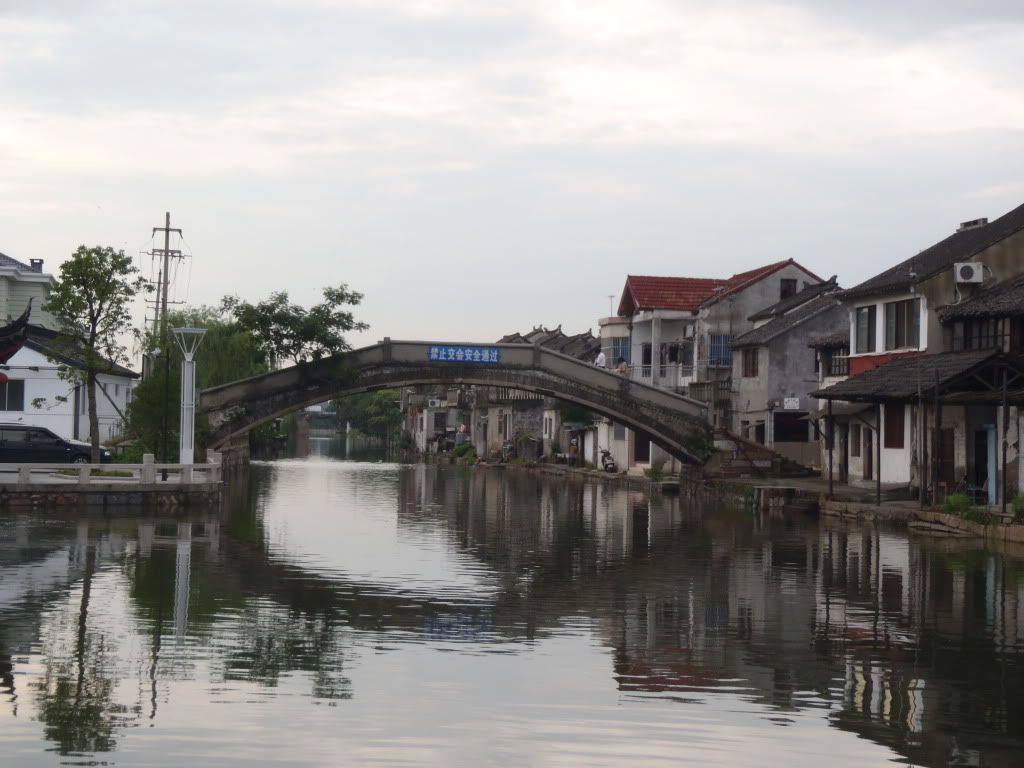
The driver knew ‘Masterland,’ the gated community we had to go to, and all we had to do is talk to the guards to find the right address. I’d been looking at the hosts in Nanjing and I’d fallen in love with our new hosts’ profile, so I was really excited to finally get to their place. Outside of their place we met Gert van der Merwe, who took us inside. We quickly put our bags down in the basement and headed upstairs to meet the rest of the family: Beppie, the mother, little Gert, his big sister Aletta and their awesome cat Koos. The Van der Merwes are a South-African family that has been living in Nanjing for a few years, since Gert holds a job with Ford USA. We talked a little about our travels and adventures of the day, but it was late and everyone was tired, so we made our way back to the basement and slept like babies.
The following morning, on the 16th of July we did get to talk to the family. Beppie was going to the city and taking the kids with. She dropped us off at Andemen Station, where we took a train to the heart of the city: Xinjiekou. We wanted to look for new shoes for Francesca, because with all the rain China had turned into a slip and slide for her and her inadequate sandals. We had a look in one of the malls, but found the prices quite steep. I knew there were some shops down in the subway station, but before we headed there Francesca needed to refill her Pizzahut-tank. The personal pan cheese pizza (after trying to explain for a long time what we wanted) hit the spot and recharged her batteries. The one shoe store down in the basement had a poor collection and just when we were about to give up Francesca spotted some cool new sandals. They weren’t expensive either, so they ended up on her feet soon after.
Finally being able to walk again made all the difference! We could walk on the previously slippery stones without any problems. I got us a taxi to take us to the Nanjing Massacre Memorial Hall, a place Francesca had told me a little about. I, however, was not prepared for the wave of information about to hit me. The complex looked extremely serene and there were only a few small memorials that gave away a little about the drama that had taken place here. A giant cross commemorated the “300,000.” 300,000 what you ask? Well, the sign told us this: the cross symbolizes the fall of Nanjing on December 13th 1937. A second inscribed date says January 1938, the end of the Nanjing Massacre. Then the most shocking line of all: “The memorial has been built above the site of ‘the Mass Grave of 10,000 Corpses.’” We walked past a wall of unsettling sculptures and carvings and ended up inside a building.
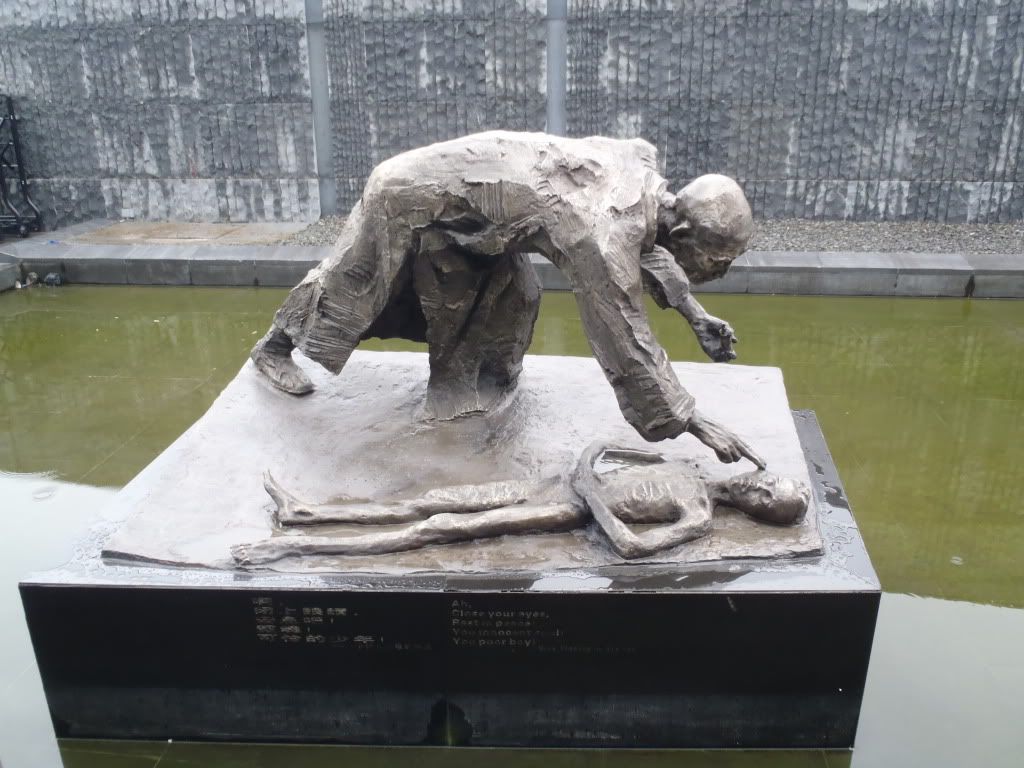
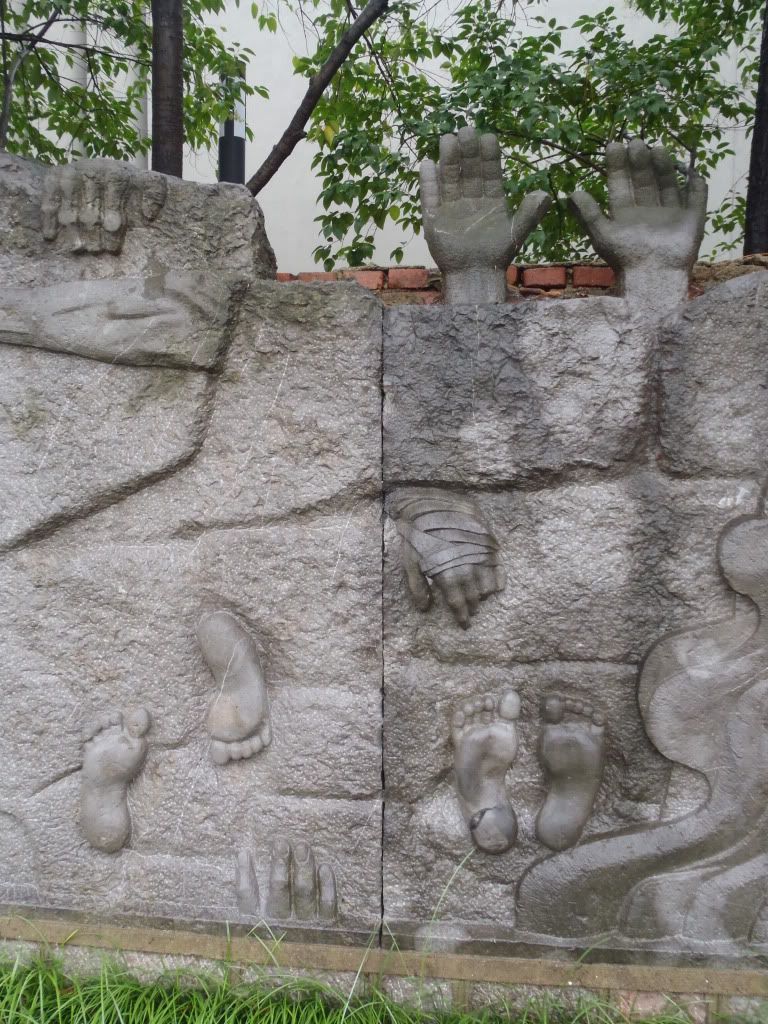
If you’re not sure what this is all about, here’s what Lonely Planet has to say about the Rape of Nanjing:
“In 1937, with the Chinese Army comparatively weak and underfunded and the Japanese Army on the horizon, the invasion into and occupation of Nanjing by Japan appeared imminent. As it packed up and fled, the Chinese government encouraged the people of Nanjing to stay, saying ‘All those who have blood and breath in them must feel that they wish to be broken as jade rather than remain whole as tile.’ To reinforce this statement, the gates to the city were locked, trapping over half a million citizens inside. Nevertheless, thousands of civilians attempted to follow the government by escaping through Xiaguan Gate, the only gate in the city that remained unlocked. Leading up to the gate was 21m tunnel inside of which reigned panic and mayhem. In the resulting collisions and chaos, thousands of people were suffocated, burned or trampled to death.
What followed in Nanjing was six weeks of continuous, unfathomable victimization of civilians to an extent unwitnessed in modern warfare. During Japan’s occupation of Nanjing, between 300,000 and 400,000 Chinese civilians were killed, either in group massacres or individual murders. Within the first month, at least 20,000 women between the ages of 11 and 76 were brutally raped. Women who attempted to refuse or children who interfered were often bayoneted or shot.”
Jiangdong Gate is the exact spot where one of the mass graves was unearthed. They’ve left the skeletons in place, creating a gruesome picture of the horrors these people must have gone through. We learned that some bones were found seriously deformed, whilst others had bullet or bayonet holes. We spotted the remains of a 6-year-old with its skull resting on its chest. The autopsy revealed the head had been severed from the body before its death. Another skeleton, this time of a 9-year-old bore 3 nails, knocked into the shank, splinter bone and shoulder bone. Sometimes pictures speak louder than words, and sometimes words cover things perfectly, so here’s a few pictures and a poem we both found impressive.
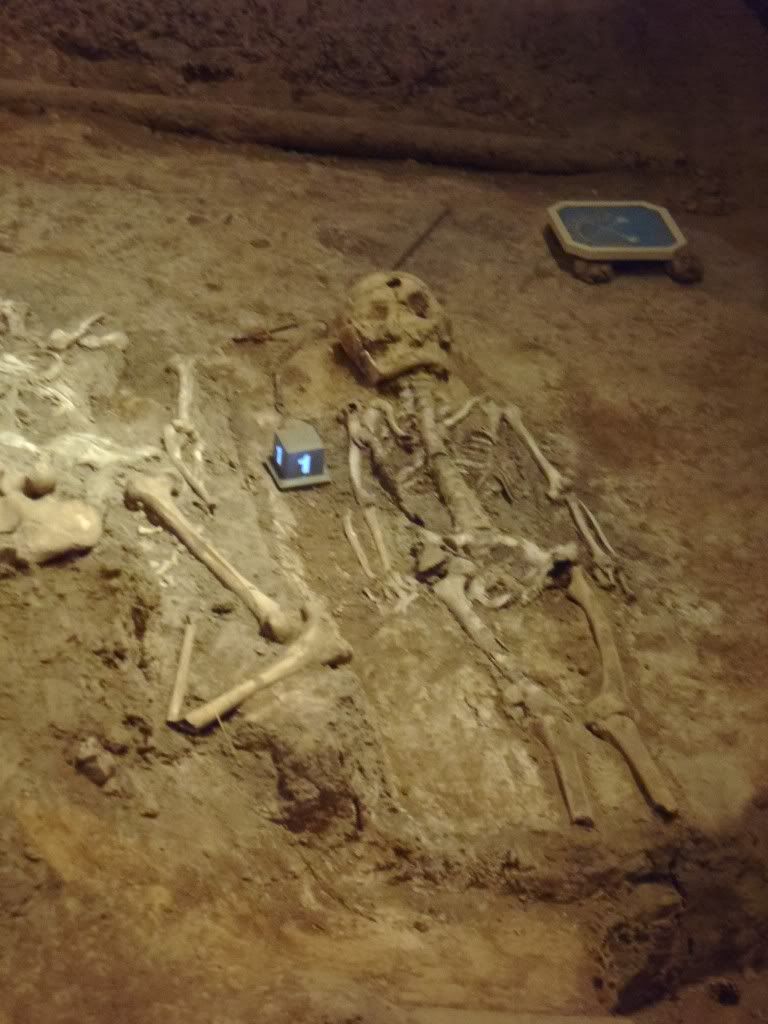
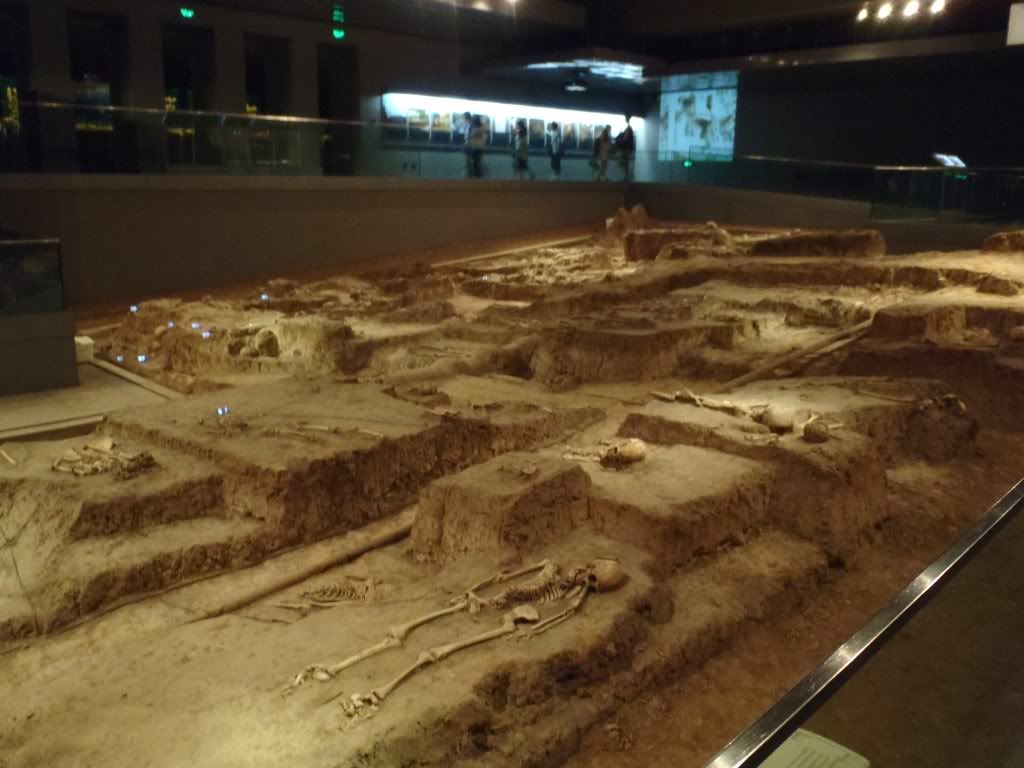
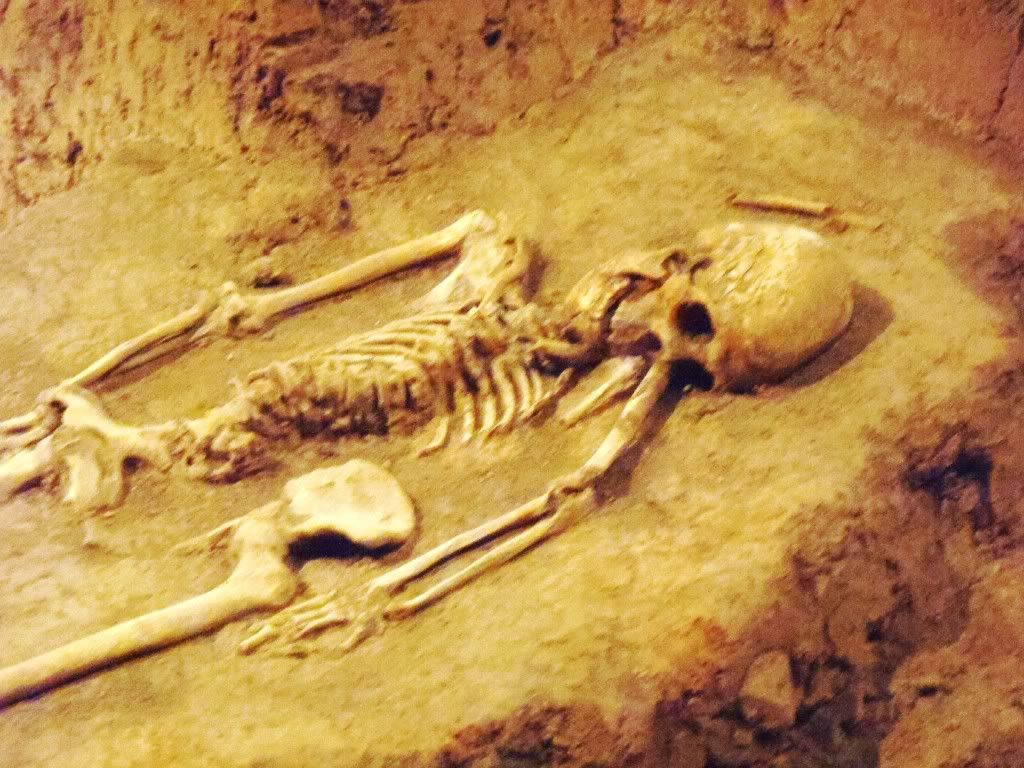
Let the white bones fall into sleep
Let the grievance souls rest peacefully
Turn the slaughtering sword to the cast of a warning bell
Turn the names of the departed to be engraved in history
Let the children no longer face with the fear
Let the mother no longer shed her tears
Let war be distant from all mankind
Let peace be spread fully to the world
Even with all its Chinglish, this poem carries a very powerful message. Well done! We continued our exploration, departing temporarily from the Massacre-theme and looking at some anti-American art. Back outside we walked past some very impressive and telling sculptures. We saw one more building in the distance and found an entrance. We entered the first hall and started reading. Some guy kept coming to us, saying stuff in Mandarin and ushering towards the door… We had no idea what he wanted, but pretended to understand whilst continuing reading.
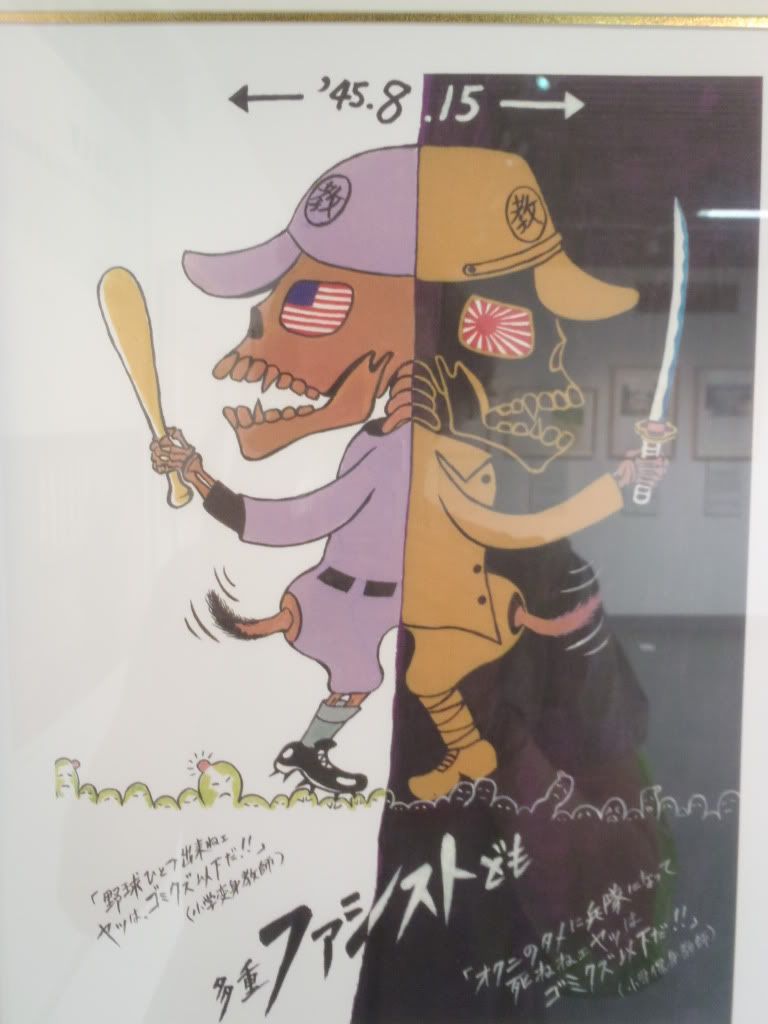
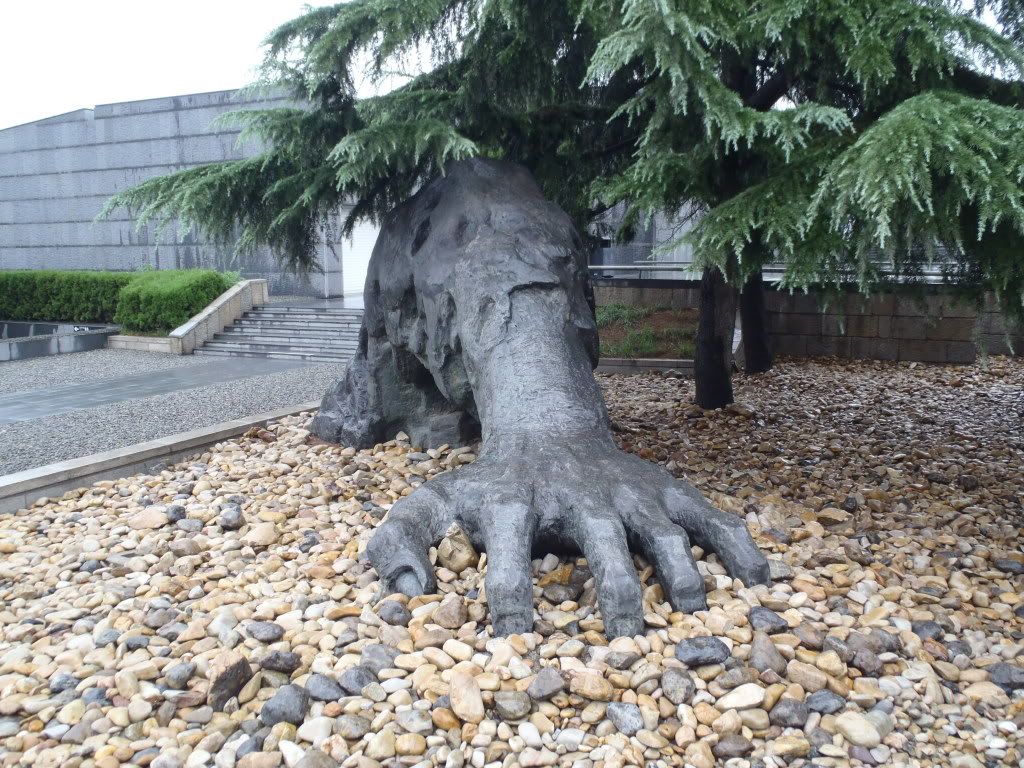
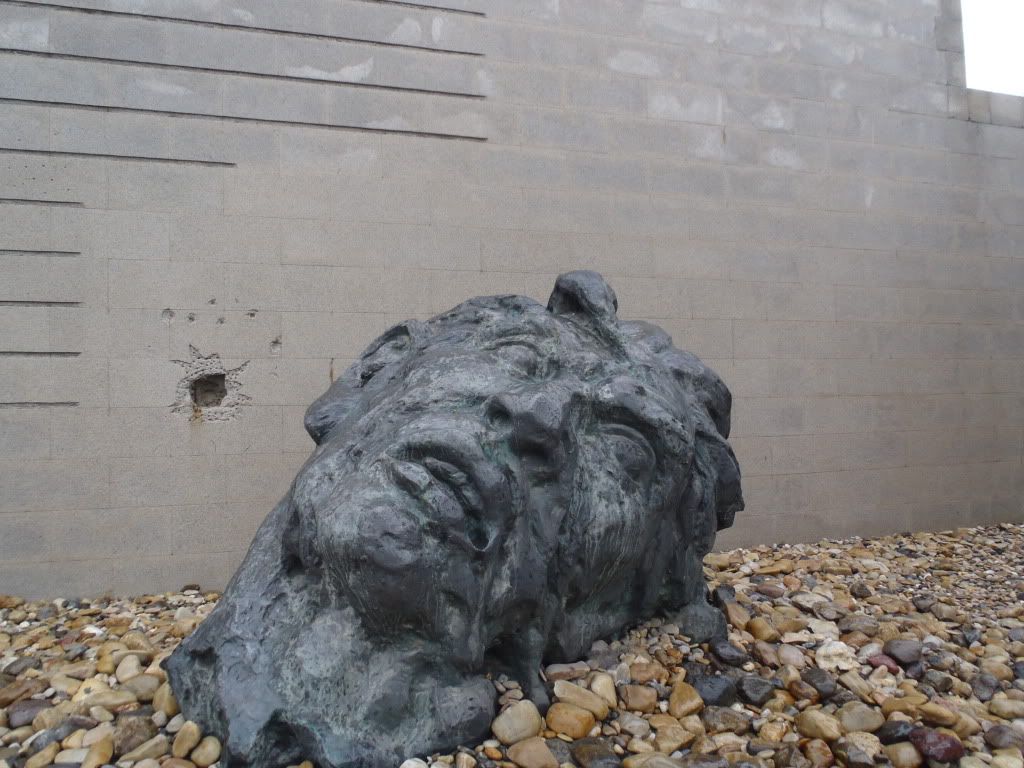
We found it a little strange the museum started with post-war happenings, such as trials for Japanese war-criminals. We also read about the way the Japanese treated the Chinese women they’d captured. One story told about Zhou Fenying, who’d been forced to become a 'comfort lady.' She explained the Japanese simply gave these women numbers, and their soldiers would be able to come in freely to have their way with them pretty much 24/7.
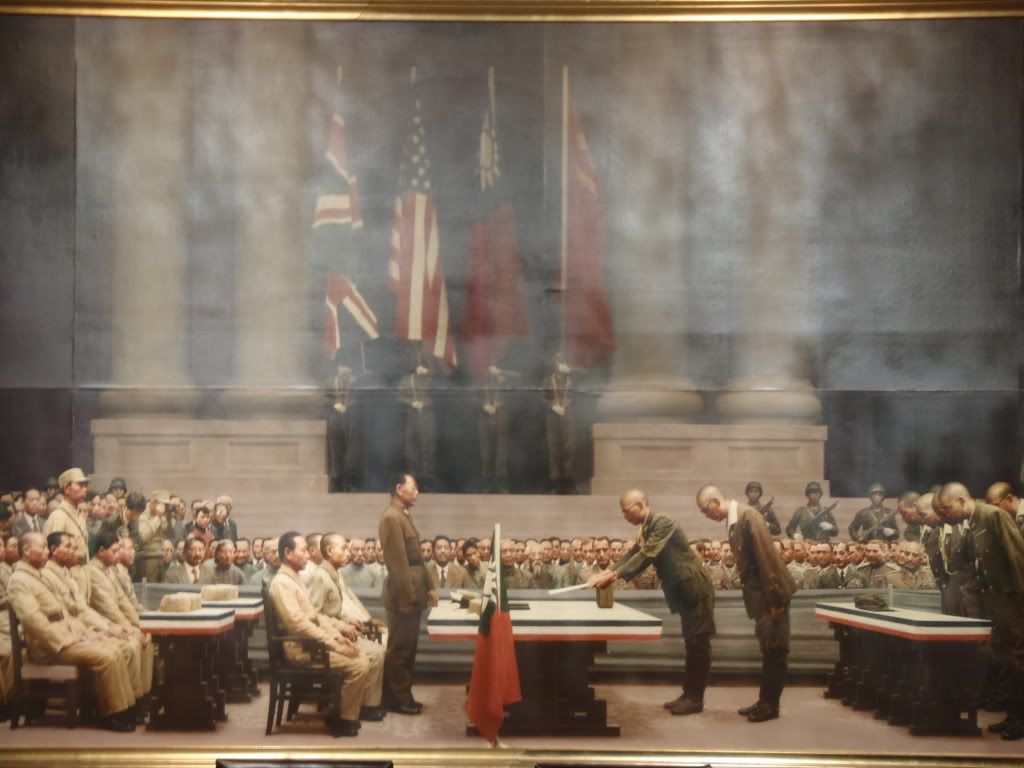
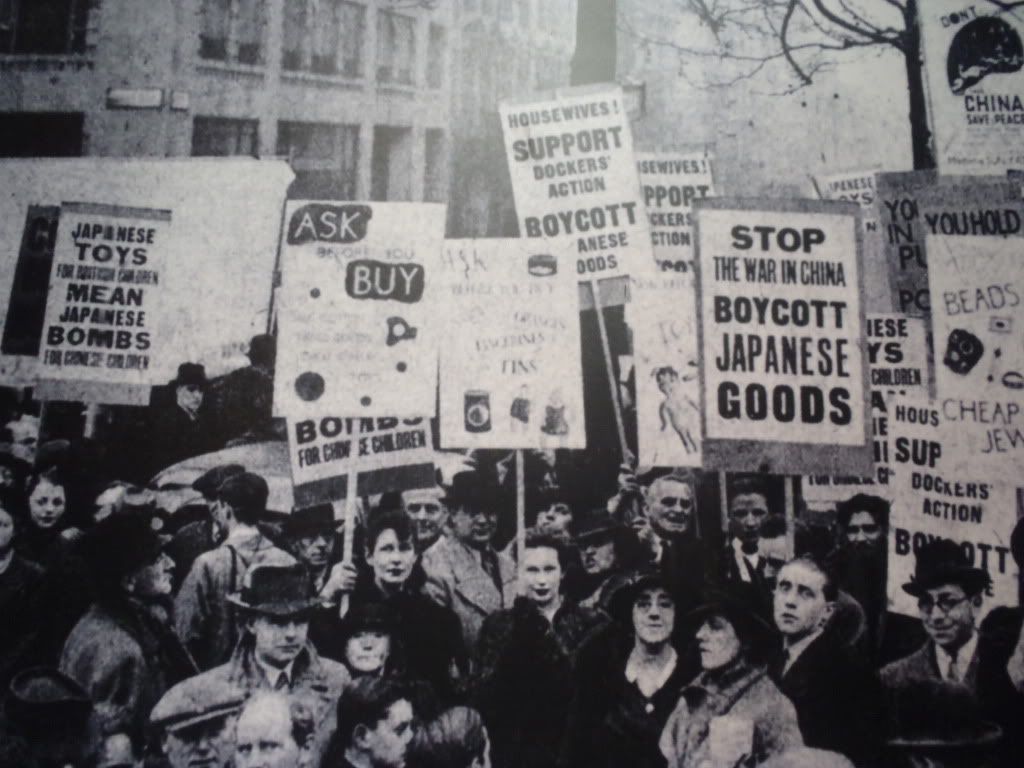
Another set of horrifying pictures spoke of germ-warfare victims. We both did not know the Japanese had experimented on humans in Nanjing. It became a little bit less of a surprise when we read that the Japanese had adopted a “burn all, kill all, loot all” policy. Humanity was not part of the Japanese war machine.
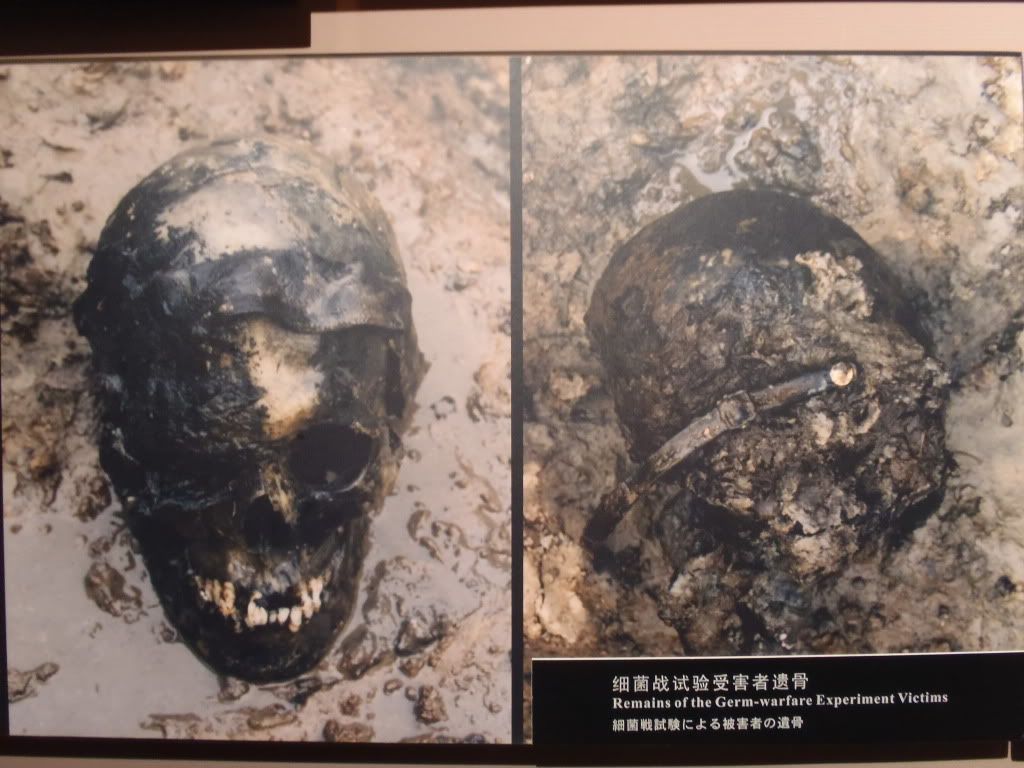
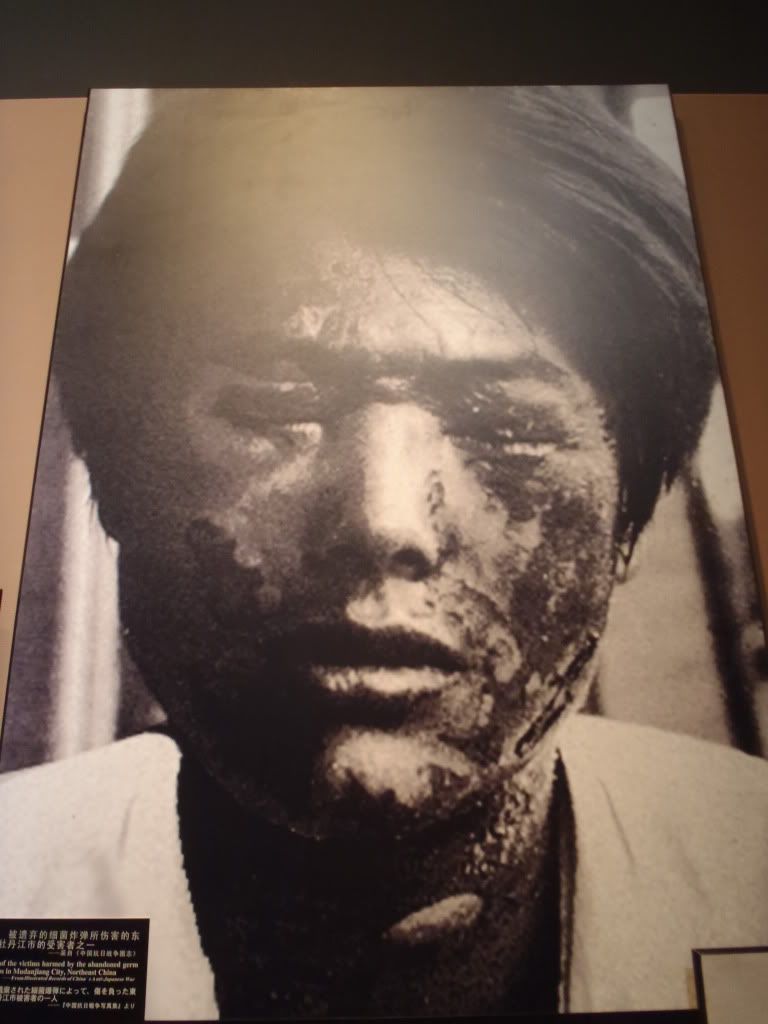
At this point the time line changed again and we were now reading about the end of the 18th century. Francesca and I had a good look around and noticed everybody was going in a different direction from us. We’d entered the museum through the exit! So that’s what that guy had been trying to tell us. We decided to continue going the way we had, because the museum itself didn’t have a clear time line either. We figured it’d be easy to puzzle everything together ourselves.
The Japanese had wanted to break away from Asia and wanted to join Europe. It developed quickly and the Japanese felt they could enlarge their empire. With the growth of their power and army they turned to outward expansion. Korea was the first to fall, and China came next. In 1895 the Japanese landed in North-East China and swiftly defeated the weak Chinese army and naval fleet. The loss pressed the Chinese further into a national crisis and served to strengthen the Japanese morale. The Nanjing Massacre turned out to be the culmination of the unavoidable: Japanese invasion.
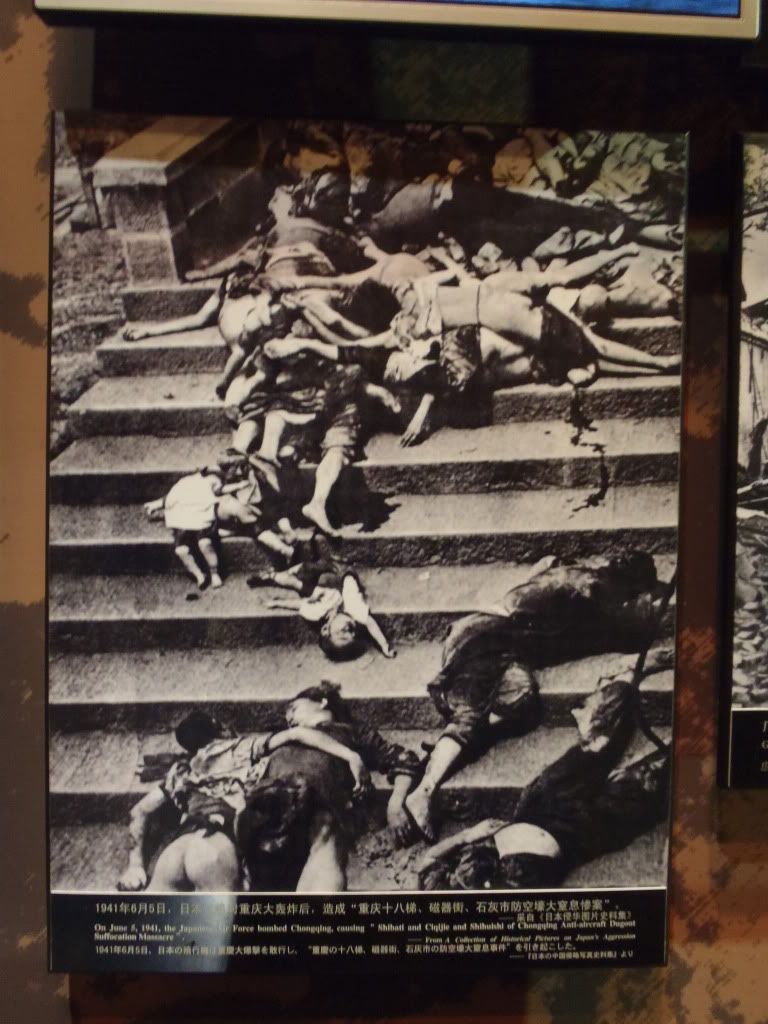
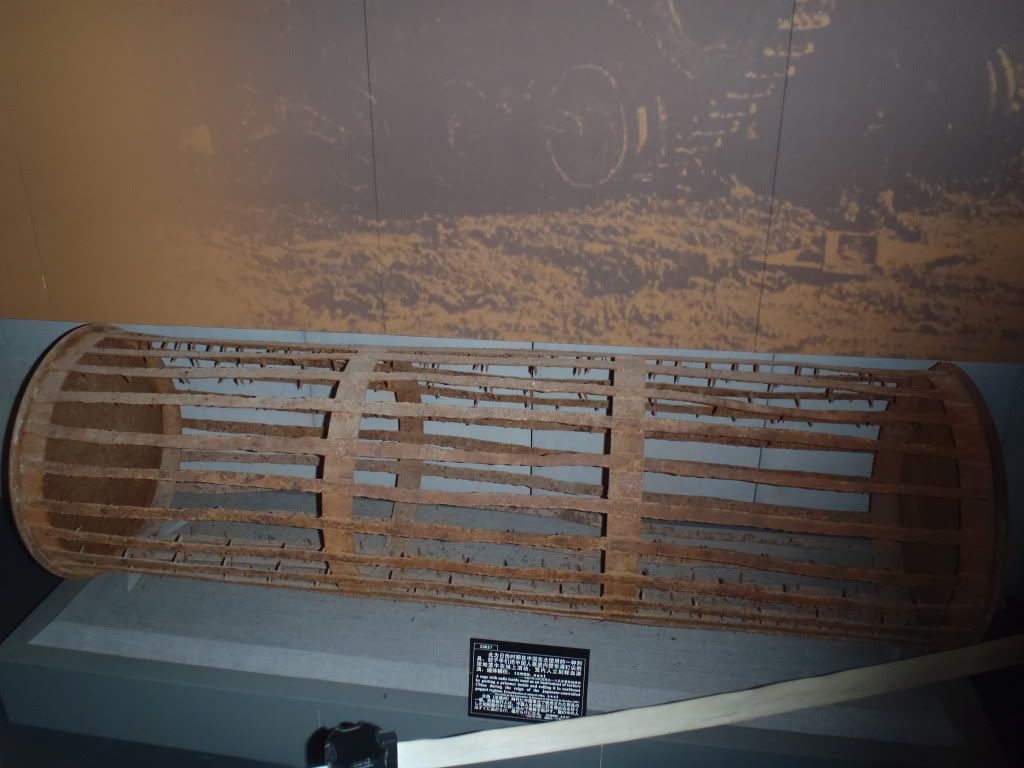
About halfway through the museum we ended up looking at an enormously high wall. Extensive archives about those that died and how they came to their end were piled up here, leaving visitors with an idea of how much we’ve been able to find out about the crimes committed by the Japanese and the horrors suffered by the Chinese.
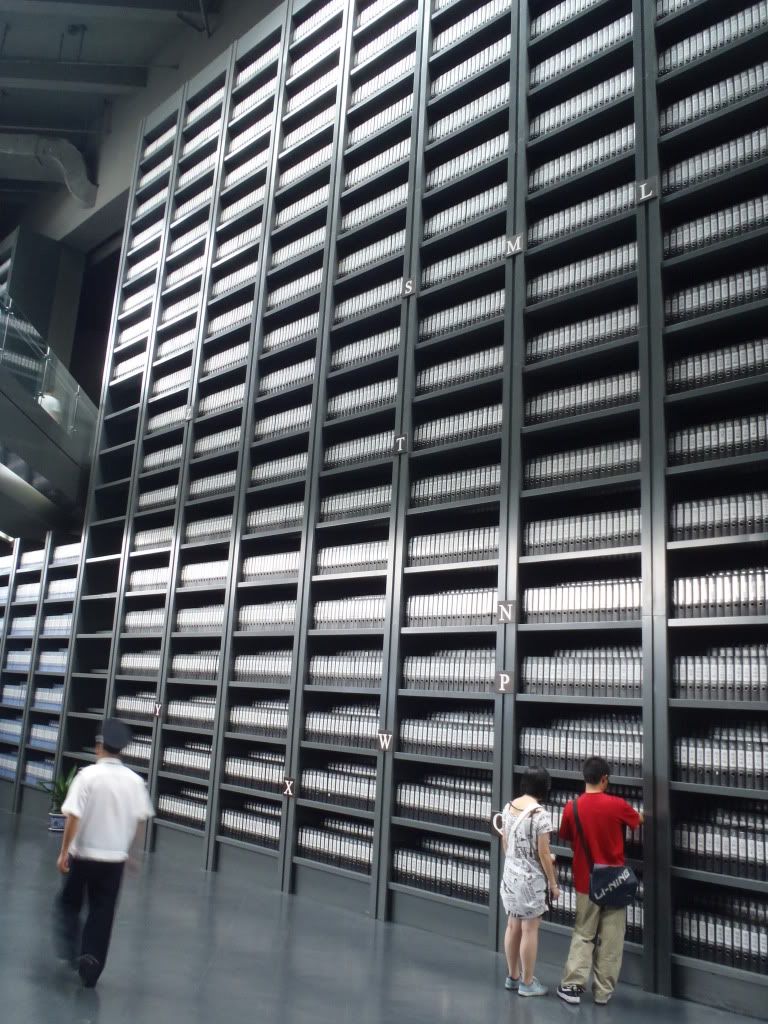
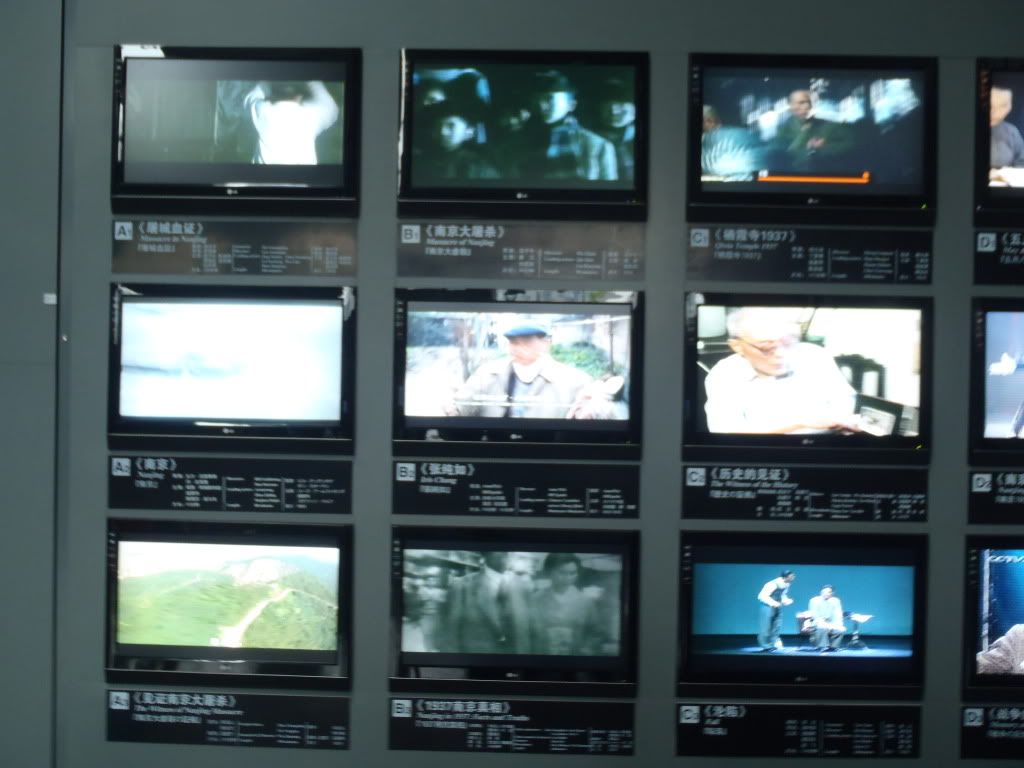
The next section became even more graphic. One picture stands out in my mind and continues to pop up as I write about this day: the head of a Chinese man, cigarette in mouth, resting on a barb-wired gate, used as a warning against any Chinese opposition.
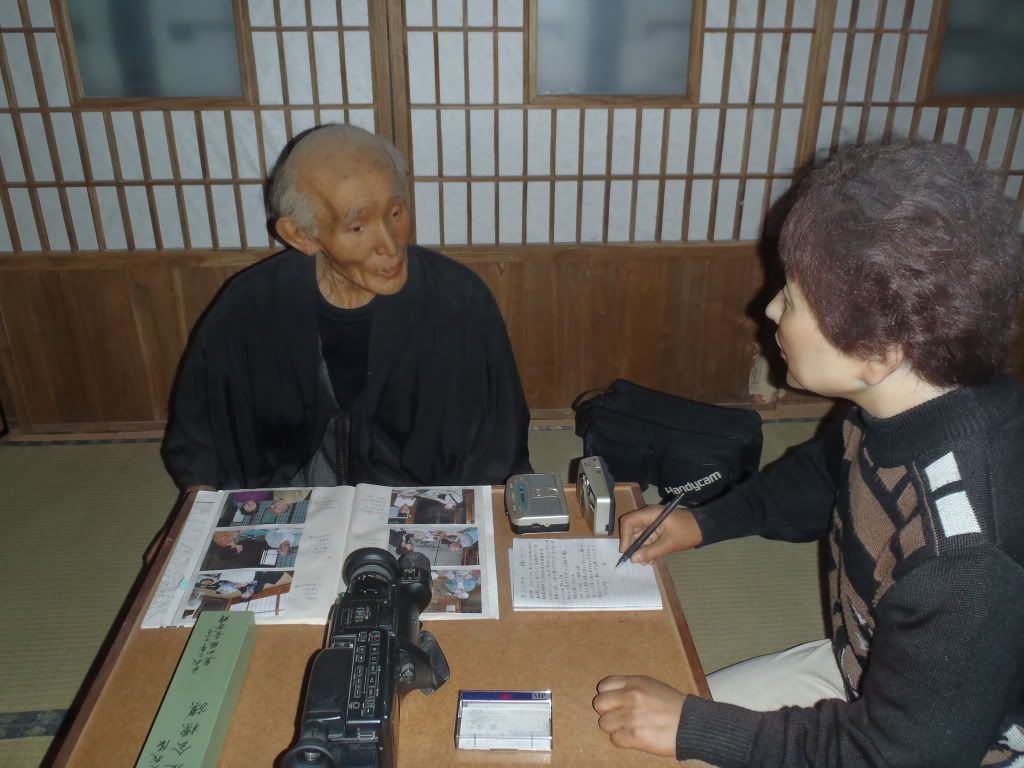
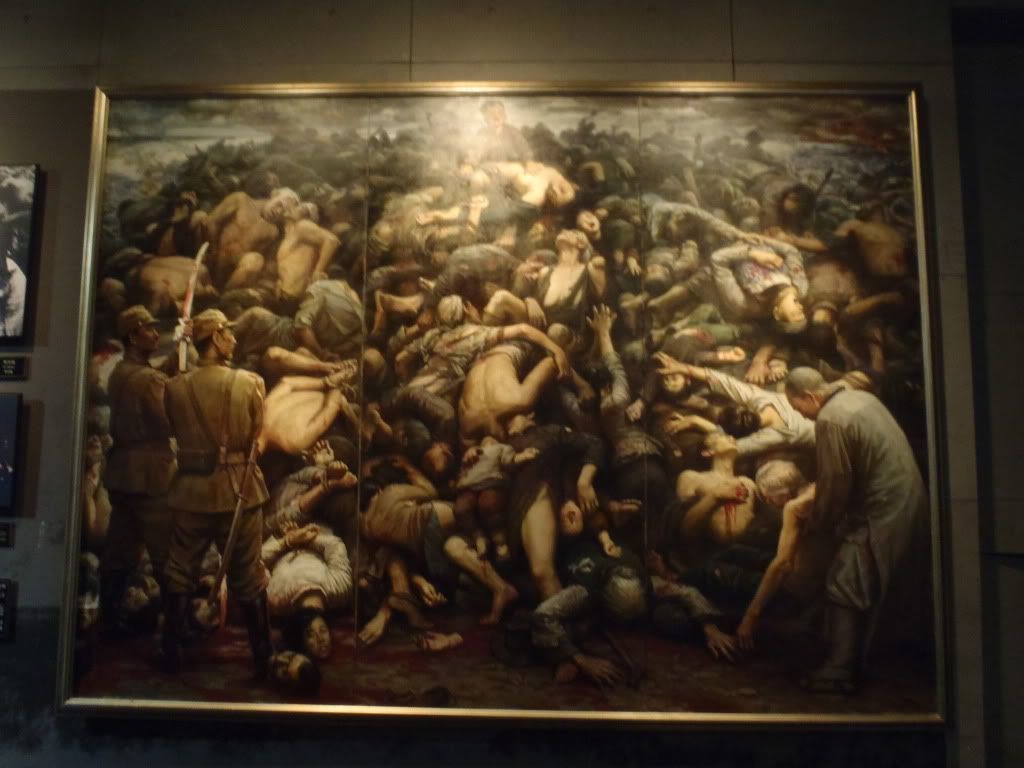
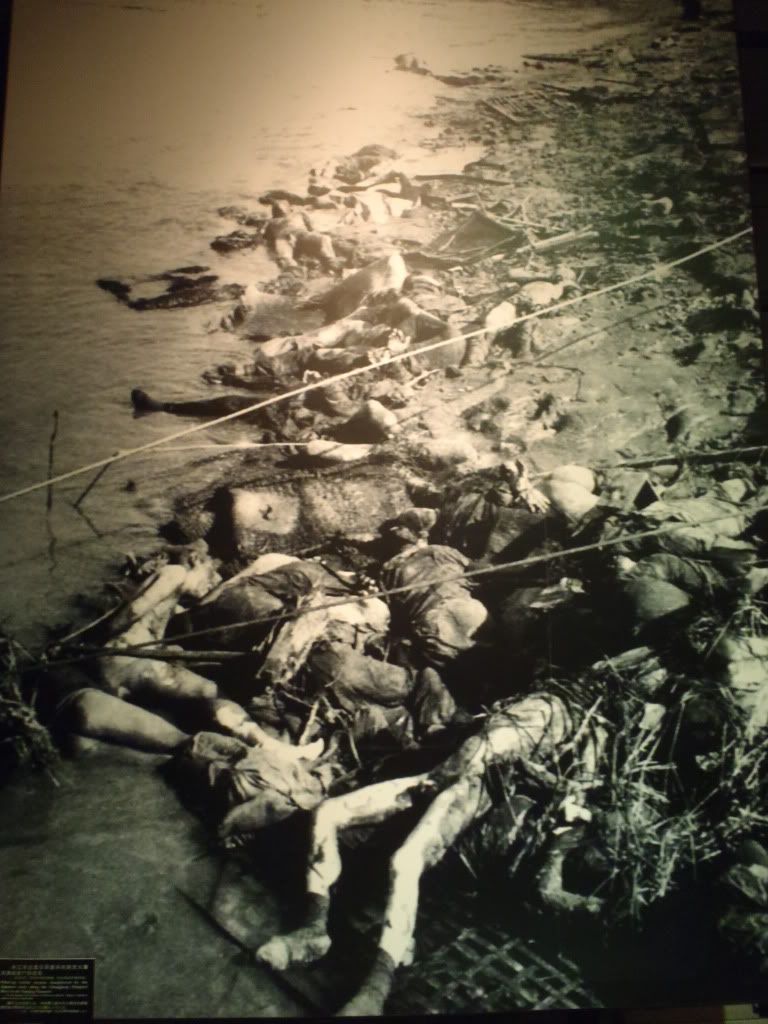
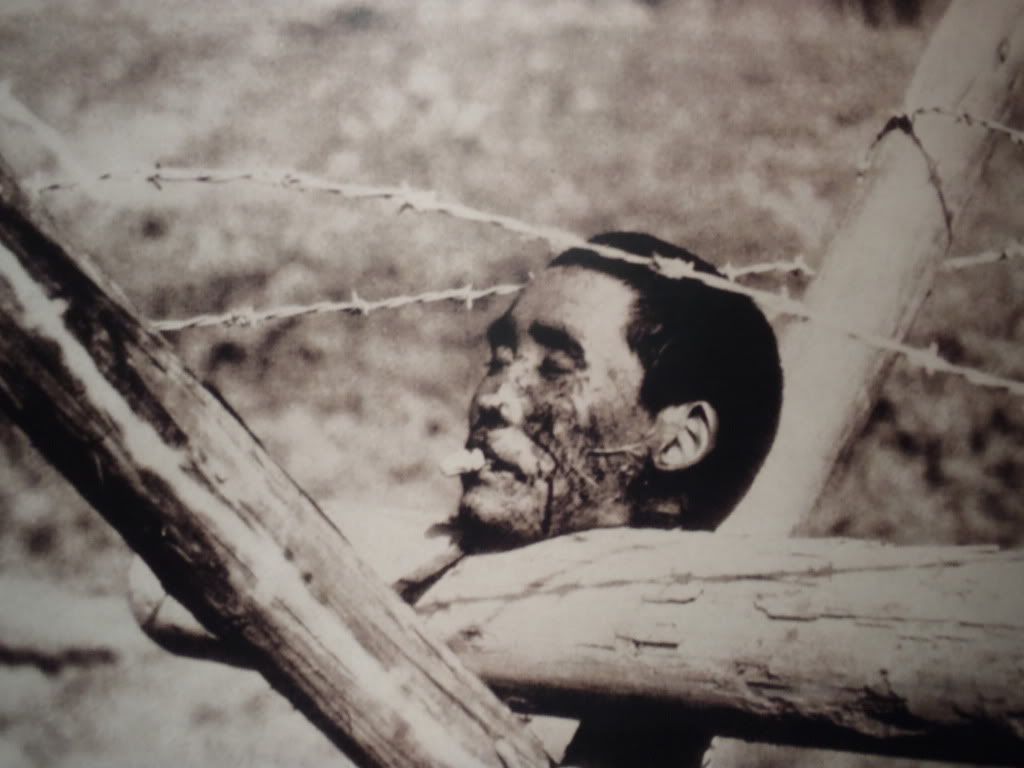
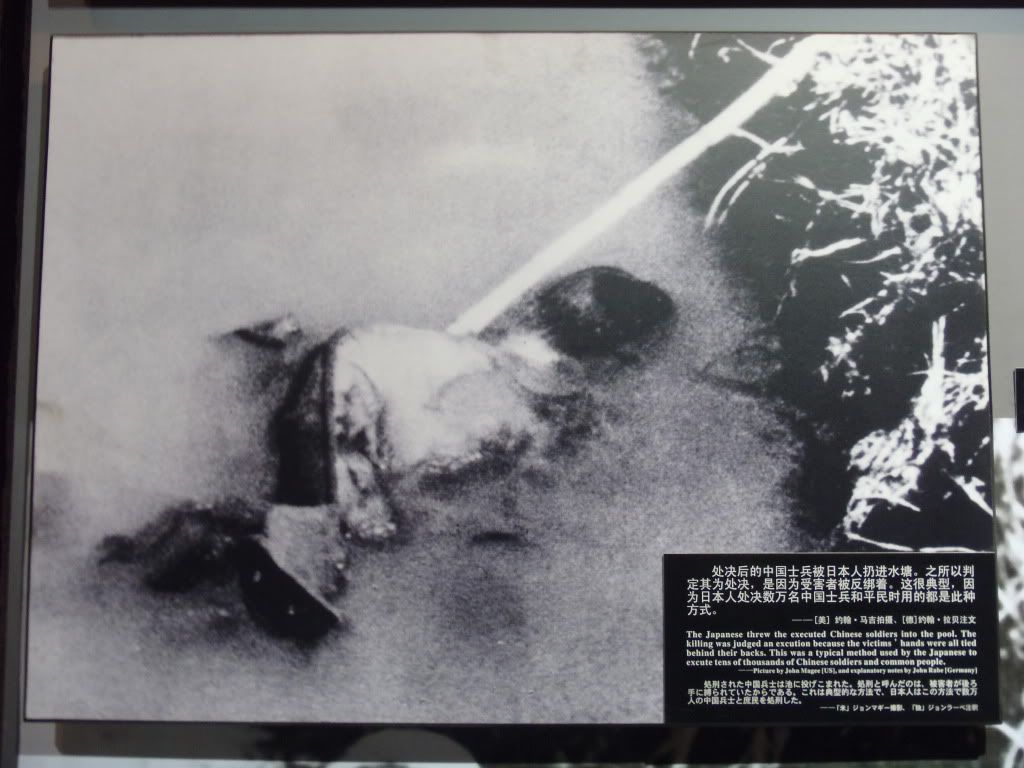
And then there were two Japanese generals, Noda Takeshi and Mutai Toshiaki, who held a contest to see who could kill 100 people first. At one point the first guy was up to 106, whilst the second had only killed 105. They didn’t know who reached 100 first though, so they decided to set the goal at 150 instead. The rest of the museum was more of the same, but this did not bother us. It was thoroughly impressive to learn so much in one day. We had a look at a few more statues outside, grabbed a taxi and headed for the Nanjing Museum.
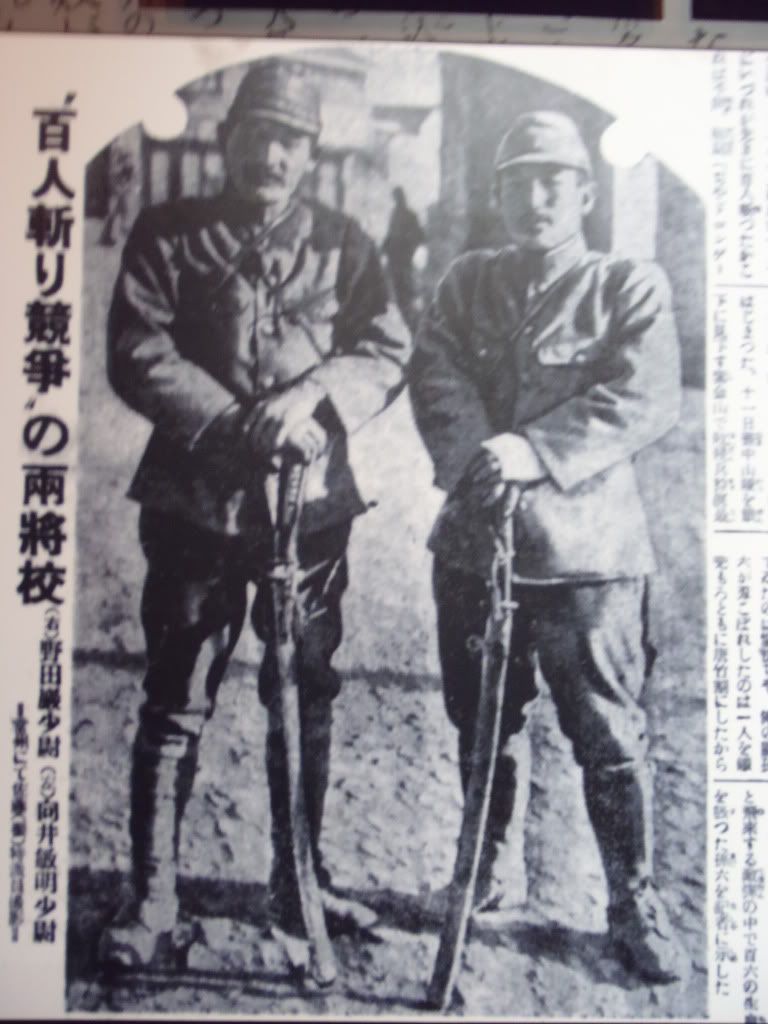
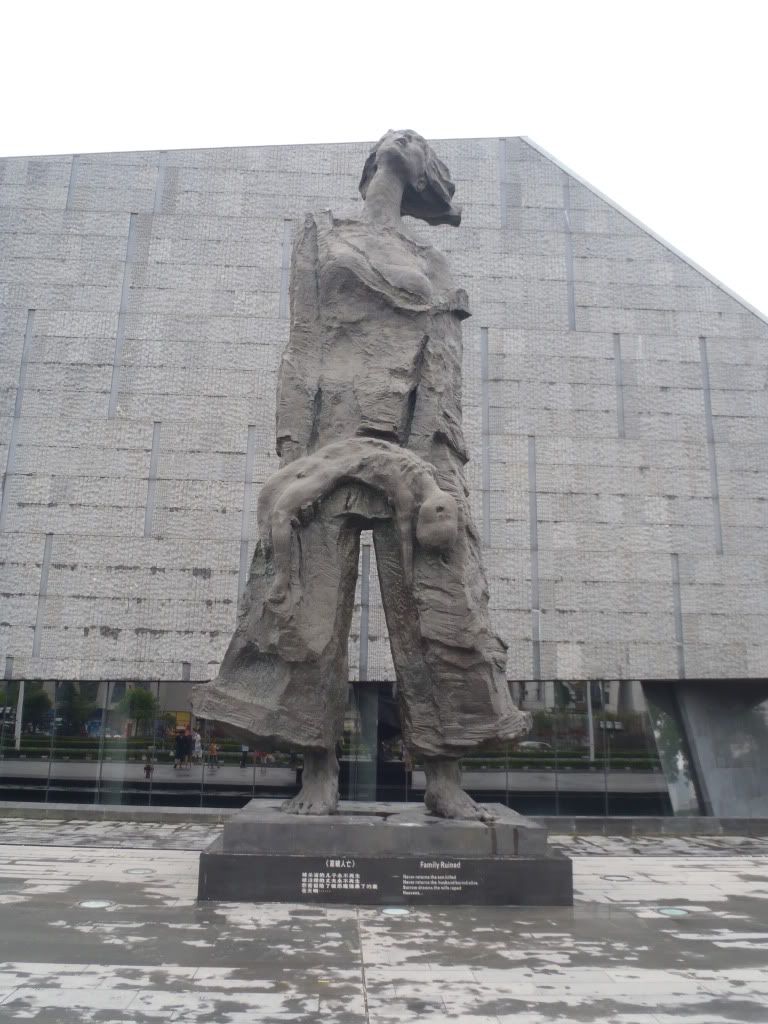
The driver dropped us off on the wrong side of the road, but this gave us a nice view of the old city walls. One underpass later we popped up next to the entrance of the museum. We saw construction in the distance and feared the worst. Indeed, the Nanjing Museum is under construction. Or at least, the interesting part, the history building is. On our left we spotted the other half of the museum. The ticket lady gave us some free tickets and we headed inside. Tired of ceramics, pottery, jade and other Chinese junk I let Francesca do this one on her own, whilst I sat down on a comfortable couch. She told me it was mostly repeats of everything we’d seen before, so we won’t bore you with the details. Here are some pictures to soothe your pain.
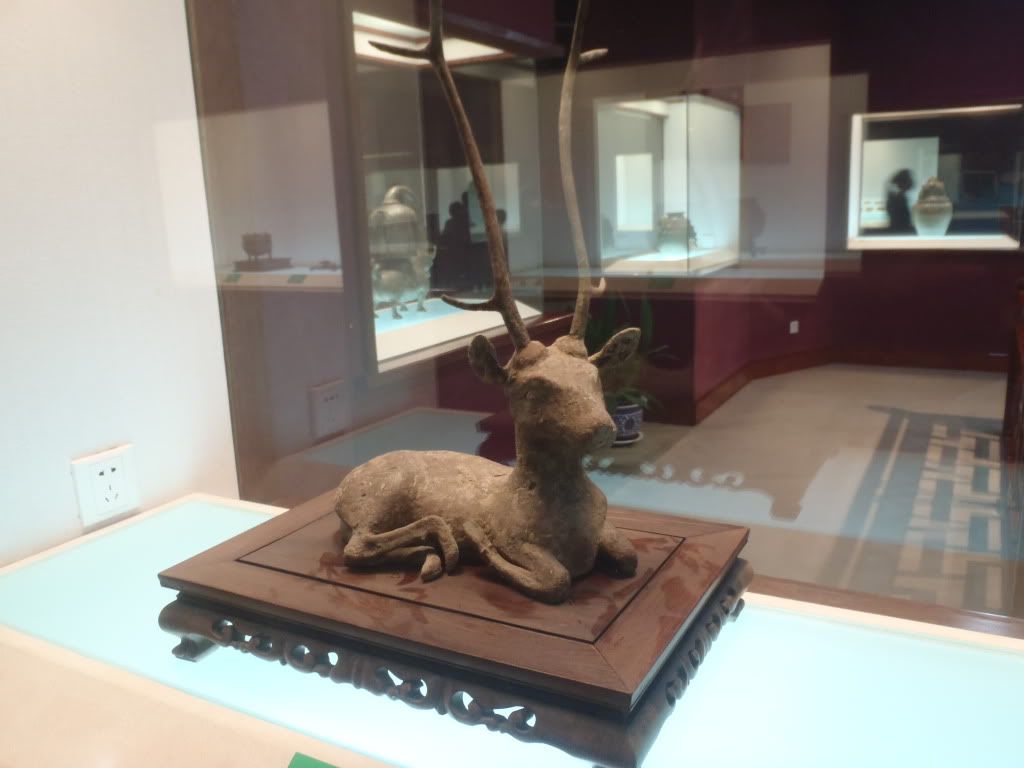
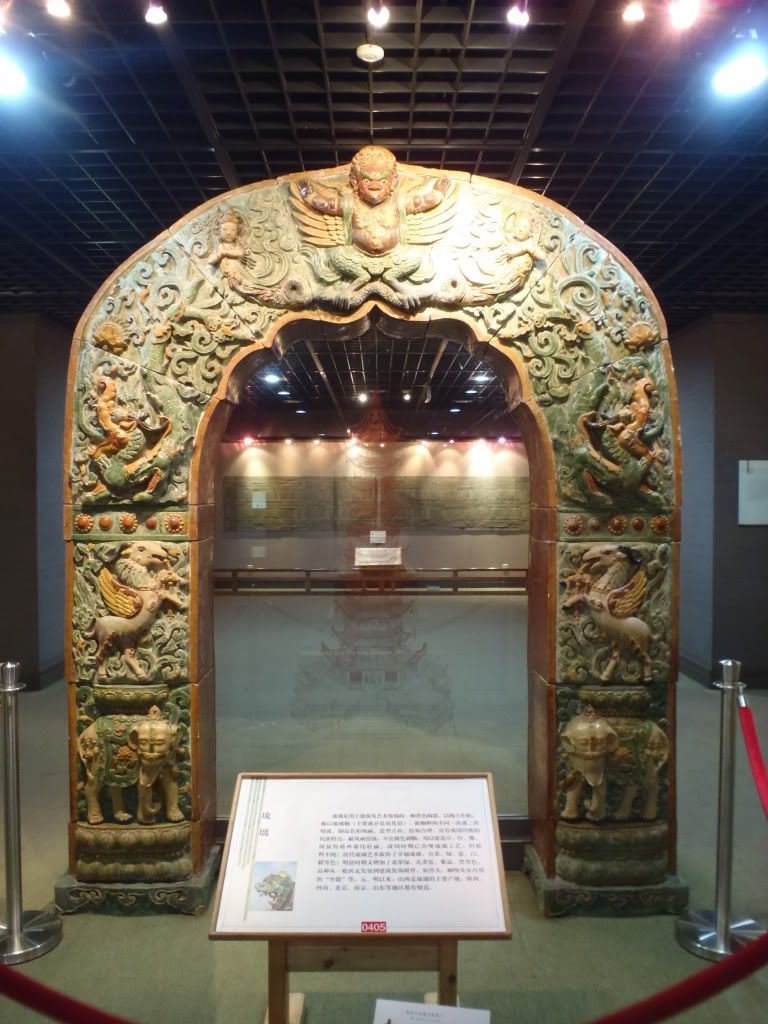
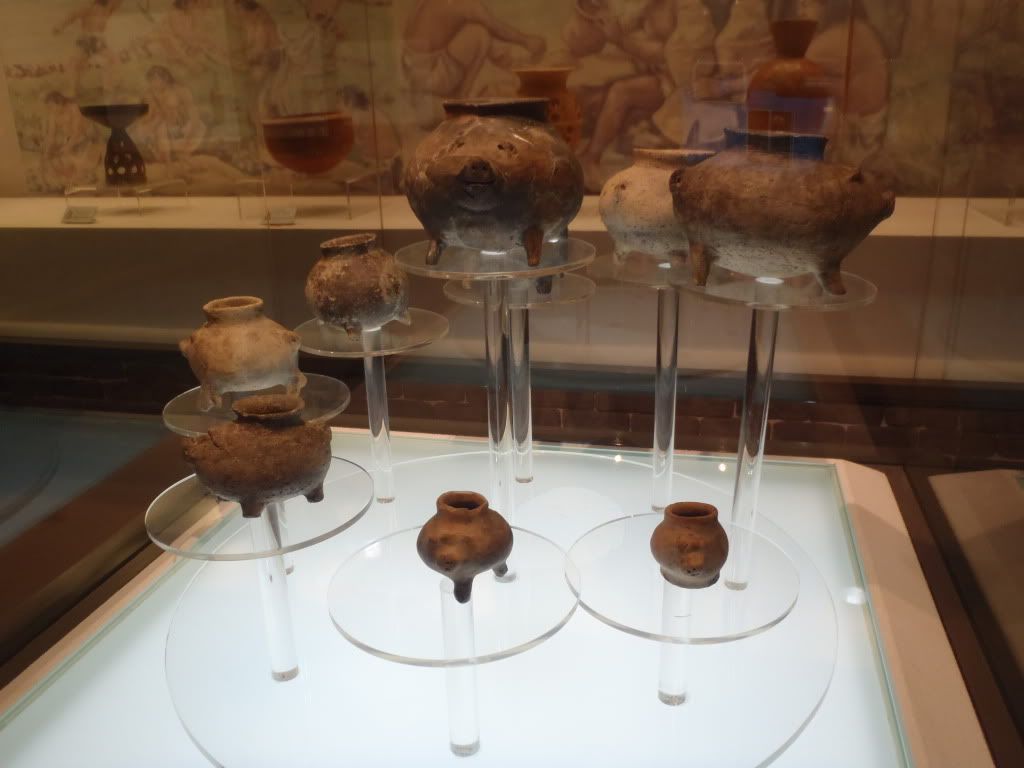
The old Ming city walls stood just a short walk away from the museum and were next on the agenda. Especially the gate stood out as one of the best remaining examples of early Ming defensive architecture. Other than the massive gate and walls we walked through the ancient courtyards, strewn with stones from parts of the wall that hadn’t survived the centuries. We were not alone, and heard several Chinese people singing their way through the park. Especially the acoustics in the gate were impressive and we stood still for a while to listen.
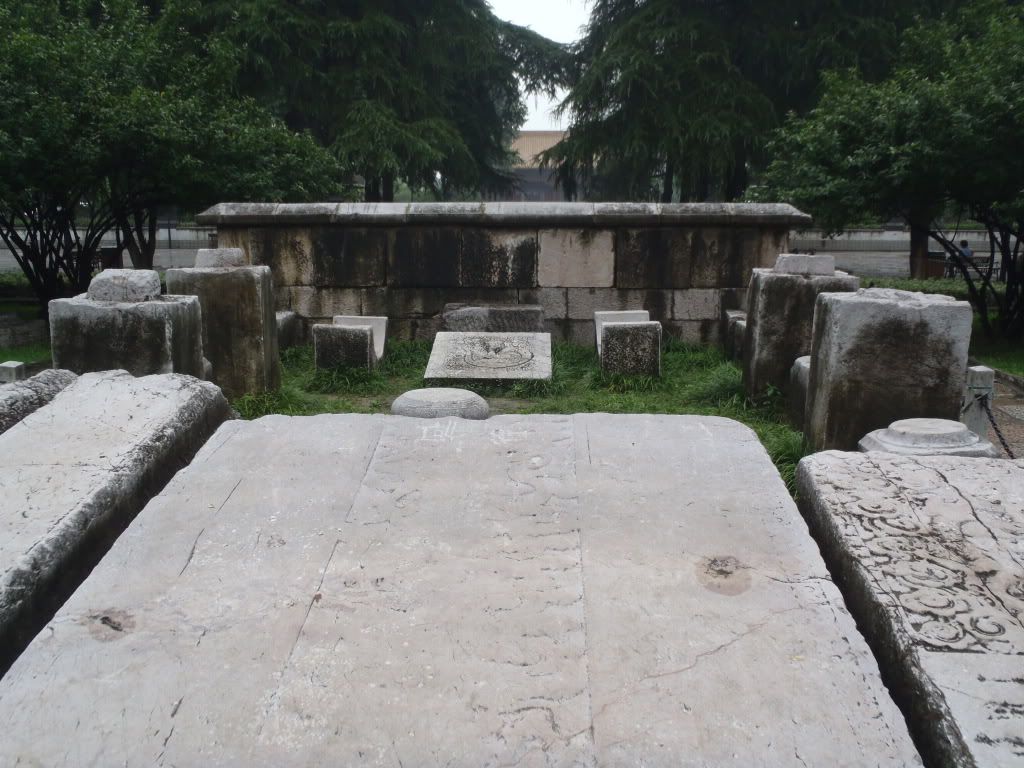
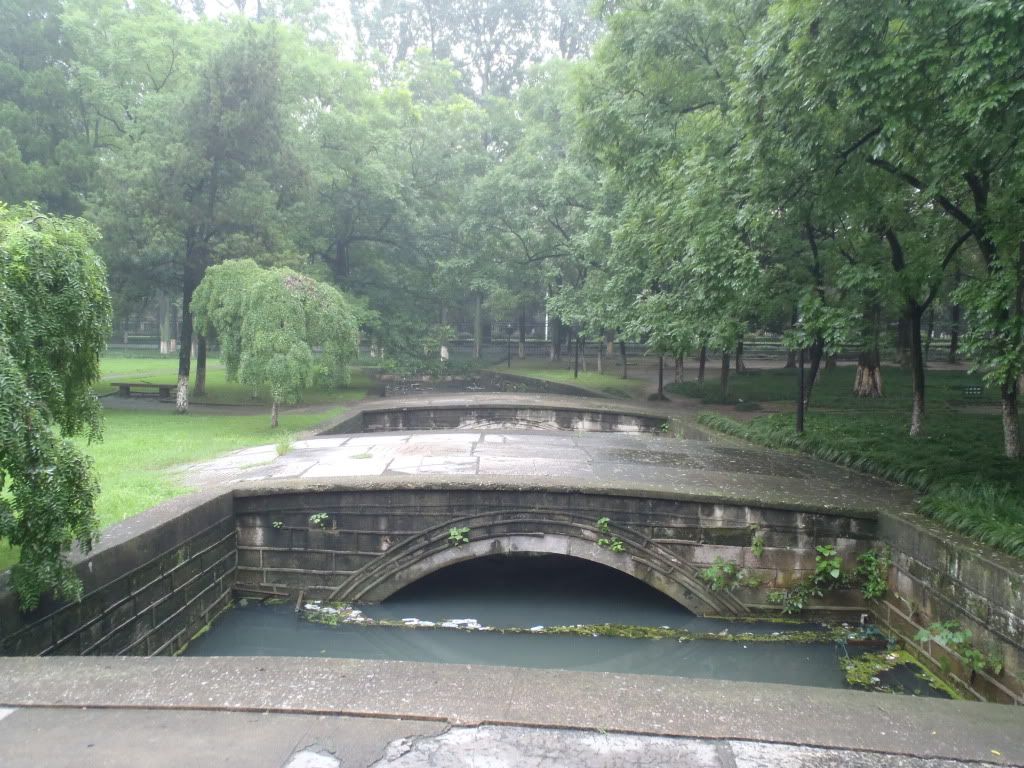

We left the walls behind in a bit of a hurry, since we needed to find the Post Office with its train ticket office badly. I had a map of Nanjing and knew the Chinese word for train tickets as well as post office, so I figured the cab driver would get it. Unfortunately he dropped us off at the wrong one… We still found a ticket office nearby, but the lady there seemed unwilling to help us and told us we wouldn’t be able to get tickets to Jinan or Beijing for another week. And that wasn’t really what we were looking for. In the hope of being able to make it to the main Post Office in time we took another taxi. This time the driver did understand, but we got there too late. I memorized the location and we popped into the subway to head back to Andemen station. A little hungry Francesca and I bought a Snickers and some grapes to hold us over for dinner, which we had planned with the Van der Merwes. We took a taxi back and arrived at their place around 6:30 PM.
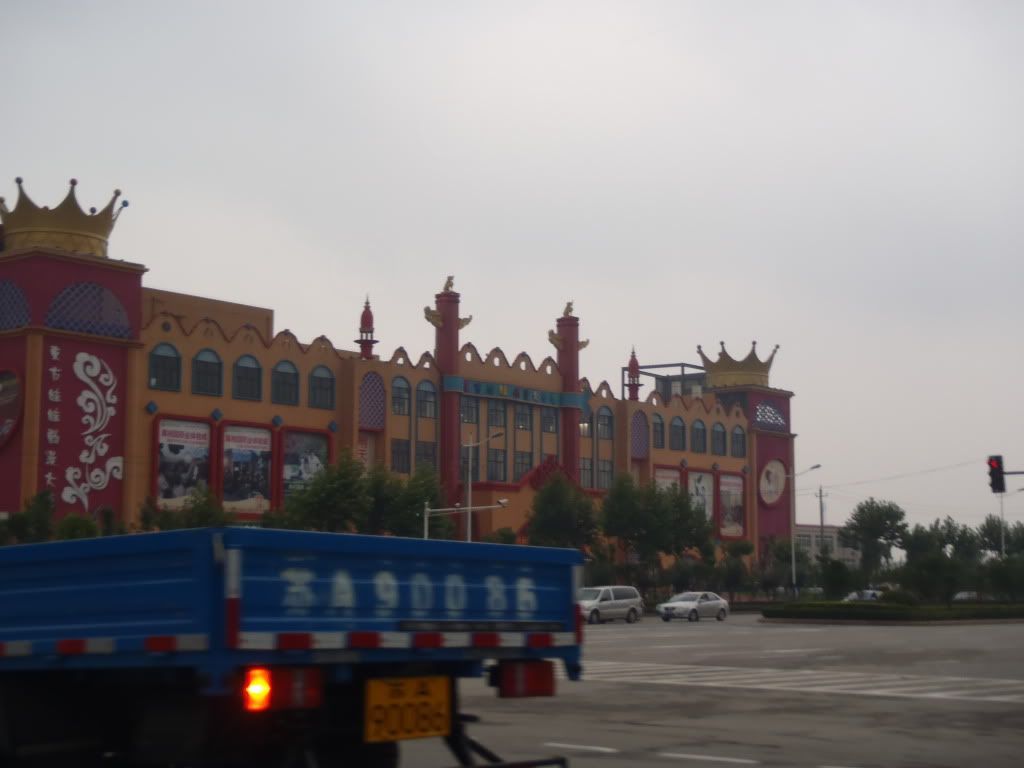
Around 7:00 PM we were all ready and together with the rest of the family Francesca and I headed for a local food street. Beppie and Gert apparently go here more often as they knew exactly where to go, what to order and where to get drinks. We joined two tables together and sat down. Not for very long though, as Beppie led us to the ‘selection’ table, where we looked at fresh skewers of meat, seafood, vegetables and other tasty-looking things. One plate filled up rapidly, and a second one underwent the same faith. We handed the plates to the cooks who turned on the BBQ and started doing their job. It didn’t take long for the first food to arrive. For over an hour the food kept on coming, and the stack of used skewers under the table kept on growing. It was extremely interesting to listen to the Van der Merwes stories whilst we gorged on the food. It’s just wonderful to hear stories about China from someone who’s lived there for some time. It really makes the experience of a city that much better. But, back to the food: the salty bread and spicy chicken skewers were worthy of some special praise. Dessert came in the form of ice creams at the nearby KFC, after which we headed back to Masterland for a drink and more talk.
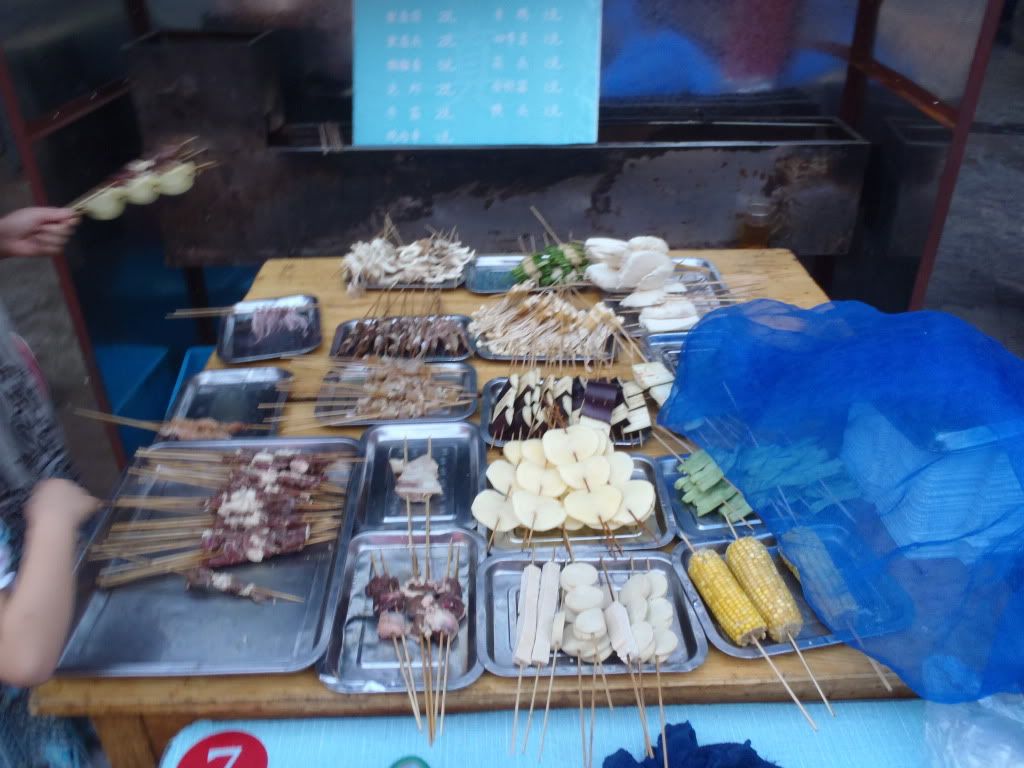
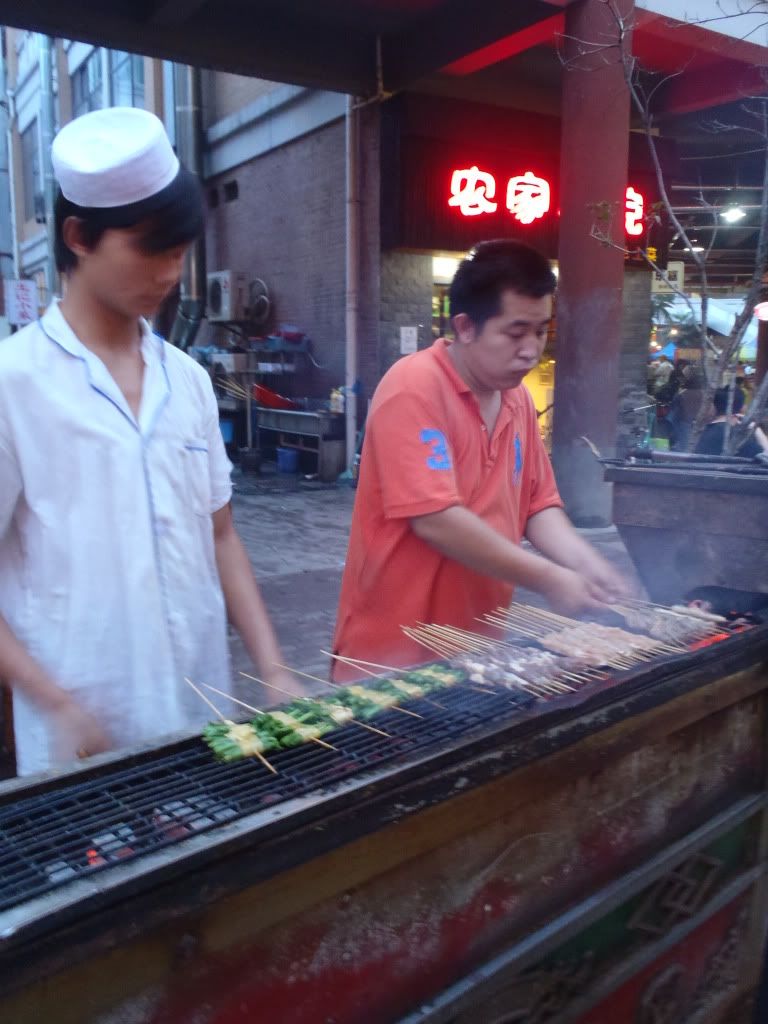
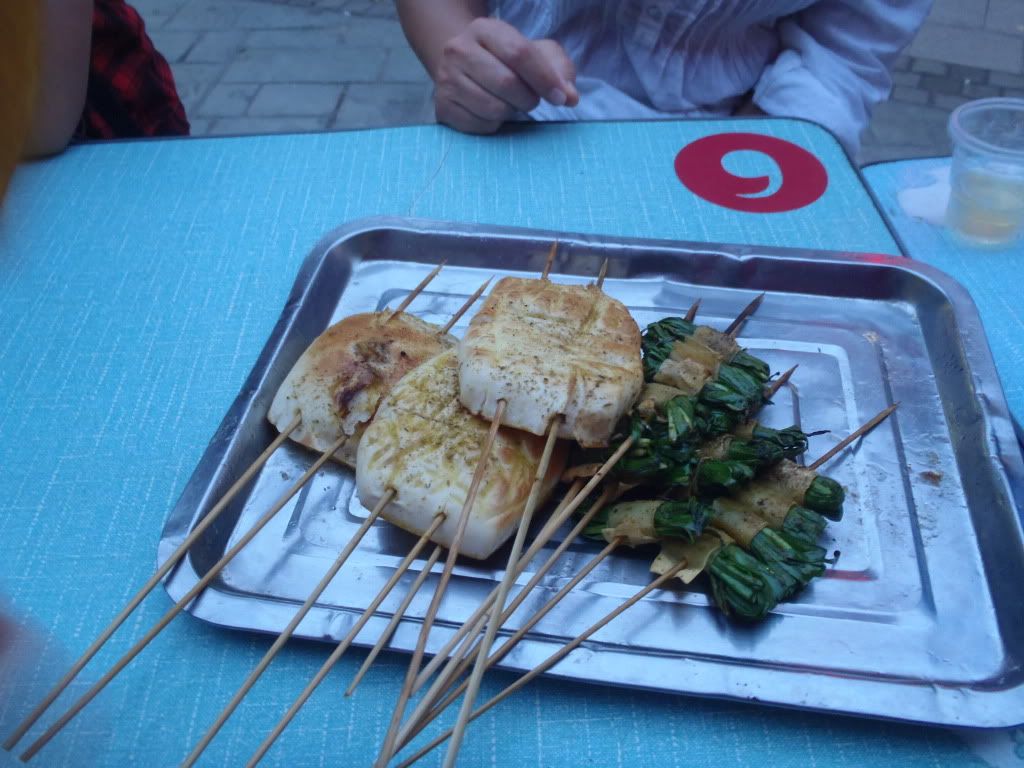
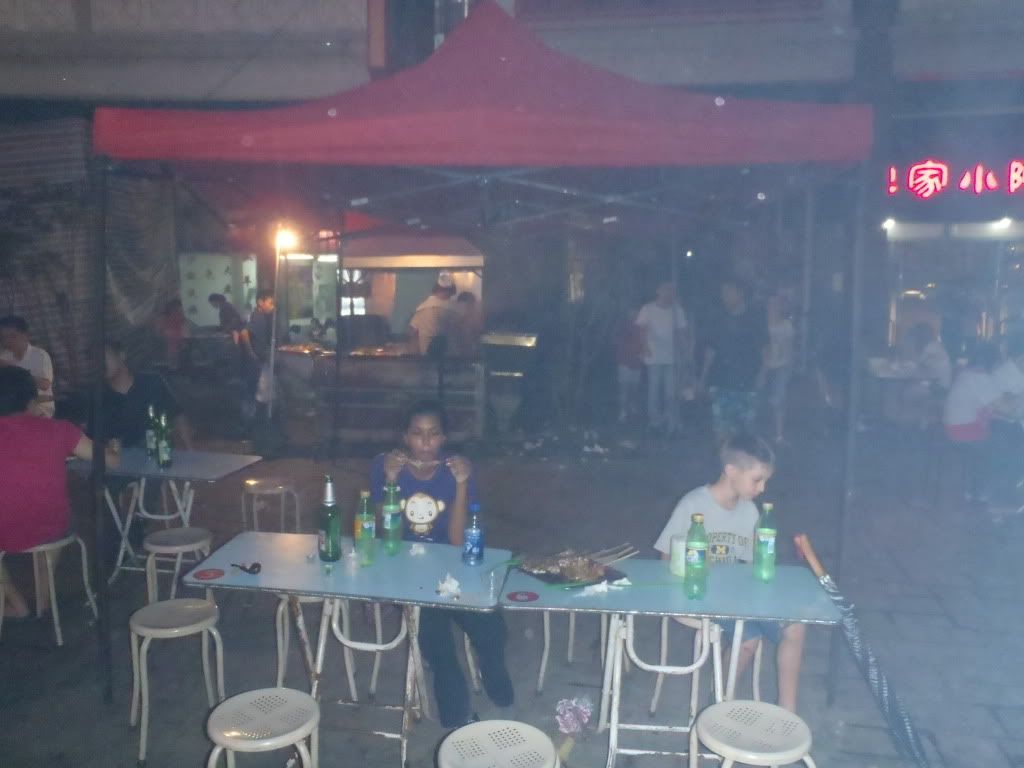
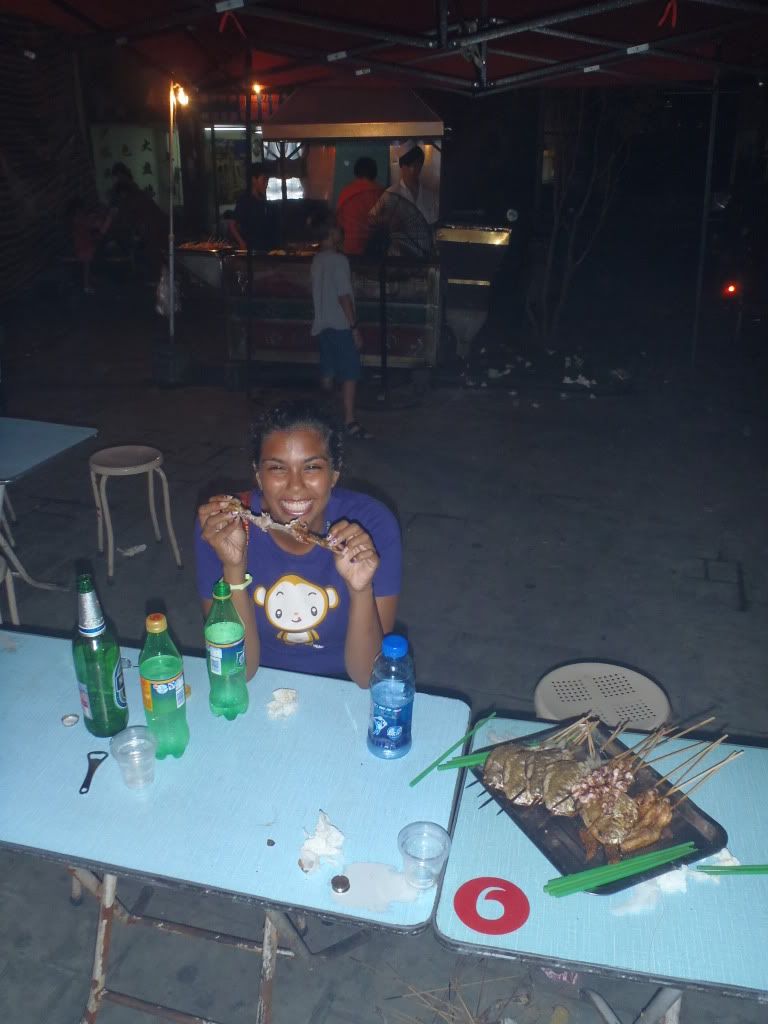
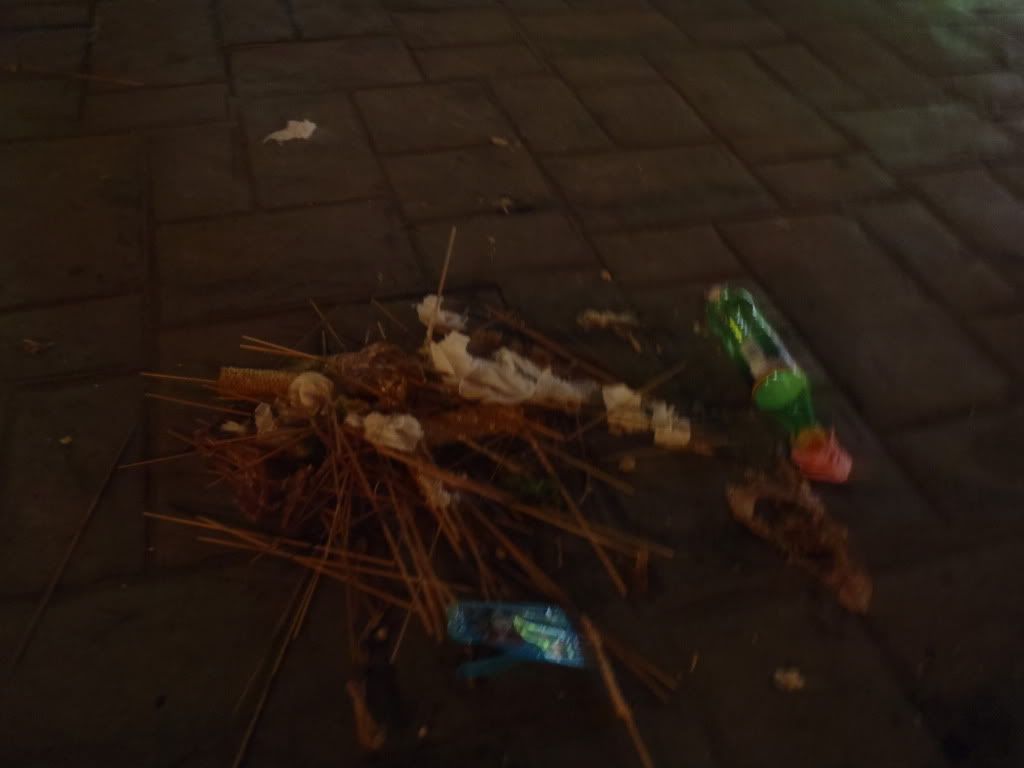
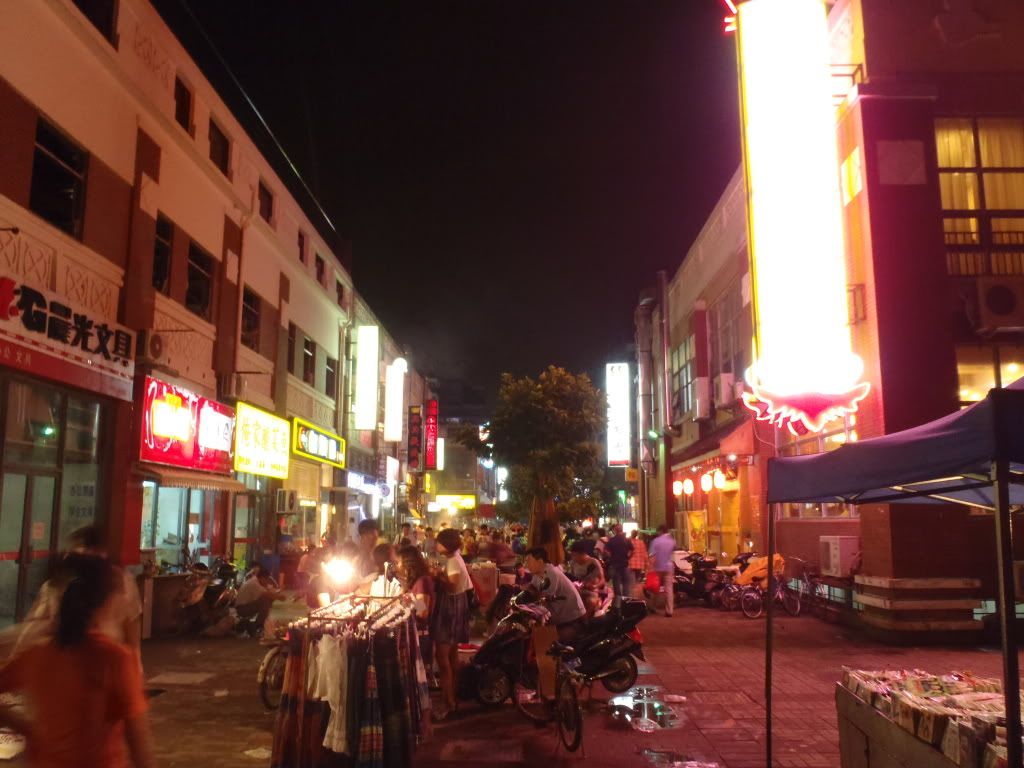
On the 17th of July Francesca and I got off to a somewhat slow start. We’d wanted to go to the Purple Mountains (guess why we were going there!), but also needed to get our train tickets. Furthermore, the Van der Merwes had given us their spare mobile phone (which we are eternally grateful for!) and we needed to get a sim-card to get it working. We first headed back to the Post Office, but found the entire top floor – where the Lonely Planet places the ticket office – closed… We did find a China Mobile shop inside though. I underwent the painful process of trying to explain in English that I wanted a sim-card for the phone, whilst Francesca dodged the bullet and looked for another ticket office instead. Lots of confusing phone calls and pointing-at-the-phone later I finally had a sim-card and a working phone.
Francesca had successfully located a ticket office, which – of course – had closed for lunch. We decided to do the same with our brains and headed for McDonald’s for some local cuisine. Francesca enjoyed a McChicken, whilst I found a cup of corn a sufficient meal. After the meal we finally managed to find an open ticket office and with a bit of help from the Lonely Planet’s glossary and a random guy in the queue next to us we managed to purchase tickets to Jinan and Beijing without any problems. Really makes you wonder why the other lady had nothing until the next week…
Anyway, it was well past 1:00 PM now and we really wanted had to get moving to see the Purple Mountains. First off, the mountains are called ‘purple’ because one can often find purple clouds hovering over the peaks. Unfortunately there were no purple clouds this day, so we in fact visited the Green Mountains. We bought pricey tickets for the first site of the day: the Ming Tombs. The Ming Tomb is the tomb of Zhu Yuanzhang, the first emperor of the Ming Dynasty. The tomb’s construction was started in 1831 and finished 32 years later.
Francesca and I admired the large stone statues leading up to the tomb, as well as several of the oversized entrance gates. The inner red gate proved to be the highlight of our walk. It’s considered the residence of the souls of the deceased. Sadly, the gate had previously fallen in a state of disrepair and lost its charm. The overzealous Chinese had tried to restore the whole thing to its original looks, but sadly went a little overboard. It looked too much like the building had come straight out of factory the day before. The view from atop the gate was impressive and certainly worth the short climb.
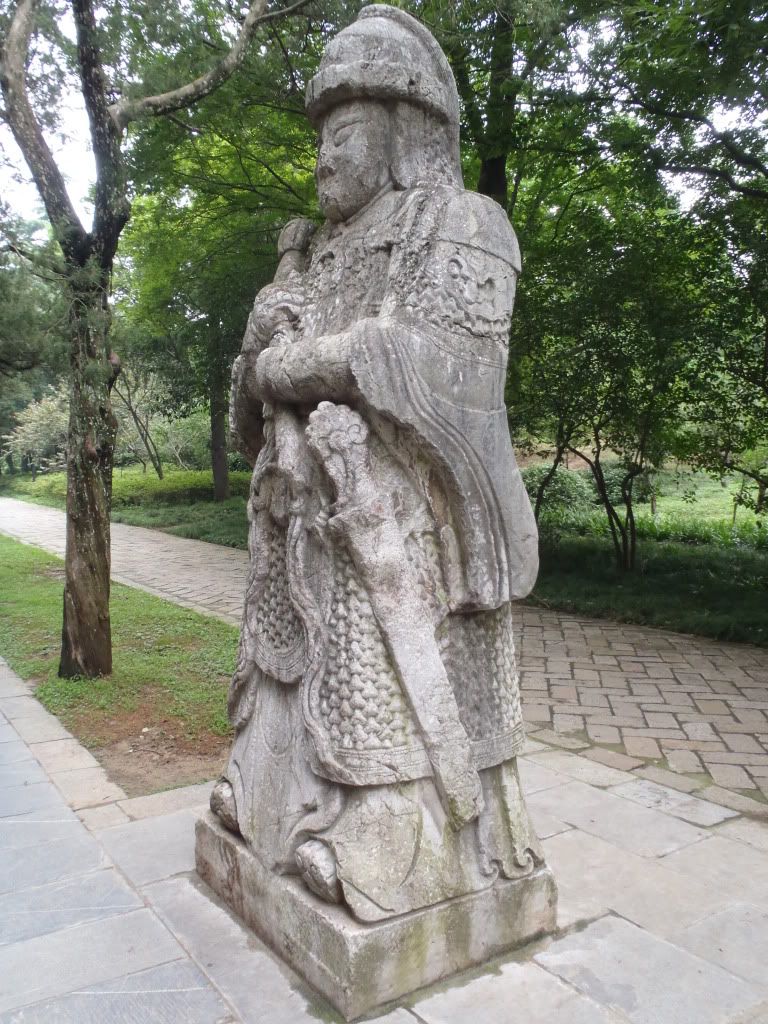
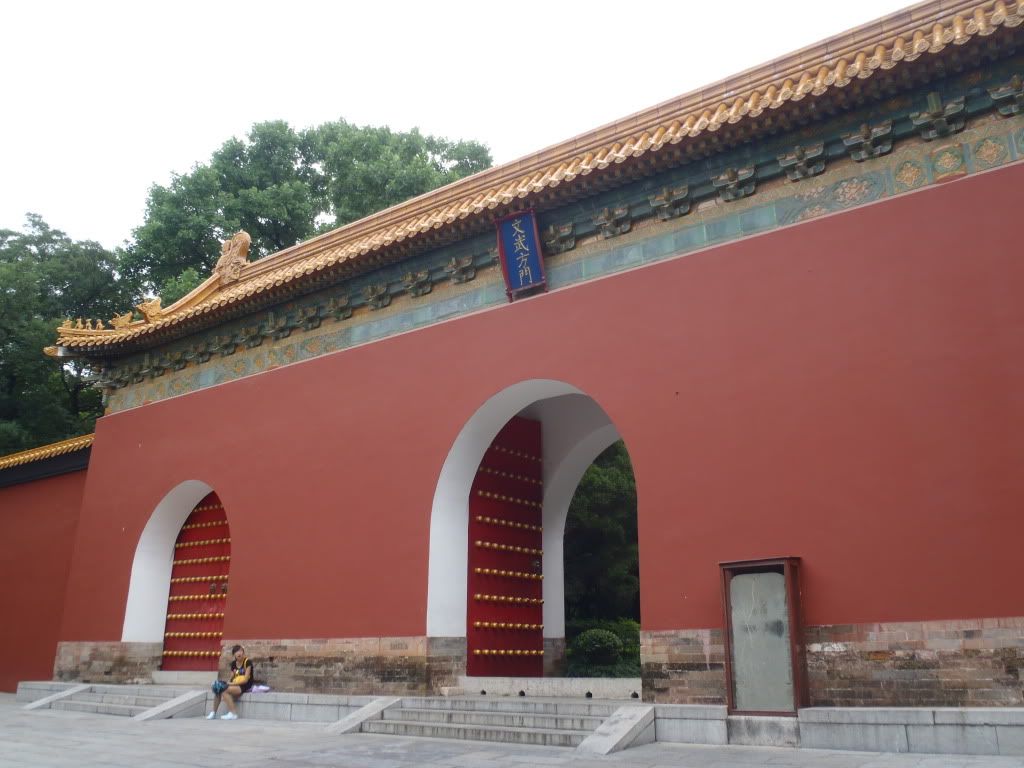

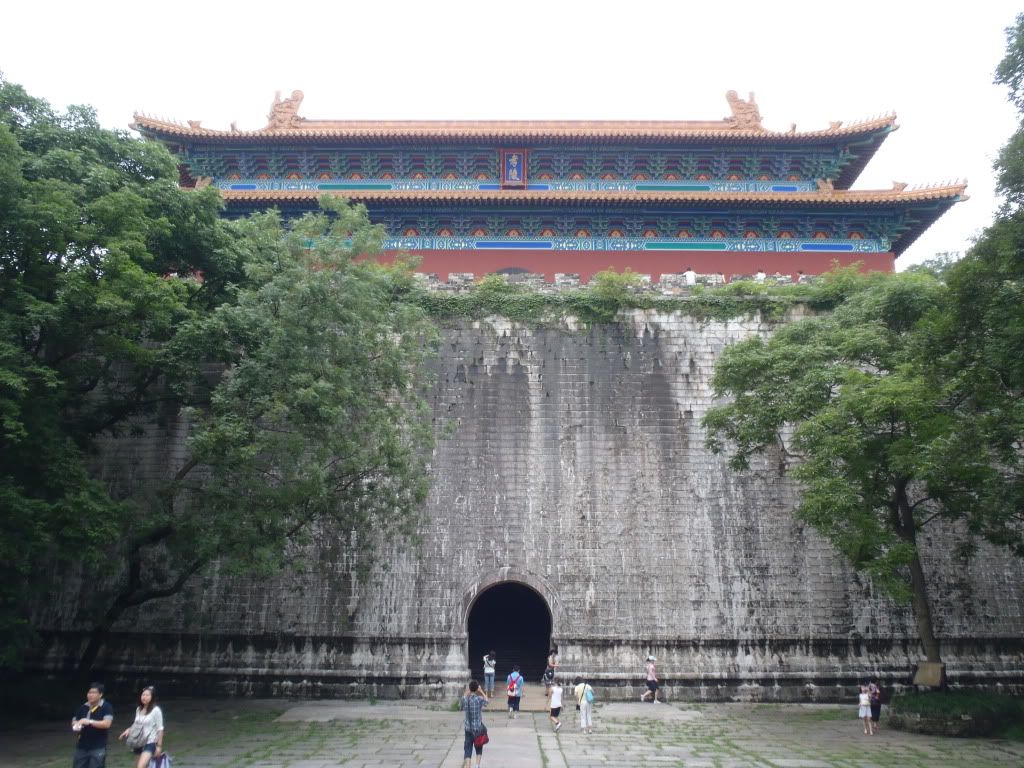
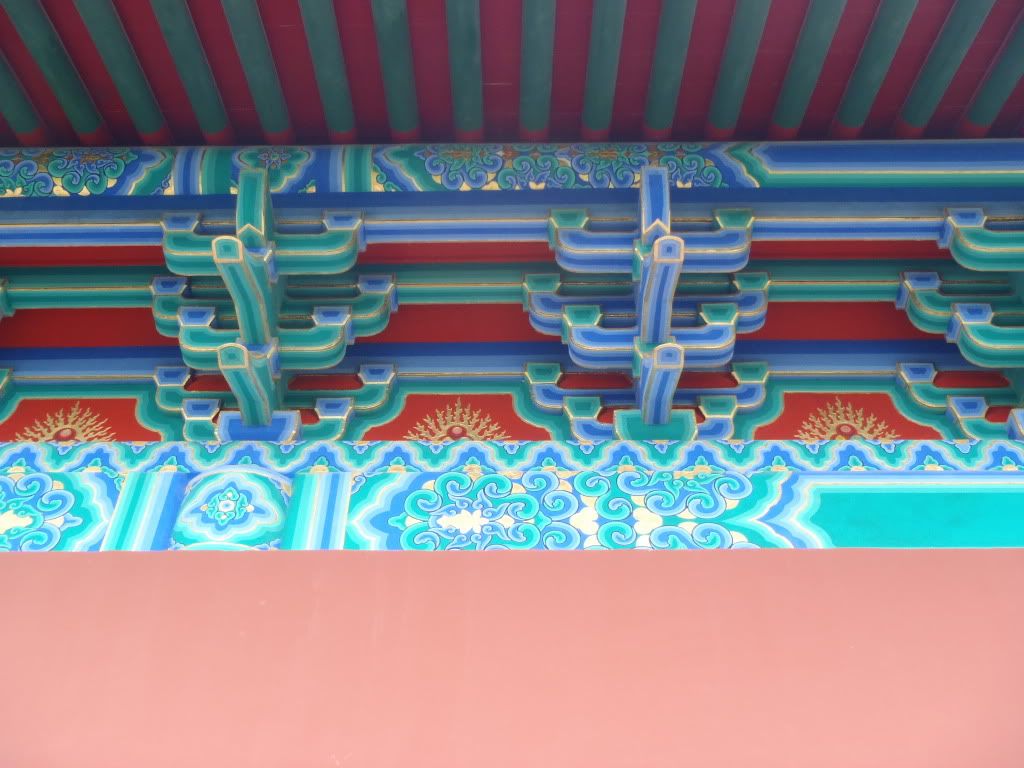

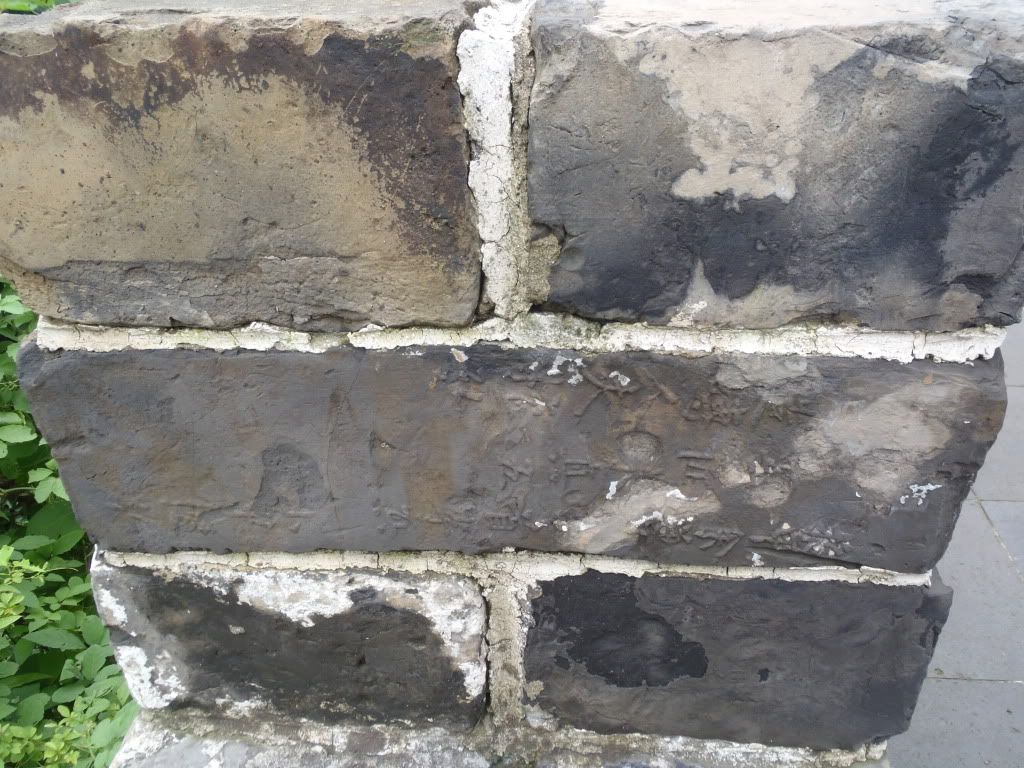
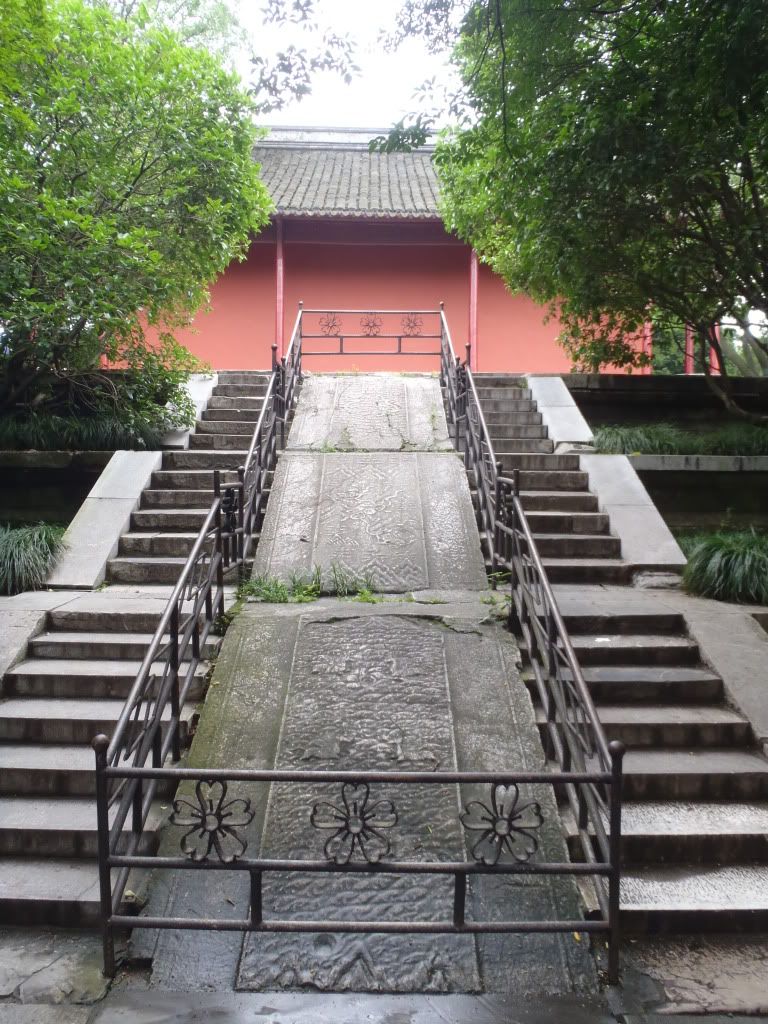
On our way back we checked the map and found out an old friend had been buried nearby. We took a little electric train to the site and got walking. Sun Yat-Sen’s Mausoleum’s construction was begun in 1926 and finished in 1929. We learnt there’d been a competition and the winning design had been a temple complex in the shape of a bell. Sadly, to realize this design the complex was built up a hill. This meant Francesca and I had a tough climb ahead of us. We made the most of the sweaty endeavor and took some pictures (and had some taken) whilst we made our way to the top. Once there we got (yet another) time line with all of Sun Yat-Sen’s amazing deeds. His ‘mausoleum’ was in fact a marble statue, even though his remains are also on site. We said our final goodbyes (hopefully!) to the good doctor and headed to the exit. Francesca spotted a colorful bug and wanted some pictures, so here’s a picture of the coolest beetle in the world.
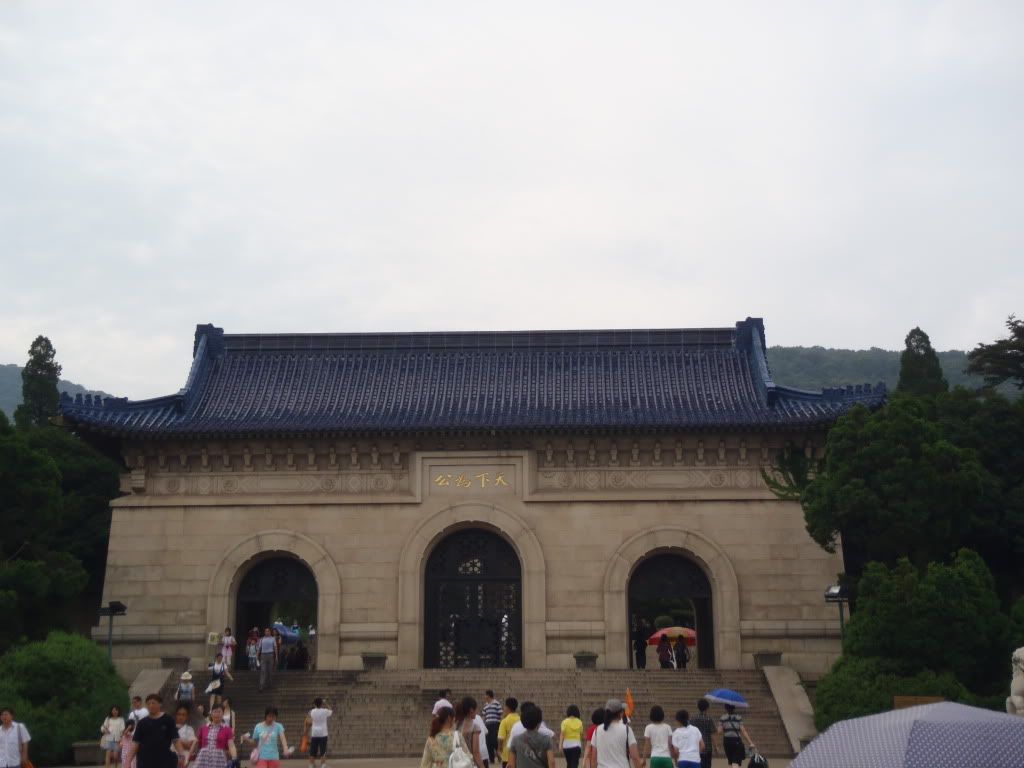
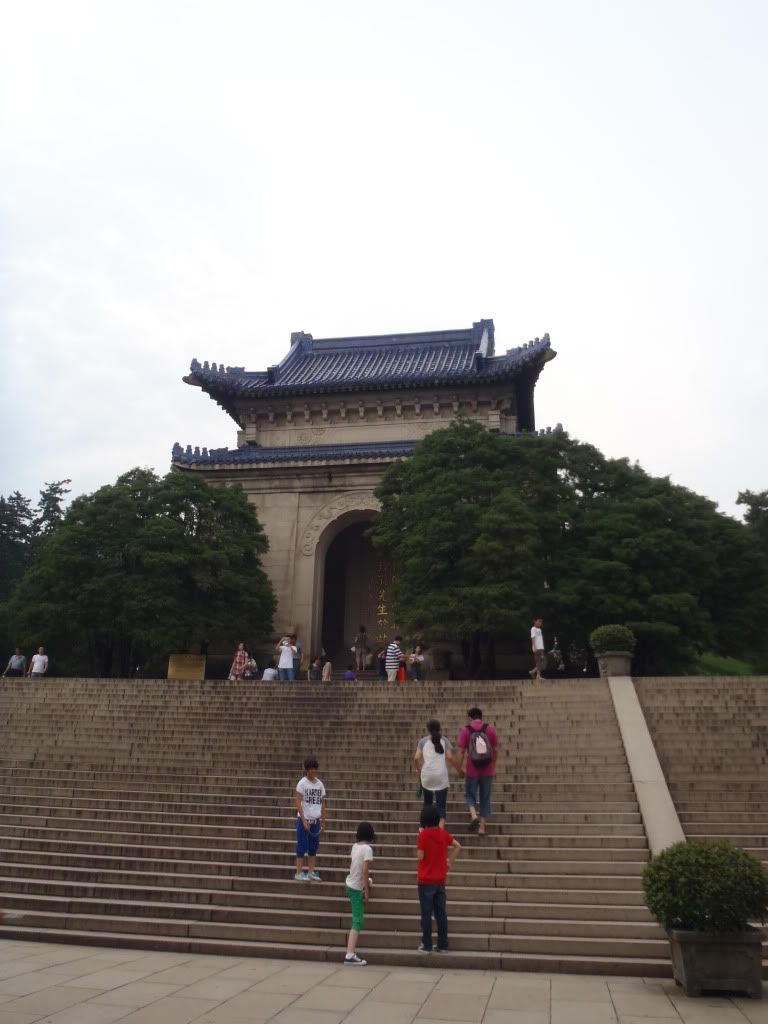
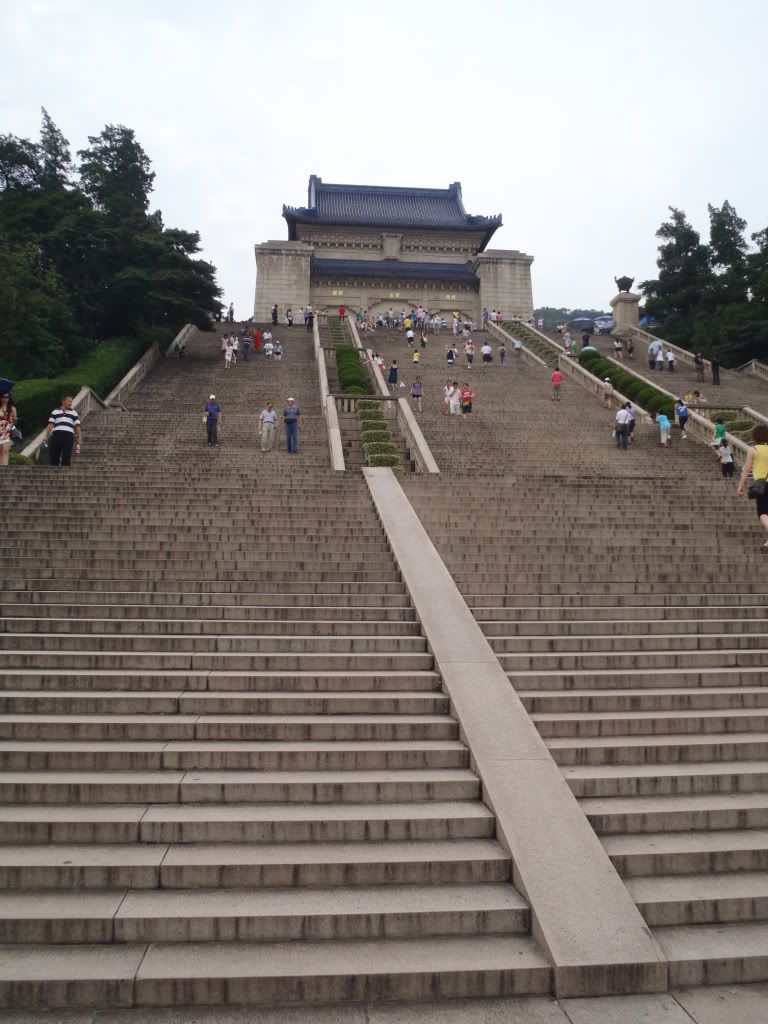
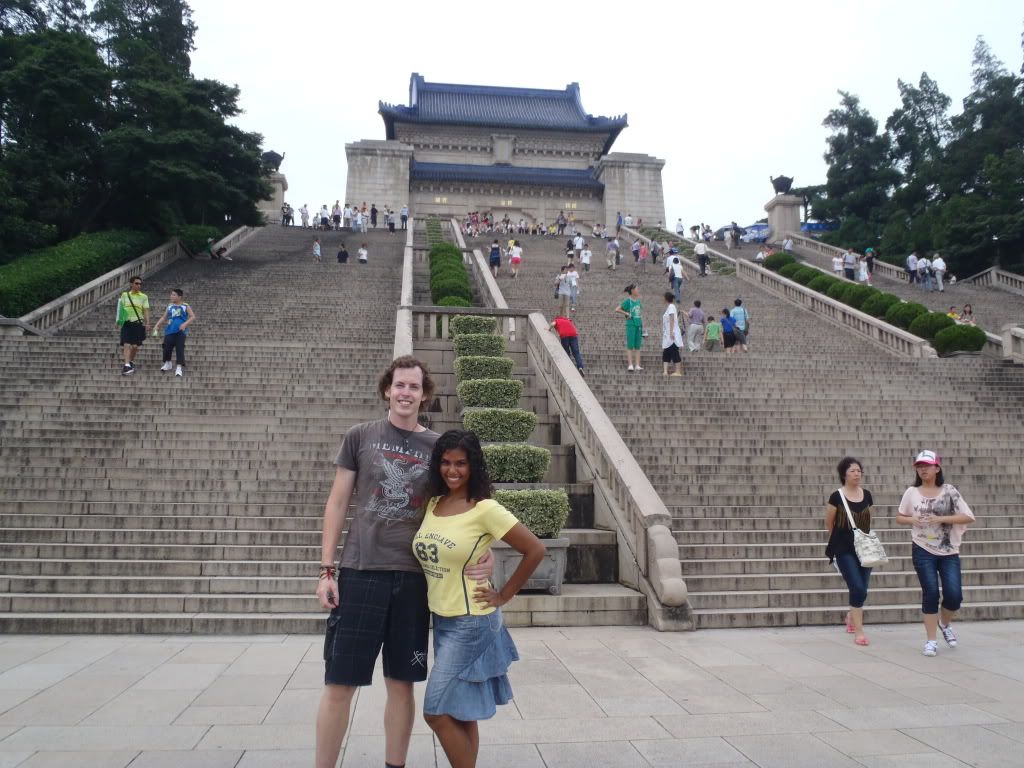
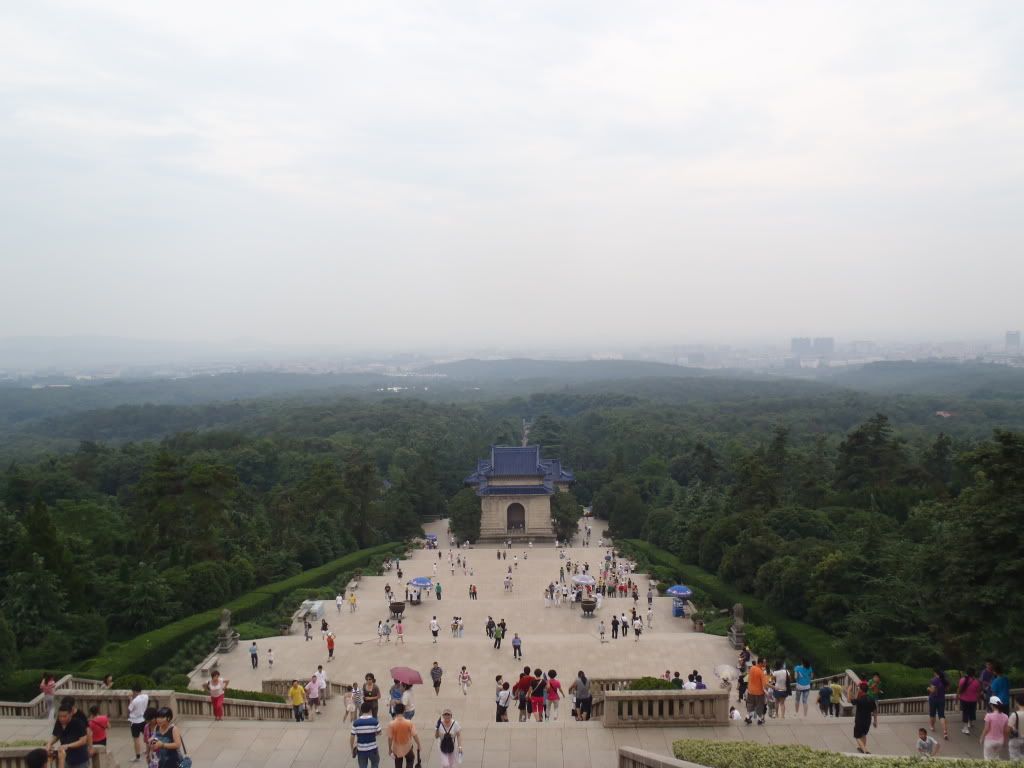
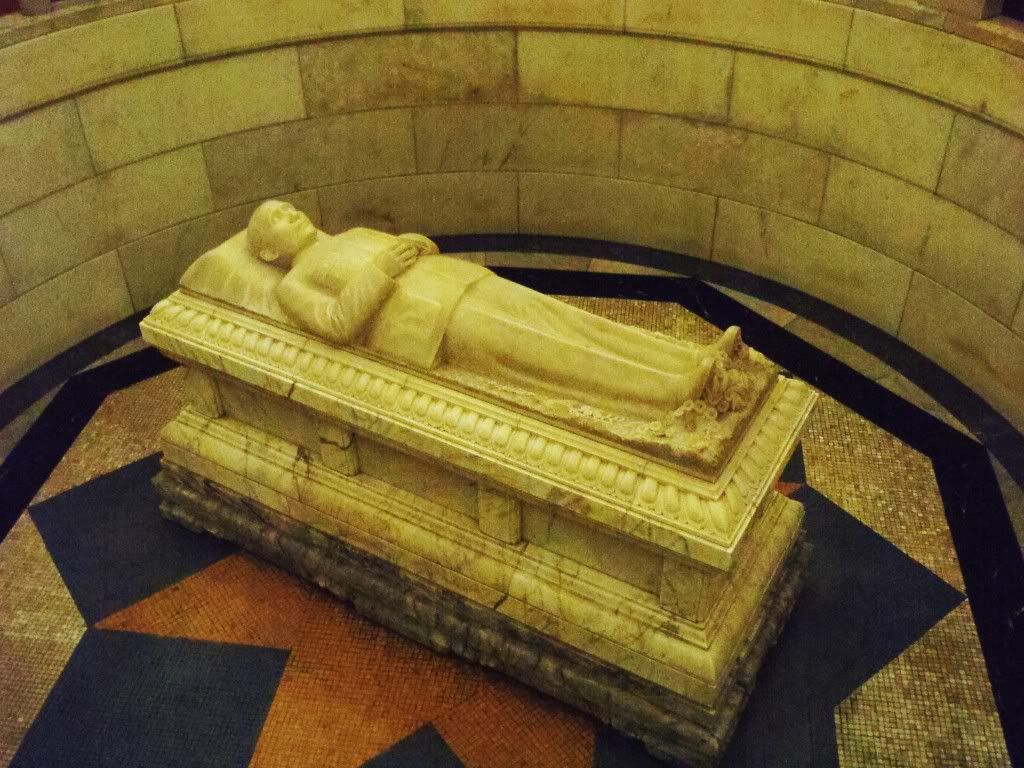
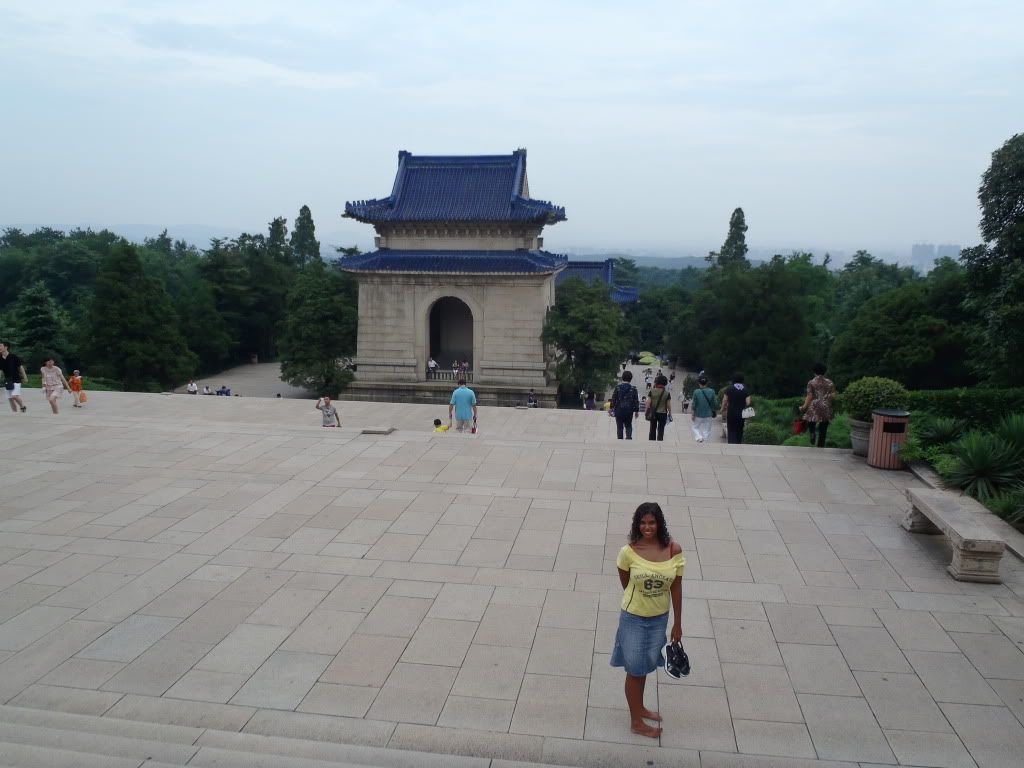
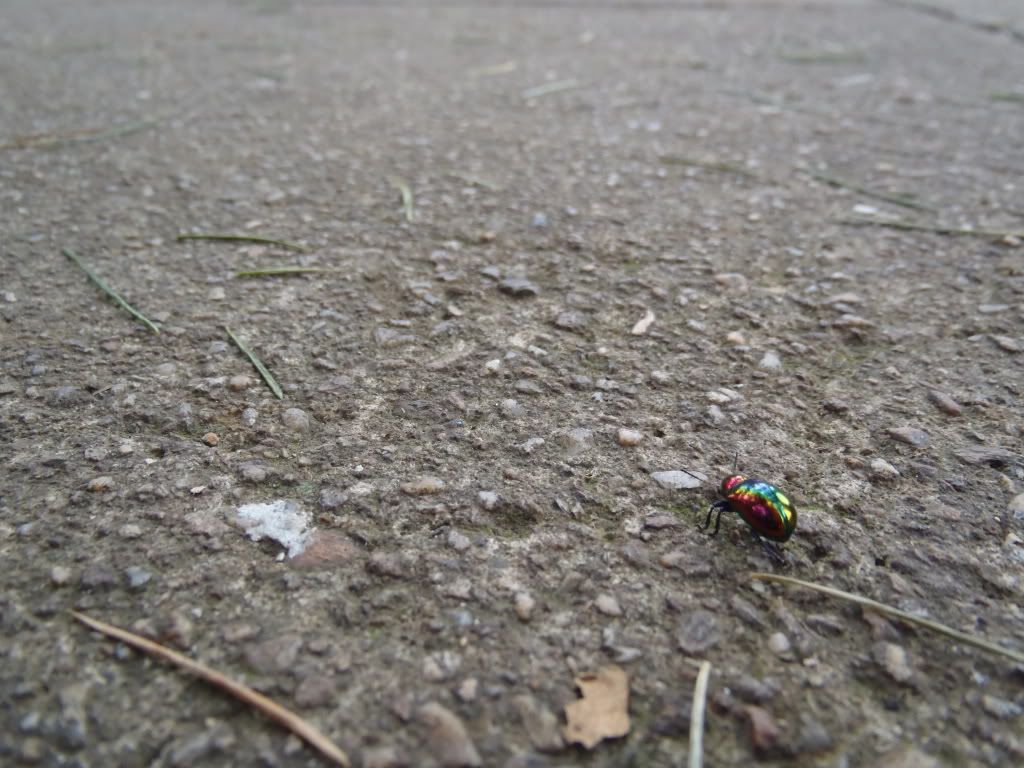
We returned to Masterland via taxi, train and taxi, just in time for another dinner with the Van der Merwes. They were making pancakes that evening and Francesca and I were both very excited to have some as well. We had a lovely meal together, after which Francesca and I sadly had to pack our bags to leave later that night. We would have loved to stay a little longer, but we had to keep moving to do our border crossing to Mongolia, whilst my birthday was also coming up. Besides, the Van der Merwes were leaving for Europe in the following days, so we decided it’d be best to move on. After the pancakes and a glass of wine I played Madagascar with little Gert and helped Beppie book some tickets for international trains in Europe. Big Gert drove us to the train station later that night. Midnight came and my birthday had started! I’ll tell you all about my birthday in my next post!

Luckily, everything worked out and we soon found ourselves comfortably sitting in the bullet train to Suzhou. It’s nice to know trains can safely reach speeds of up to 320 km/h. We arrived in Suzhou around 12:30 PM and looked for the ‘Left Luggage’ sign. It was a little difficult to find, as they’d hidden it just outside the station, but in the end we dropped our bags off and had our hands free to figure out just how to get to Tongli, our aim for that afternoon. We tried asking several people, but the information was limited and confusing. We decided not to risk it, and took a taxi to Tongli instead.
This turned out to be the right choice as the kind lady dropped us off right in front of the entrance to Tongli. Tongli, as we’d read, carried the nickname ‘The Venice of the East.’ It was described as a 1000-year-old, but well preserved water township. We had also read there were more Venices of the East in China, but a little research satisfied our curiosity and we’d ended up picking Tongli as ‘our’ Venice. We walked through the gate towards the town, where we had to buy entrance tickets (a through ticket for roughly 10 sites all around town) and chose to hire a pedi-cab, because we feared we might run out of time.

Our kind driver peddled away and soon arrived at the first sight: Gufeng Garden. The ticket allowed us to enter both the Garden and the Museum in the surrounding building. The Museum was mildly interesting, showcasing many different types of wooden and ornate beds and some carved wooden architectural features. The Garden proper was a nice sight to behold, with little pools of water and rock formations combined with lush greenery. We spent a while walking around, before returning to pedi-man who biked off with us to the next destination.




The Wang Shaoao Memorial Hall was a blatant example of propaganda for the Communist Party. Texts on the walls claimed the China Association for Promoting Democracy and the Party had always been able to work hand in hand, without any issues. Obviously, a little white lie… Other than a few texts combined with the busts of a handful of Chinese democrats, there was very little to see here.


We moved on to the Pearl Pagoda and its garden, the largest of Tongli. We learnt of the myth of Fang and Chen. Here’s a summary of a little story I found online: Fang, a young man from a rich and powerful family became poor after falling out of favor with the royal court. He had to borrow money from his aunt in Henan Province, central China, but she scornfully taunted him. Fang's elder female cousin, Chen, had a kind heart and gave him the Pearl Pagoda, which had been the family treasure for many generations, to help him to go continue his studies. Three years later, Fang attained the top grade in the imperial examination and returned home. He disguised himself as a Taoist monk and sang a satire song to mock his unkind aunt. He eventually married Chen. Now the Pearl Pagoda is the reproduction of the pagoda from the story.






Other than the pagoda, the garden had an impressively large house. The house consists of many different rooms, all connected with little open spaces. Every room has a different function, which we guessed would mean some of the inhabitants had to spend quite a while getting from the living rooms to the kitchen. We walked around and checked out most of the rooms. We ended up near a large pond, where some kids were feeding the fish in the water. The frenzy was quite spectacular.





Next up: the unimpressive Wu Garden, with a bunch of halls filled with strange art. We managed to get through the rooms, but we didn’t stay long at all. Happy Farming Hall was “… built by Ming Dynasty official Zhuxiang, also called Gengle, as a quiet retreat after a successful career in government. So pleasant was his home that he seldom left it, earning him a reputation as a hermit, albeit a hermit with a 54-room mansion to hole up in. Today, the house retains three courtyards and 41 rooms out of the original layout. The front living quarters lead to a small garden area with a lotus pool. An adjacent zigzag bridge connects to a pavilion.”



Once outside pedi-cab-man took us to Three Bridges Viewpoint. The Bridges represent good fortune and happiness and are an important part of the Tongli people’s daily lives. They’re still incorporated into daily affairs as well as special occasions, such as weddings. After that we were dropped off at The Retreat and Reflection Garden. Here’s a little more information from virtualtourist.com: “The Retreat and Reflection (Tuisi) Garden, was designed by a famous painter, Yuan Long, during 1885 and 1887 and is the most spectacular in Tongli. Its name is derived from an aphorism expressed in a very famous biography called Zuo Zhuan written by Zuo Qiuming in the Eastern Zhou period (770-221 BC): 'Forward to be fully loyal, and retreat to reflect fault'. The ingenious design for the garden conforms to the local landforms and conditions and covers about 700 square meters. Compact and harmonious, the garden is in two parts. The residential area to the west consists of an outer house and inner house including the sedan hall, the tea hall, a main reception hall and two buildings forming the actual dwelling. The garden in the east has ponds, marble boats, waterside pavilions, halls, kiosks, verandas, rockeries and bridges.”

The Garden was the nicest garden that we visited that day for sure. Unfortunately, we didn’t have much more time left since closing time was approaching and we had one more important stop we really didn’t want to miss: the Sex Culture Museum. The museum had moved from Shanghai to Tongli (for reasons unknown) in 2004. It is the first and only museum of its type in China and exhibits over 1,600 items of sex culture from as long ago as 9,000 years to the early 20th century in four parts: ‘Sex in Primitive Society,’ ‘Marriage and Women,’ ‘Sex in Daily Life,’ and ‘Unusual Sexual Behavior.’ We had a look at the rather graphic and sometimes downright bizarre statues in the little garden, before entering the first hall.




We were surprised to find a small piece of pottery dating back to roughly the 2nd century B.C. that showed people back then were just as preoccupied with sex as people today. We also learnt about Fuxi and Nuwa, the legendary ancestors of the Chinese people. Apparently, this brother and sister were also a couple, which indicates incest was considered okay around the time the statue was made (1st/2nd century B.C.).



In the following hall we read about General Wu Sangui, from Yunnan province. His army successfully defeated the Ming, but after the war ended his men had a hard time finding Han wives. To encourage the Han soldiers to marry women from minorities (which had been a social no-no up until then) he had vases made with copulating fish of different species on them. We also read about prostitution in the 17th century, when pictures were not yet available. Instead, hungry customers could pick their favorite from a set of drawings.

Sex tools were also widely present in the museum. We saw a whole variety of dildos and other items used for insertion. We learnt that many women had them, as many of them were concubines of men with harems. They wouldn’t get a lot of attention, so they had to take care of themselves. We had to hurry a little through the remainder of the museum, but we were left with a memorable quote: “Any sexual phenomenon, as long as it is ‘voluntary’ and ‘non-damaging’ (causing no damage to others and society), should be allowed to exist.” That was a refreshing statement, especially in an otherwise narrow-minded China.



Around 5:00 PM we headed back towards the entrance gate, quickly having a look at Chen Qubing’s House. The old house itself was only a little more interesting than the man’s life (he was a poet during revolutionary times) and Francesca walked around for a while to check the house out, after which we made our way to a taxi, which took us back to Suzhou’s station. We had to sit around for a while to wait for our train and took the opportunity to scrape a meal together. We bought some bread, meat-sticks, chips and drinks, as well as some insta-noodles for me, which we ate before the train arrived. Luckily the train only took one hour (bullet train!) and we arrived in Nanjing around 9:30 PM. We still had to make it to our hosts’ place, which we had written down in Pinyin. We tried in vain to get someone to write it down in Chinese, and ended up just taking a taxi, hoping they’d get it right.


The driver knew ‘Masterland,’ the gated community we had to go to, and all we had to do is talk to the guards to find the right address. I’d been looking at the hosts in Nanjing and I’d fallen in love with our new hosts’ profile, so I was really excited to finally get to their place. Outside of their place we met Gert van der Merwe, who took us inside. We quickly put our bags down in the basement and headed upstairs to meet the rest of the family: Beppie, the mother, little Gert, his big sister Aletta and their awesome cat Koos. The Van der Merwes are a South-African family that has been living in Nanjing for a few years, since Gert holds a job with Ford USA. We talked a little about our travels and adventures of the day, but it was late and everyone was tired, so we made our way back to the basement and slept like babies.
The following morning, on the 16th of July we did get to talk to the family. Beppie was going to the city and taking the kids with. She dropped us off at Andemen Station, where we took a train to the heart of the city: Xinjiekou. We wanted to look for new shoes for Francesca, because with all the rain China had turned into a slip and slide for her and her inadequate sandals. We had a look in one of the malls, but found the prices quite steep. I knew there were some shops down in the subway station, but before we headed there Francesca needed to refill her Pizzahut-tank. The personal pan cheese pizza (after trying to explain for a long time what we wanted) hit the spot and recharged her batteries. The one shoe store down in the basement had a poor collection and just when we were about to give up Francesca spotted some cool new sandals. They weren’t expensive either, so they ended up on her feet soon after.
Finally being able to walk again made all the difference! We could walk on the previously slippery stones without any problems. I got us a taxi to take us to the Nanjing Massacre Memorial Hall, a place Francesca had told me a little about. I, however, was not prepared for the wave of information about to hit me. The complex looked extremely serene and there were only a few small memorials that gave away a little about the drama that had taken place here. A giant cross commemorated the “300,000.” 300,000 what you ask? Well, the sign told us this: the cross symbolizes the fall of Nanjing on December 13th 1937. A second inscribed date says January 1938, the end of the Nanjing Massacre. Then the most shocking line of all: “The memorial has been built above the site of ‘the Mass Grave of 10,000 Corpses.’” We walked past a wall of unsettling sculptures and carvings and ended up inside a building.


If you’re not sure what this is all about, here’s what Lonely Planet has to say about the Rape of Nanjing:
“In 1937, with the Chinese Army comparatively weak and underfunded and the Japanese Army on the horizon, the invasion into and occupation of Nanjing by Japan appeared imminent. As it packed up and fled, the Chinese government encouraged the people of Nanjing to stay, saying ‘All those who have blood and breath in them must feel that they wish to be broken as jade rather than remain whole as tile.’ To reinforce this statement, the gates to the city were locked, trapping over half a million citizens inside. Nevertheless, thousands of civilians attempted to follow the government by escaping through Xiaguan Gate, the only gate in the city that remained unlocked. Leading up to the gate was 21m tunnel inside of which reigned panic and mayhem. In the resulting collisions and chaos, thousands of people were suffocated, burned or trampled to death.
What followed in Nanjing was six weeks of continuous, unfathomable victimization of civilians to an extent unwitnessed in modern warfare. During Japan’s occupation of Nanjing, between 300,000 and 400,000 Chinese civilians were killed, either in group massacres or individual murders. Within the first month, at least 20,000 women between the ages of 11 and 76 were brutally raped. Women who attempted to refuse or children who interfered were often bayoneted or shot.”
Jiangdong Gate is the exact spot where one of the mass graves was unearthed. They’ve left the skeletons in place, creating a gruesome picture of the horrors these people must have gone through. We learned that some bones were found seriously deformed, whilst others had bullet or bayonet holes. We spotted the remains of a 6-year-old with its skull resting on its chest. The autopsy revealed the head had been severed from the body before its death. Another skeleton, this time of a 9-year-old bore 3 nails, knocked into the shank, splinter bone and shoulder bone. Sometimes pictures speak louder than words, and sometimes words cover things perfectly, so here’s a few pictures and a poem we both found impressive.



Let the white bones fall into sleep
Let the grievance souls rest peacefully
Turn the slaughtering sword to the cast of a warning bell
Turn the names of the departed to be engraved in history
Let the children no longer face with the fear
Let the mother no longer shed her tears
Let war be distant from all mankind
Let peace be spread fully to the world
Even with all its Chinglish, this poem carries a very powerful message. Well done! We continued our exploration, departing temporarily from the Massacre-theme and looking at some anti-American art. Back outside we walked past some very impressive and telling sculptures. We saw one more building in the distance and found an entrance. We entered the first hall and started reading. Some guy kept coming to us, saying stuff in Mandarin and ushering towards the door… We had no idea what he wanted, but pretended to understand whilst continuing reading.



We found it a little strange the museum started with post-war happenings, such as trials for Japanese war-criminals. We also read about the way the Japanese treated the Chinese women they’d captured. One story told about Zhou Fenying, who’d been forced to become a 'comfort lady.' She explained the Japanese simply gave these women numbers, and their soldiers would be able to come in freely to have their way with them pretty much 24/7.


Another set of horrifying pictures spoke of germ-warfare victims. We both did not know the Japanese had experimented on humans in Nanjing. It became a little bit less of a surprise when we read that the Japanese had adopted a “burn all, kill all, loot all” policy. Humanity was not part of the Japanese war machine.


At this point the time line changed again and we were now reading about the end of the 18th century. Francesca and I had a good look around and noticed everybody was going in a different direction from us. We’d entered the museum through the exit! So that’s what that guy had been trying to tell us. We decided to continue going the way we had, because the museum itself didn’t have a clear time line either. We figured it’d be easy to puzzle everything together ourselves.
The Japanese had wanted to break away from Asia and wanted to join Europe. It developed quickly and the Japanese felt they could enlarge their empire. With the growth of their power and army they turned to outward expansion. Korea was the first to fall, and China came next. In 1895 the Japanese landed in North-East China and swiftly defeated the weak Chinese army and naval fleet. The loss pressed the Chinese further into a national crisis and served to strengthen the Japanese morale. The Nanjing Massacre turned out to be the culmination of the unavoidable: Japanese invasion.


About halfway through the museum we ended up looking at an enormously high wall. Extensive archives about those that died and how they came to their end were piled up here, leaving visitors with an idea of how much we’ve been able to find out about the crimes committed by the Japanese and the horrors suffered by the Chinese.


The next section became even more graphic. One picture stands out in my mind and continues to pop up as I write about this day: the head of a Chinese man, cigarette in mouth, resting on a barb-wired gate, used as a warning against any Chinese opposition.





And then there were two Japanese generals, Noda Takeshi and Mutai Toshiaki, who held a contest to see who could kill 100 people first. At one point the first guy was up to 106, whilst the second had only killed 105. They didn’t know who reached 100 first though, so they decided to set the goal at 150 instead. The rest of the museum was more of the same, but this did not bother us. It was thoroughly impressive to learn so much in one day. We had a look at a few more statues outside, grabbed a taxi and headed for the Nanjing Museum.


The driver dropped us off on the wrong side of the road, but this gave us a nice view of the old city walls. One underpass later we popped up next to the entrance of the museum. We saw construction in the distance and feared the worst. Indeed, the Nanjing Museum is under construction. Or at least, the interesting part, the history building is. On our left we spotted the other half of the museum. The ticket lady gave us some free tickets and we headed inside. Tired of ceramics, pottery, jade and other Chinese junk I let Francesca do this one on her own, whilst I sat down on a comfortable couch. She told me it was mostly repeats of everything we’d seen before, so we won’t bore you with the details. Here are some pictures to soothe your pain.



The old Ming city walls stood just a short walk away from the museum and were next on the agenda. Especially the gate stood out as one of the best remaining examples of early Ming defensive architecture. Other than the massive gate and walls we walked through the ancient courtyards, strewn with stones from parts of the wall that hadn’t survived the centuries. We were not alone, and heard several Chinese people singing their way through the park. Especially the acoustics in the gate were impressive and we stood still for a while to listen.



We left the walls behind in a bit of a hurry, since we needed to find the Post Office with its train ticket office badly. I had a map of Nanjing and knew the Chinese word for train tickets as well as post office, so I figured the cab driver would get it. Unfortunately he dropped us off at the wrong one… We still found a ticket office nearby, but the lady there seemed unwilling to help us and told us we wouldn’t be able to get tickets to Jinan or Beijing for another week. And that wasn’t really what we were looking for. In the hope of being able to make it to the main Post Office in time we took another taxi. This time the driver did understand, but we got there too late. I memorized the location and we popped into the subway to head back to Andemen station. A little hungry Francesca and I bought a Snickers and some grapes to hold us over for dinner, which we had planned with the Van der Merwes. We took a taxi back and arrived at their place around 6:30 PM.

Around 7:00 PM we were all ready and together with the rest of the family Francesca and I headed for a local food street. Beppie and Gert apparently go here more often as they knew exactly where to go, what to order and where to get drinks. We joined two tables together and sat down. Not for very long though, as Beppie led us to the ‘selection’ table, where we looked at fresh skewers of meat, seafood, vegetables and other tasty-looking things. One plate filled up rapidly, and a second one underwent the same faith. We handed the plates to the cooks who turned on the BBQ and started doing their job. It didn’t take long for the first food to arrive. For over an hour the food kept on coming, and the stack of used skewers under the table kept on growing. It was extremely interesting to listen to the Van der Merwes stories whilst we gorged on the food. It’s just wonderful to hear stories about China from someone who’s lived there for some time. It really makes the experience of a city that much better. But, back to the food: the salty bread and spicy chicken skewers were worthy of some special praise. Dessert came in the form of ice creams at the nearby KFC, after which we headed back to Masterland for a drink and more talk.







On the 17th of July Francesca and I got off to a somewhat slow start. We’d wanted to go to the Purple Mountains (guess why we were going there!), but also needed to get our train tickets. Furthermore, the Van der Merwes had given us their spare mobile phone (which we are eternally grateful for!) and we needed to get a sim-card to get it working. We first headed back to the Post Office, but found the entire top floor – where the Lonely Planet places the ticket office – closed… We did find a China Mobile shop inside though. I underwent the painful process of trying to explain in English that I wanted a sim-card for the phone, whilst Francesca dodged the bullet and looked for another ticket office instead. Lots of confusing phone calls and pointing-at-the-phone later I finally had a sim-card and a working phone.
Francesca had successfully located a ticket office, which – of course – had closed for lunch. We decided to do the same with our brains and headed for McDonald’s for some local cuisine. Francesca enjoyed a McChicken, whilst I found a cup of corn a sufficient meal. After the meal we finally managed to find an open ticket office and with a bit of help from the Lonely Planet’s glossary and a random guy in the queue next to us we managed to purchase tickets to Jinan and Beijing without any problems. Really makes you wonder why the other lady had nothing until the next week…
Anyway, it was well past 1:00 PM now and we really wanted had to get moving to see the Purple Mountains. First off, the mountains are called ‘purple’ because one can often find purple clouds hovering over the peaks. Unfortunately there were no purple clouds this day, so we in fact visited the Green Mountains. We bought pricey tickets for the first site of the day: the Ming Tombs. The Ming Tomb is the tomb of Zhu Yuanzhang, the first emperor of the Ming Dynasty. The tomb’s construction was started in 1831 and finished 32 years later.
Francesca and I admired the large stone statues leading up to the tomb, as well as several of the oversized entrance gates. The inner red gate proved to be the highlight of our walk. It’s considered the residence of the souls of the deceased. Sadly, the gate had previously fallen in a state of disrepair and lost its charm. The overzealous Chinese had tried to restore the whole thing to its original looks, but sadly went a little overboard. It looked too much like the building had come straight out of factory the day before. The view from atop the gate was impressive and certainly worth the short climb.








On our way back we checked the map and found out an old friend had been buried nearby. We took a little electric train to the site and got walking. Sun Yat-Sen’s Mausoleum’s construction was begun in 1926 and finished in 1929. We learnt there’d been a competition and the winning design had been a temple complex in the shape of a bell. Sadly, to realize this design the complex was built up a hill. This meant Francesca and I had a tough climb ahead of us. We made the most of the sweaty endeavor and took some pictures (and had some taken) whilst we made our way to the top. Once there we got (yet another) time line with all of Sun Yat-Sen’s amazing deeds. His ‘mausoleum’ was in fact a marble statue, even though his remains are also on site. We said our final goodbyes (hopefully!) to the good doctor and headed to the exit. Francesca spotted a colorful bug and wanted some pictures, so here’s a picture of the coolest beetle in the world.








We returned to Masterland via taxi, train and taxi, just in time for another dinner with the Van der Merwes. They were making pancakes that evening and Francesca and I were both very excited to have some as well. We had a lovely meal together, after which Francesca and I sadly had to pack our bags to leave later that night. We would have loved to stay a little longer, but we had to keep moving to do our border crossing to Mongolia, whilst my birthday was also coming up. Besides, the Van der Merwes were leaving for Europe in the following days, so we decided it’d be best to move on. After the pancakes and a glass of wine I played Madagascar with little Gert and helped Beppie book some tickets for international trains in Europe. Big Gert drove us to the train station later that night. Midnight came and my birthday had started! I’ll tell you all about my birthday in my next post!

0 Comments:
Post a Comment
<< Home